
- Tips & Tricks
- PowerPoint Templates
- Training Programs
- Free E-Courses

How to Summarize Presentations
Home > How To Present > How to Summarize
Does your audience seem lost during your long presentation? You can see this happening when you ask them to recall a point and they look blank.
Do they find it difficult to put your information in context?
Chances are you may not be summarizing your points frequently enough. We will see how you can summarize your presentation effectively to enhance audience retention.
Let’s start by asking a simple question:
When should you summarize your presentation?
Did I hear you saying, “Towards the end”?
Wrong! You would’ve lost your audience by then.
An effective presentation habit is to summarize at the end of every major point. It’s all the more important to do so, if your presentation is long and content-rich.
The logic behind summarizing your points:
Do you remember building a tower with playing cards when you were a child? Every time you added a new card on top, you carefully adjusted and aligned all the other cards under it. It helped you build a tall and stable tower.
The principle applies to your presentations as well. Every new point puts a strain on memory of what was covered earlier. Unless you summarize periodically, your audience can’t remember your points beyond a point (pun intended).
How to summarize your presentation in a structured way?

This simple structure allows you to refresh the memory of your audience periodically. It helps your audience to place new information in the right context. It lays the foundation for an effective ‘call to action’. Remember, the call to action and WIIFM has been set right at the start.
Example of an effective presentation summary:
A good summary is short and quick. Here is an example of a sales presentation summary:
“I understood that your main requirements in choosing a home loan are – interest rates, long tenure and high loan amount. So far, we saw how our scheme offers you a highly competitive rate and the longest tenure for your age. Now, we’ll talk about loan amount.”
This summary gives you a chance to showcase your main benefits over and over again- in a reassuring way. It maximizes your opportunity to win business in a sales presentation.
Some creative ways to summarize your presentations:
Here are 3 creative ways to summarize your presentations.
1. Use a quiz format to summarize a training presentation:
There can be many variations to this. Some presenters choose to show just the title and ask the participants to recollect the content. Some choose to use fill in the blanks format or true/false format to test the memory. Whichever way you choose, summarize your training presentations frequently.
We have found Quizzes to be an extremely effective way to summarize in a training. That is why we put together 45 different types of PowerPoint Quiz templates in a pack. Just select the type of quiz and add your questions. You can find out more about the Quiz pack and download it here:
2. Use a mid-session Q & A to summarize your business presentation:
We’ve seen presenters disguise their summary like – “We’ve covered Point A, Point B, and Point C – are there any questions in what we’ve covered so far?”
This helps them recollect their main benefits without sounding repetitive or pushy.
3. Repeat some key images and terms from earlier points to serve as memory hook:
Repeating images and key terms on your slides help you recount your points automatically. So, constantly referring to your earlier segments is a useful practice.
Finally, to summarize this article on ‘How to Summarize’ your presentation…
- Summarize at the end of every major point.
- Use your agenda slide to serve as guidepost.
- Let your summary be quick and short
- Explore creative ways to recall your key points
Return to: How to Present Main Page
Return to Top of How to Summarize Page
Share these tips & tutorials
Get 25 creative powerpoint ideas mini course & members-only tips & offers. sign up for free below:.
How to Summarize a PowerPoint Presentation: A Step-by-Step Guide
Summarizing a PowerPoint presentation is a skill that can come in handy in various situations. Maybe you’ve just watched a colleague’s presentation and need to report back to your team, or perhaps you’re studying for an exam and want to condense the material. To summarize a PowerPoint effectively, you’ll need to identify the key points, understand the presentation’s purpose, and distill the information into a concise format. By mastering these steps, you’ll be able to communicate the essence of any presentation to your audience efficiently.
Once you’ve summarized the PowerPoint presentation, you’ll have a handy reference that captures the main ideas and supporting details without the fluff. This summary can serve as a study aid, a quick refresher, or a tool to brief others who may not have the time to go through the entire presentation.
Introduction
Let’s face it, sitting through a lengthy PowerPoint presentation can sometimes feel like a chore, especially when all you need are the highlights. Maybe you’re a busy professional with back-to-back meetings, a student juggling multiple assignments, or just someone who values efficiency. Whatever the case, being able to summarize a PowerPoint presentation is a valuable skill that can save you time and keep you informed.
Why is this ability so important? For starters, it helps you to quickly sift through information and focus on what’s essential. In our fast-paced world, time is of the essence, and being able to distill a lengthy presentation into a few key points can be a game-changer. Moreover, it’s not only about personal convenience; summarizing skills are crucial when you have to convey the gist of a presentation to others. Whether you’re briefing a colleague, preparing notes for a study group, or delivering a report to a client, a well-crafted summary can make all the difference. So, let’s dive into the how-to of summarizing a PowerPoint presentation, shall we?
Step by Step Tutorial: How to Summarize a PowerPoint Presentation
Before we jump into the steps, let’s establish what we’re aiming for. A good summary of a PowerPoint presentation should capture the main ideas, the supporting details, and the presenter’s intended message, all while being brief and easy to understand.
Step 1: Review the Entire Presentation
Start by going through the entire PowerPoint presentation.
Reviewing the presentation in its entirety allows you to get a sense of the overall flow and the key themes. Pay attention to the title slides and the concluding slides, as they often contain the main message and summary points.
Step 2: Identify the Key Points
Look for the main ideas in each slide.
Each slide usually focuses on a single main idea. Look for bullet points, bolded text, or headings as clues to what the presenter considers important. Make note of these points as they will form the backbone of your summary.
Step 3: Understand the Purpose
Determine the purpose of the presentation.
Understanding why the presentation was created helps to frame your summary. Was it to inform, persuade, or instruct? Knowing the intent will guide you in deciding what details are crucial for your summary.
Step 4: Condense the Information
- Condense the information into a concise format.
Now that you have the key points and the purpose, start writing your summary. Aim to express the ideas as simply and clearly as possible, without losing the original meaning. If a slide’s content can be said in one sentence instead of three, do it.
Step 5: Review and Edit
Review your summary and refine it.
Go through your summary to ensure it’s coherent and that it accurately reflects the presentation’s content and purpose. Edit out any redundancies or unclear statements.
| Benefit | Explanation |
|---|---|
| Saves Time | Summarizing a presentation can significantly cut down the time required to understand its content, freeing up valuable time for other tasks. |
| Enhances Understanding | By focusing on the main points, a summary helps to clarify the presentation’s message, making it easier to grasp and remember. |
| Improves Communication | Summaries can be shared with others, providing a quick and efficient way to convey the presentation’s key information without overwhelming them with details. |
| Drawback | Explanation |
|---|---|
| Potential for Oversimplification | Summing up complex presentations may result in oversimplified summaries that omit crucial nuances or context. |
| Risk of Misinterpretation | The act of summarizing involves interpretation, which carries a risk of misrepresenting the presenter’s original intent or meaning. |
| Dependent on Note-Taker’s Skill | The quality of a summary largely depends on the summarizer’s ability to discern and articulate the main points effectively. |
Additional Information
When summarizing a PowerPoint presentation, it’s essential to keep the audience in mind. Who will be reading your summary? What do they need to know? Tailoring the summary to the needs of your audience can make it more effective. Additionally, consider using visual aids from the original presentation, such as charts or graphs, if they help illustrate a point more clearly.
Remember, a good summary is not just a list of points but a coherent mini-version of the presentation. It should flow logically and be engaging to read. Lastly, practice makes perfect. The more you practice summarizing presentations, the better you’ll become at capturing the essence of the content. So next time you sit through a PowerPoint, why not give it a try?
- Review the entire PowerPoint presentation.
- Identify the key points in each slide.
- Understand the purpose of the presentation.
- Review and edit your summary.
Frequently Asked Questions
What if the powerpoint presentation is very long.
Start by breaking it down into sections, and summarize each section before attempting to summarize the whole presentation. This will make the task more manageable.
Can I include quotes from the presentation in my summary?
Yes, but use them sparingly and only if they emphasize a key point effectively.
Should I use the same slide titles in my summary?
You can, but it’s not necessary. The aim is to capture the main ideas, not to replicate the presentation’s structure.
Is it okay to leave out examples used in the presentation?
If the examples are used to illustrate key points, briefly mention them. Otherwise, focus on the main ideas and leave out specific examples.
How long should my summary be?
There’s no one-size-fits-all answer, but a good rule of thumb is to make it as brief as possible while still covering all key points.
Summarizing a PowerPoint presentation is an art and a skill that can be honed with practice. Whether you’re a student, a professional, or simply someone who values brevity, being able to condense information efficiently is incredibly valuable. Remember, the goal is to capture the essence of the presentation, not to replicate it.
Use your judgment to determine what’s essential and what can be left out. With the steps and tips outlined in this article, you’re well on your way to becoming an expert summarizer. So next time you’re faced with a lengthy presentation, don’t despair. Embrace the challenge and flex those summarizing muscles!

Matthew Burleigh has been writing tech tutorials since 2008. His writing has appeared on dozens of different websites and been read over 50 million times.
After receiving his Bachelor’s and Master’s degrees in Computer Science he spent several years working in IT management for small businesses. However, he now works full time writing content online and creating websites.
His main writing topics include iPhones, Microsoft Office, Google Apps, Android, and Photoshop, but he has also written about many other tech topics as well.
Read his full bio here.
Share this:
Join our free newsletter.
Featured guides and deals
You may opt out at any time. Read our Privacy Policy
Related posts:
- How to Set Time for Slides in Powerpoint
- How to Save Powerpoint as PDF with Notes
- How to Add Page Numbers in Powerpoint 2010
- How to Loop a Slideshow on Powerpoint 2013
- How to Delete a Slide in Powerpoint 2010
- How to Unhide a Slide in Powerpoint 2013
- How to End Powerpoint on Last Slide in Powerpoint 2010
- How to Hide a Slide in Powerpoint 2010
- How to Make a Powerpoint Slide Vertical in Powerpoint 2013
- How to Rotate a Slide in PowerPoint: A Step-by-Step Guide
- How to Change Hyperlink Color in Powerpoint 2010 (An Easy 5 Step Guide)
- How Is Microsoft PowerPoint Used in Business: A Comprehensive Guide
- How to Drag Slides From One PowerPoint to Another: A Step-by-Step Guide
- How to Duplicate a Slide in Powerpoint 2010
- How to Insert Slides from Another Presentation in Powerpoint 2010
- How to Copy a PowerPoint to a New PowerPoint: A Step-by-Step Guide
- How to: Effortlessly Create PowerPoint Looping Presentations
- How to Embed a GIF in PowerPoint: A Step-by-Step Guide
- How to Insert Clipart in PowerPoint: A Step-by-Step Guide
- How to Hide a Selected Slide in Powerpoint 2013
5 Tips to Help You Write the Most Amazing Presentation Summary
Before we delve into the article, I want you to imagine a conference room filled with eager attendees waiting for the company’s marketing executive to deliver a presentation . Armed with an array of data, the executive steps up to the podium to present the latest market analysis. The audience listens attentively, jots down notes, and absorbs the wealth of information being presented.
As the presentation draws to a close, the executive concludes with a dynamic summary. She highlights the top trends and reiterates the strategies to gain a competitive edge. She runs a recap of the critical data points, showcasing the impressive growth achieved in the previous quarter and the ambitious targets set for the following year. The audience, now fully engaged, feels a sense of excitement about the company’s prospects and leaves with a stunning impression.
Thus, the summary plays an extremely crucial role in solidifying the impact of the presentation and empowering the audience to retain and act upon the information presented. By providing a condensed and memorable snapshot of the presentation’s main points, the summary becomes a valuable resource that extends the presentation’s influence beyond the confines of the conference room.
A well-crafted summary presents the information coherently and logically, ensuring that the main concepts are effectively conveyed. It allows the audience to quickly review their understanding of the material, making it an invaluable tool for retaining and applying the knowledge shared during the presentation.
Here are some tips to help you craft a mind-blowing presentation summary.
1. Begin by Summarizing the Key Takeaways
The purpose of a presentation summary is to deliver the message clearly and reinforce ideas in the audience’s minds. But before you begin to write it, start by answering a few questions-
- What is the central theme of my presentation?
- What are the problems and threats that I am addressing?
- Can I talk about the causes and underlying issues?
- Are there any potential solutions that I can include?
- What does my audience expect to learn from this presentation?
Let us understand with the help of an example. Consider you’re delivering a presentation about your Business Plan. The entire presentation includes critical information such as details about the competitors, prospects of growth, market analysis, case studies, etc. However, to sum it up and make an impact on your investors, you must conclude it in a single slide and mesmerize your stakeholders. But how can you sum up a dozen slides and fit them into one?
Well, begin by answering the questions above, and you will realize that half of your summary is already done. You can then tailor the material accordingly and use a pre-designed Executive Summary template to communicate the same effectively.
2. Use Graphs and Charts to Showcase Numbers
If you want to increase the impact of your summary, you must incorporate visuals such as graphs and charts, as they provide a clear and concise way to present complex numerical data. Instead of overwhelming the audience with rows of numbers and statistics, these graphical elements convert the information into easily digestible visuals. They enable viewers to grasp critical insights at a glance, enhancing their retention.
By visually illustrating trends, patterns, and comparisons, graphical elements can bring the numbers to life and add a compelling narrative to the presentation. When used strategically, they can emphasize key points, highlight significant findings, and back your arguments.
For instance, if you want to showcase the comparison of your project’s increasing revenue over different quarters, you can use a bar graph. It will make the information much more pleasing to look at, and rather than having to fathom through digits of numbers, the graph can show the audience an upward trend in the blink of an eye and prove your point.
3. Include Roadmaps and Timeline to Showcase Milestones
Roadmaps and timelines offer a structured and organized representation of the project’s or plan’s progress over time. They provide a precise visual sequence of events, milestones, and goals, enabling the audience to comprehend the project’s development at a glance. This visual clarity helps the audience stay on track and follow the presentation’s flow, making it easier to grasp the project’s scope, timeline, and major achievements.
They serve as excellent tools for setting expectations and managing stakeholders’ understanding of the project’s timeline and progress. By displaying key milestones and expected completion dates, these visuals enable stakeholders to see the project’s trajectory and better align their expectations with the proposed timeline. This helps avoid misunderstandings and facilitates effective communication between the presenter and the audience.
They transform abstract concepts and ideas into a tangible and relatable story by visually showcasing the journey from the project’s inception to its anticipated completion. This engagement is particularly crucial in presentations involving long-term planning or complex processes. Such use of visuals inspires and motivates the audience to be invested in the project’s success.
4. Harness the Power of Icons and Illustrations
Summaries are quite tedious when they are overloaded with information. Rather than using separate texts for each element, it is much better to harness the power of self-explanatory illustrations and icons . They can inject creativity and personality into the slides, and a touch of artistry can make the content more engaging and relatable.
One of the most important factors is that visuals have a universal language that transcends linguistic differences, making them particularly valuable in presentations with an international or diverse audience . While text-heavy slides may pose challenges for non-native speakers or those unfamiliar with technical terms, icons and illustrations can bridge the gap and ensure that the main points are communicated effectively.
This inclusivity allows the presentation summary to reach a broader audience and ensures that the message is accessible and comprehensible to everyone.
For instance, if you want to talk about the details of a board meeting in your summary slide, you can use an expert-designed template and add a touch of life to your slides instead of writing every point and detail. This template includes all necessary details, such as the meeting agenda, time, goals, location, etc., and can be used to make your presentation inclusive and stand apart.
Such visually pleasing illustrations can help break chains of monotony and reduce clutter. They also improve the audience’s comprehension by serving as visual anchors for specific points, helping them quickly identify key topics and understand the relationships between different elements.
5. Include a Compelling Call to Action
A compelling call to action at the end of your presentation summary is crucial in motivating your audience to take the desired next steps. To ensure effectiveness, it’s essential to be specific and concrete, leaving no room for ambiguity.
Clearly state what you want your audience to do, whether it’s signing up for a service, scheduling a meeting, making a purchase, or investing in a project. Emphasizing the benefits of taking action is equally important, as it helps your audience understand how it will positively impact them or solve their problems. By presenting a persuasive case for the value they’ll gain, you increase the likelihood of a positive response.
Additionally, instilling a sense of urgency can prompt immediate action. Mentioning limited-time offers, upcoming deadlines, or time-sensitive elements related to your presentation encourages your audience to act promptly.
Providing clear and accessible contact information facilitates the follow-up process, boosting your audience’s confidence in taking the desired action. Including a strong closing statement that reiterates the main message and connects it back to the call to action leaves a lasting impression and reinforces the significance of the action you’re proposing.
Lastly, confidently and enthusiastically delivering your call to action makes your audience more receptive and eager to embrace the proposed action. A well-crafted call to action turns your presentation from a passive experience into an active and transformative one, yielding positive results for you and your audience.
A presentation summary is a valuable asset that every presenter must use. Not only does it maintain a flow of thoughts and connects the dots between multiple topics, but it also keeps the audience engaged .
By crafting a concise and well-structured summary, presenters can ensure that the main concepts and takeaways remain at the forefront of the audience’s minds long after the presentation.
Leave a Response Cancel reply
Save my name, email, and website in this browser for the next time I comment.
Please enter an answer in digits: one × 1 =
Ashish Arora
You might also like.
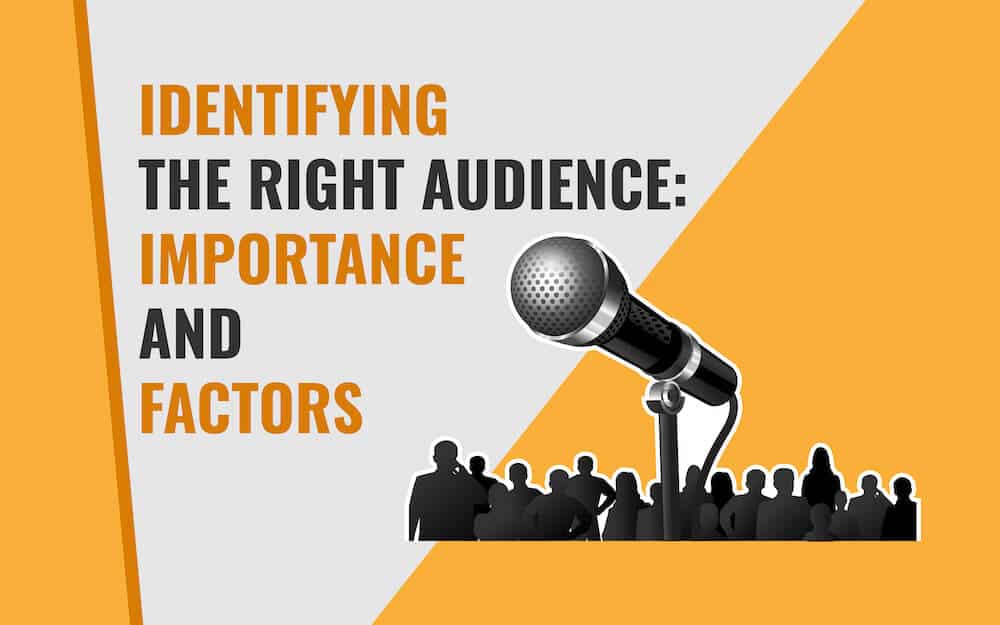
Essential Tips to Find the Right Audience for Your Next Presentation
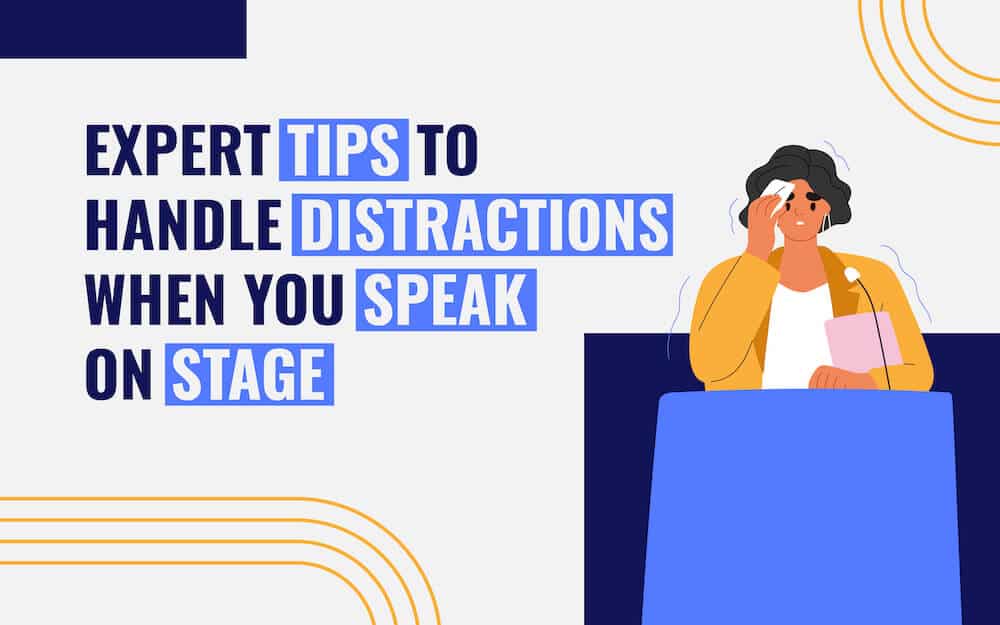
Expert Tips to Handle Distractions When You Speak on Stage

9 Tips to Craft the Perfect Title for Your Next PowerPoint Presentation

Unleash the Power of Agile Communication in the Fast-Changing Digital Realm
Home Blog Business Executive Summary: A Guide to Writing and Presentation
Executive Summary: A Guide to Writing and Presentation
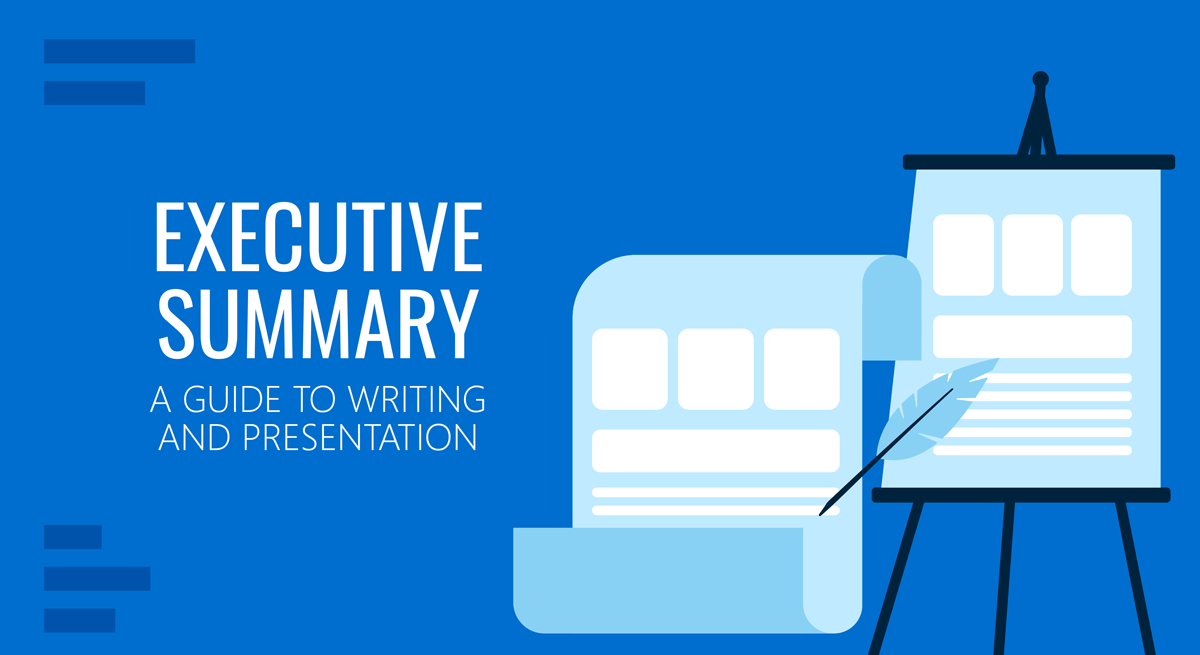
Executive summaries precede nearly every type of business document. Despite being the shortest part, they often leave the biggest impression on the reader. Yet, many writers choose to treat an executive summary as an afterthought. (And some presenters too!). Why? Because writing an executive summary is a seemingly hard task. But our mission is to prove otherwise!
What is an Executive Summary?
An executive summary is a preface to a larger business document such as an annual report, business plan, or whitepaper, succinctly summarizing the key discussion points. Effectively, an executive summary offers a preview of the content, so that the reader could form a baseline opinion about the contents prior to diving into a deep reading session.
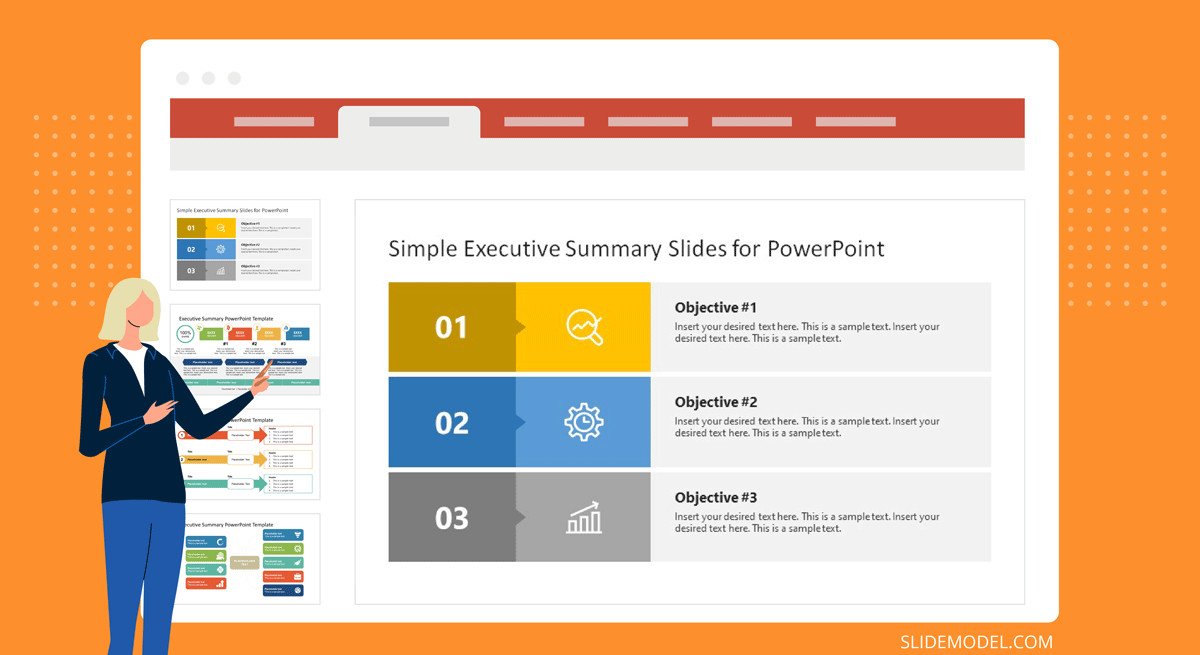
The University of Arizona offers a more elaborated executive summary definition which also notes that an executive summary should:
- Restate the purpose of the follow-up document
- Highlight the key discussion points and most notable facts
- Relay any notable results, conclusions, or recommendations
Though an executive summary is just a foreword to a bigger report, it’s one of the most labor-intensive items as you have to condense a lot of information into a high-level summary. Oftentimes, an executive summary also gets prominent placement in the follow-up presentation, done on the report.
Executive Summary Examples
Nearly every type of business document will have an executive summary. Some are better structured and presented than others. But it’s not just limited to business documents. Executive summaries are also used in scientific projects, articles, and education. Below are several admirable executive summary examples you may want to use as an inspiration for writing.
Accenture: Gaming: The Next Super Platform
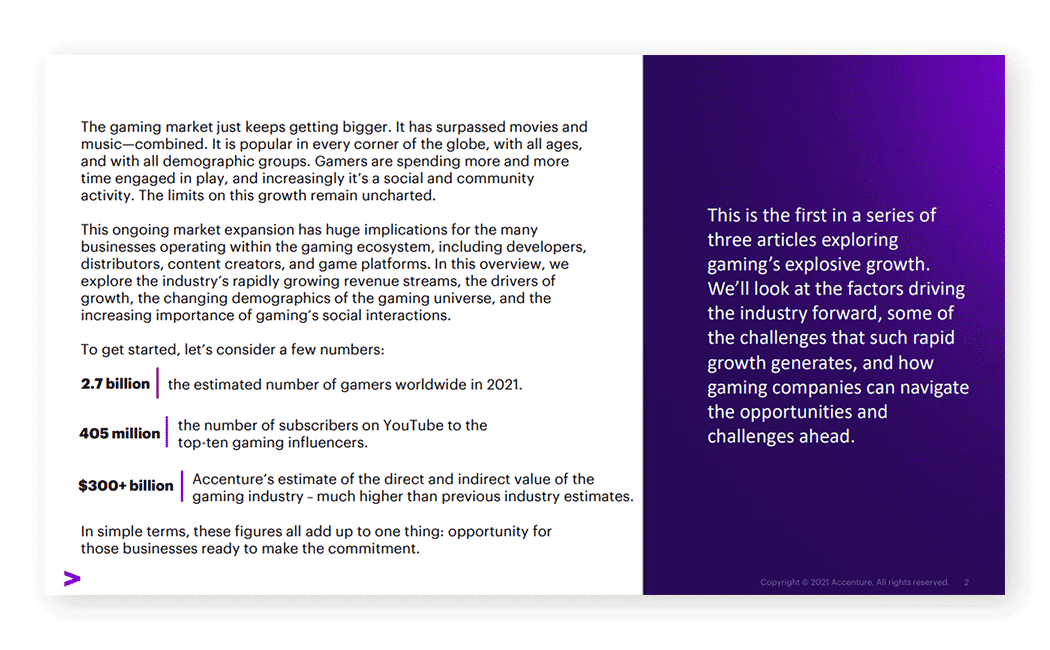
This executive summary for an industry report opens with some big quantifiable claims, clearly communicating the main agenda — describing the size and state of the global gaming market. The gaming industry is a huge market. The pullout texts on the sidebar further detail the scope of the document. Plus clarify for whom this report is intended.
IBM: Cost of a Data Breach Report 2020

IBM conducts an annual joint report on cybersecurity with Ponemon Institute. They open the executive summary with a brief recap of their mission and past research. Then dwell on this year’s findings and methodology. If you are writing an executive summary for a similarly massive original research, it’s worth focusing more on your techniques for obtaining data and arriving at the conclusions as IBM did.
Deloitte Digital: Exploring the value of emotion-driven engagement

Deloitte selected a more narrative style for this executive summary, mixing some key data points and methodology with the core messaging of the report. This is a good example of structured data presentation . On one hand, you have an engaging narration flow. On the other, the summary covers all the important discussion points.
Executive Summary Format
As the above executive summary examples illustrated, there is no one fit-it-all format for writing an executive study. The best approach depends on your report type, purpose, and contents.
That being said, an executive summary needs to fulfill several earlier mentioned criteria — offer a preview, provide key information at glance, showcase any results, recommendations. That’s what most readers expect to see on the first page after all.
The easiest way to approach writing is to draft a preliminary executive summary outline featuring the following subsections:
- General introduction, explaining the key problems discussed
- Main problem statement(s)
- Selected findings or recommendations
- The importance of discussed points
Since you’d also be likely working on presenting the executive summary to other stakeholders , it helps you keep the above structured as bullet points at first. So that you could easily transfer the main ideas to your executive summary PowerPoint slide .
How Long Should an Executive Summary Be?
As a rule of thumb, an executive summary should not go longer than one vertical page. That is an equivalent of 300-500 words, depending on the typeface. For longer reports, two pages (a horizontal split) may be acceptable. But remember, brevity is key. You are working on a trailer for a movie (the full report).
How to Write an Executive Summary: a 3-Step Framework
You can start with the aforementioned loose format and then adapt it to your document type. Remember, you don’t need to follow all the recommendations to a T. Instead, mix some ideas to make your executive summary sound both professional and engaging. Here are several tips for that:
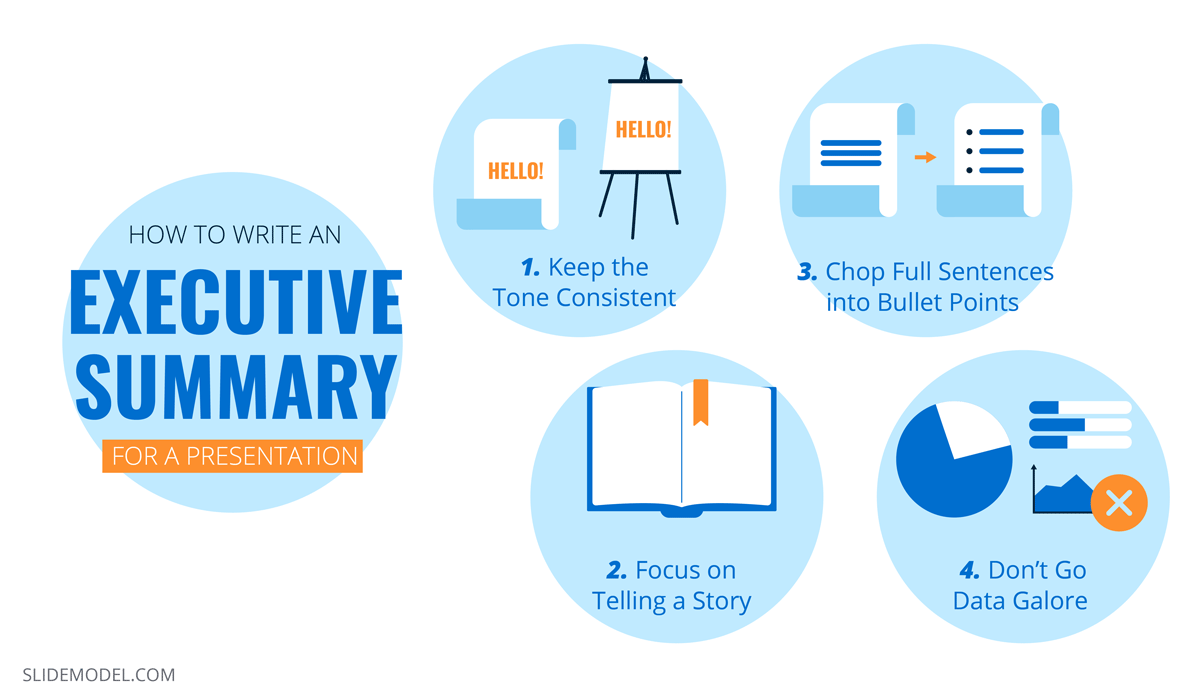
1. Start with a Problem Statement
Think of the first paragraph as if of an opening slide for a presentation : you need to make a big compelling statement that immediately communicates your agenda. Set the scene for the reader. There are several ways to do so:
- Answer the “why now” question in the opening paragraph
- Address the urgency of the matter
- Highlight the importance of the discussed issue
Alternatively, you can also go for a more traditional opening and explain the background of the research and discussed issue. For example, if you have conducted a go-to-market strategy evaluation for the team you can start by saying that “This report analyzed online furniture brand performance in 5 target EMEA markets in terms of market share, local brand recall, brand preference, and estimated online sales volumes.” Afterward, briefly communicate the main aim of the report.
2. Present the Main Discussion Points
Next, flesh out what’s included in the scope of this report to properly manage the reader’s expectations. You can use the report’s section subheads as key discussion points or come up with snappier, more descriptive statements.
Here are several good writing practices to follow:
- Use bullet points and numbered lists to break down text blocks.
- Quantify the biggest findings when possible. Style them as “call-outs”.
- Mention the limitations of your report and what it does not account for.
- Discuss the used research methods and data sources.
Finally, summarize the findings in one concluding paragraph if you have space. Or style it as a featured quote to draw the reader’s eye towards crucial information.
3. List the Recommendations or Next Steps
The bottom part of the page, around 100-150 words should be allocated towards underlining the results, conclusions, and follow-up action expected from the reader. Summarize what you have found during the course of your research. Mention if you have identified any specific type of solution or a type of recommended action.
Once you are done, send over an executive summary draft to a team member who hasn’t seen the complete report. Ask for their feedback. Can they tell what the report content is after reading the summary? Does the summary intrigue them? Is it descriptive enough for someone without any other context into the matter? Use the critique to further improve the document.

How to Prepare an Executive Summary Presentation
High chances are that you’ll also be asked to write the copy for the executive summary presentation, and perhaps even design it too. So let’s get you up to speed on this aspect as well.
How Does an Executive Summary Slide Look Like in PPT?
There’s no ultimate look for an executive summary slide as most presenters customize it to best reflect the content they’d want to showcase. But if you want some universal example, here’s our executive summary slide template :
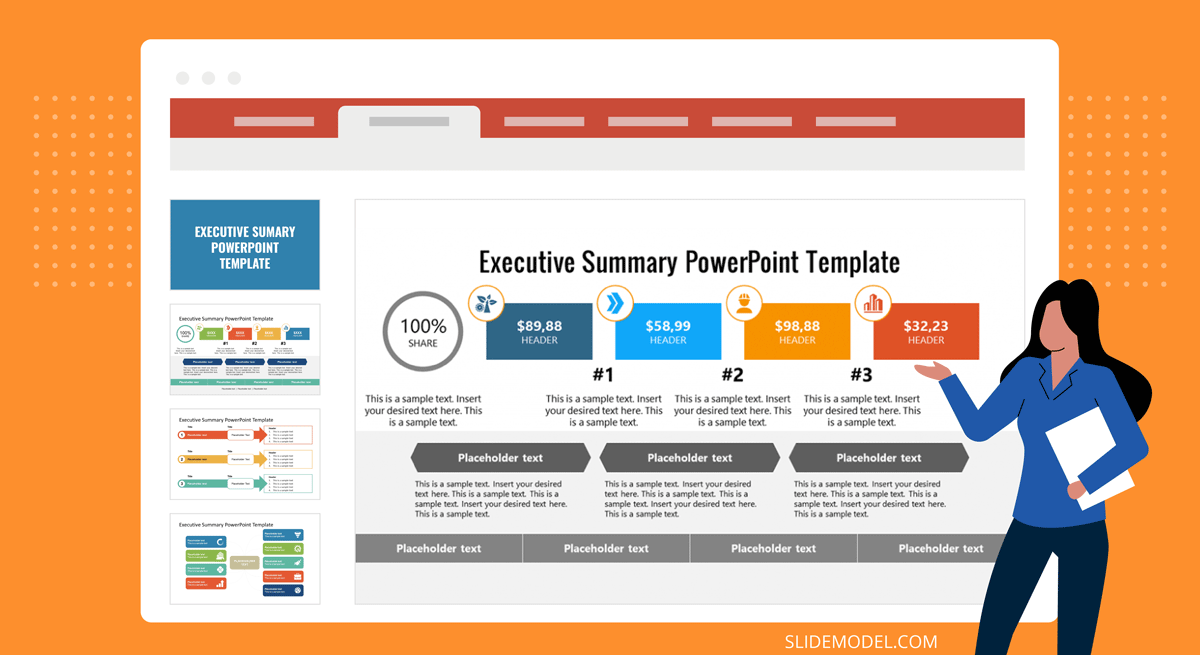
You can build an entire slide deck tailored for an executive summary or business presentation by using our AI Presentation Maker . Fill the topic, analyze & edit the proposed outline, and select a design. That’s it! You can create an engaging executive summary slide deck with any number of slides.
What Makes a Good Executive Summary Slide?
A good executive summary slide visually communicates all the important information from the full report. Typically, it’s an even more condensed version of the written executive summary, prefacing the document. Thus to create a good executive summary slide, be prepared to do some ruthless editing.
Include a condensed version of the:
- Main problem statement or report agenda
- Key findings. Prioritize quantifiable ones
- Recommendations and next steps.
Also, you will need some PowerPoint design mastery to ensure that an executive summary in your PowerPoint presentation looks compelling, but not cluttered. Prioritize white space. Here is where a good executive summary template can make your life easier. To minimize the number of texts, add icons and other simple visualizations. Trim headers and subheads to give the slide even more breathing room.
For those looking to create an engaging and visually appealing presentation, consider utilizing professional presentation templates to enhance the visuals of your executive summary slide. These templates are specifically designed to help presenters convey their message effectively and with style, ensuring that your audience remains captivated and fully understands the key points of your report.
How to Write an Executive Summary for a Presentation
Most likely you won’t need to write a brand new copy for this slide, but rather adapt the text at hand. That already makes your job a lot easier when summarizing a presentation into an executive summary slide. Still, you don’t want to mess anything up. So stick with the executive summary template you’ve chosen and fill in the gaps using our tips.
1. Keep the Tone Consistent
Use the same tone of voice and word choices in your slide deck as you’ve adopted in the report. If the tone of your presentation speech differs too much with terms used on the slide and in the report copy, some audience members may get confused, and then disengaged.
2. Focus on Telling a Story
Stakeholders will have the extra time to read the “dry” report. During the presentation, your main goal is to draw their attention to the most important issue, showcase the value-packed inside the report, and make them eager to learn more by actually flipping the full copy afterward.
3. Chop Full Sentences into Bullet Points
Go snappy and present information in a snackable manner. Remember, our brain can only keep 3-5 items at once in the working memory. So you shouldn’t try to overload the audience with a long list of “very important points” in one sitting.
Also, per a recent presentation survey, among the 3 things that annoy audiences most about presentations are slides that include full sentences of text. So, when working on your presentation summary slide, trim those lengthy texts and move on some of the other points to separate slides.
4. Don’t Go Data Galore
Including numbers and data visualizations is a great way to present your executive summary. However, overloading your data slides with data nuggets makes your presentation less impactful.
As presentation design expert Nancy Duarte explains :
“Data slides aren’t really about the data. They’re about the meaning of the data. It’s up to you to make that meaning clear before you click away. Otherwise, the audience won’t process — let alone buy — your argument.”
It’s a good idea to spotlight 3 main data points on your executive summary slide. Then use some extra minutes to comment on why you’ve chosen to present these.
To Conclude
An executive summary is the first page and/or slide a reader will see. That’s why the stakes are high to make it look just right. Granted, that shouldn’t be an issue. Since you now know how to write, design, and present a compelling executive summary to others!
1. Project Summary PowerPoint Template
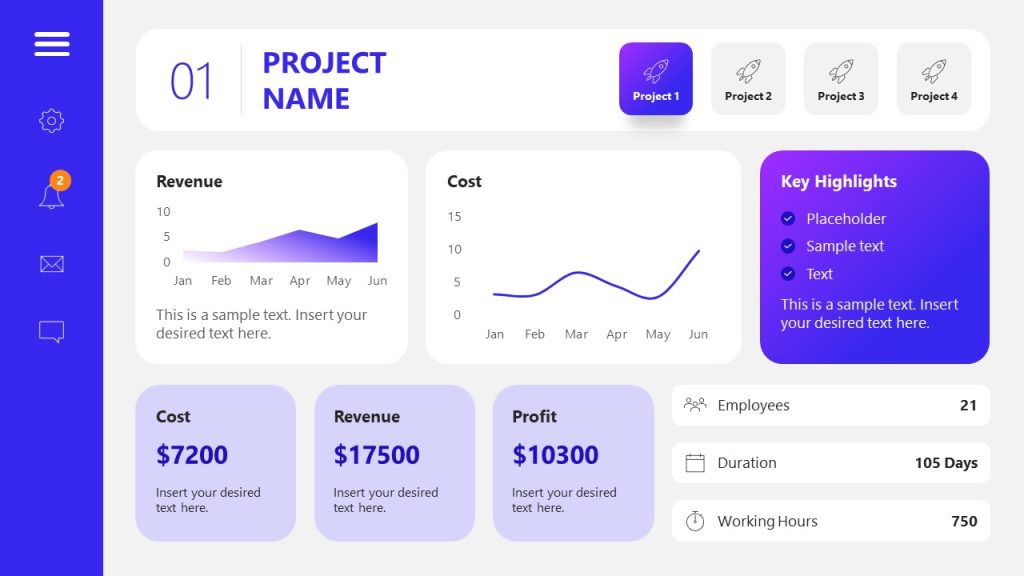
Use This Template
2. Simple Executive Summary Slide Template for PowerPoint
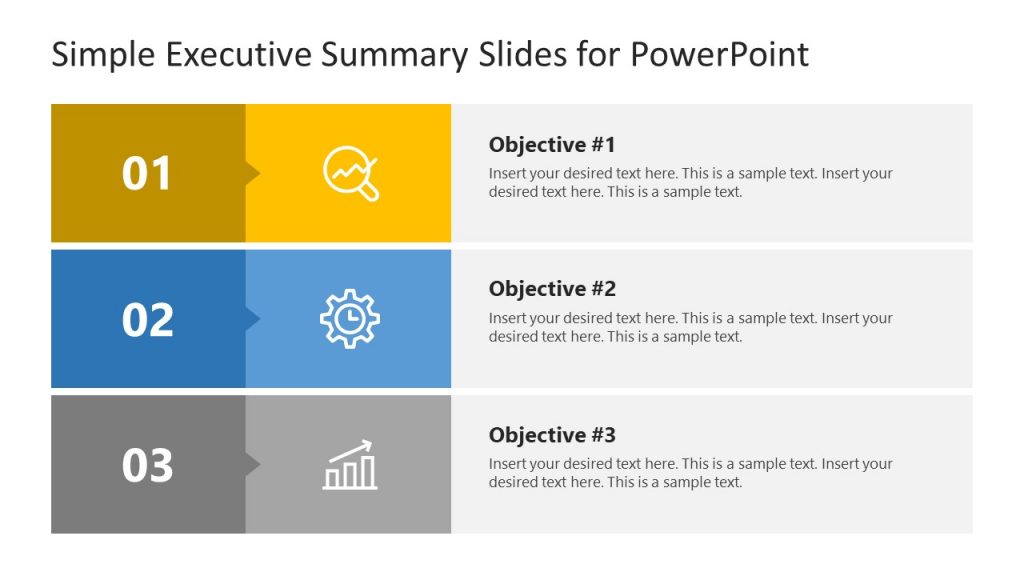
3. One Page Strategy Summary PowerPoint Template
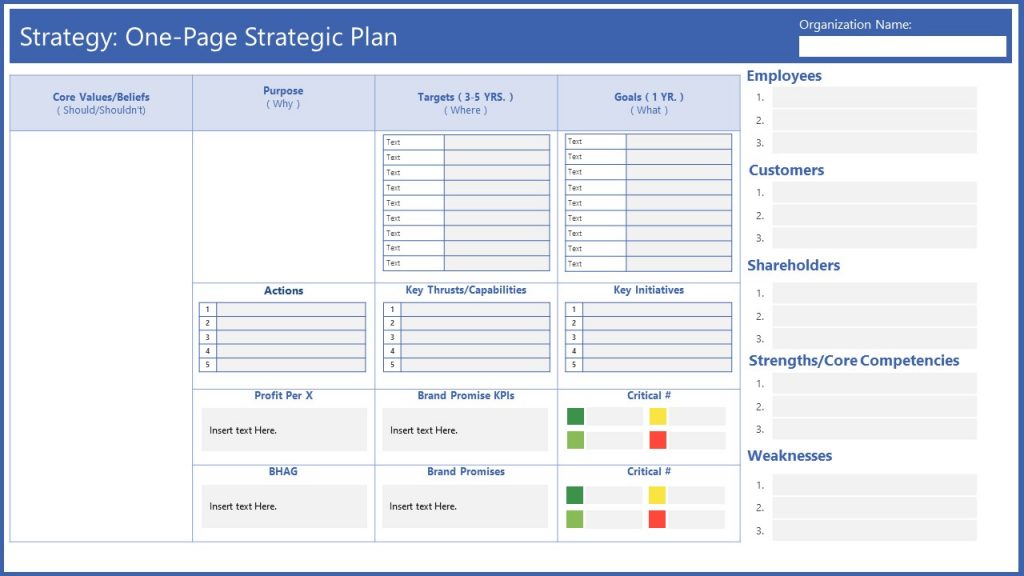
4. Executive Summary PowerPoint Template
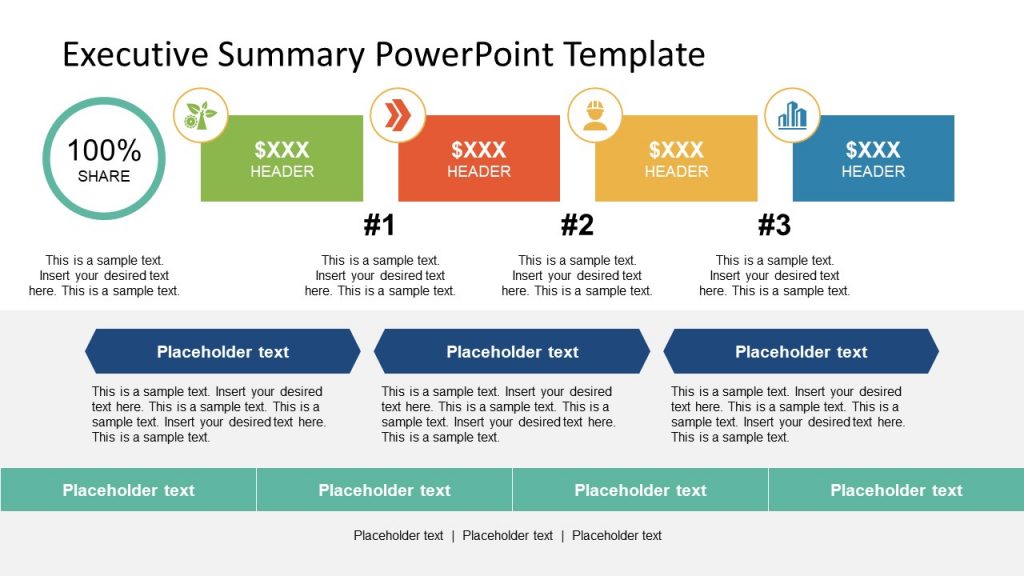
5. Executive Business PowerPoint Template

Like this article? Please share
Executive Reports, Executive Summary Filed under Business
Related Articles
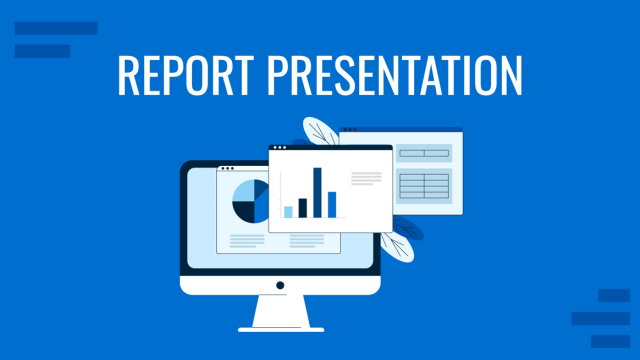
Filed under Business • May 31st, 2024
How to Create an Appealing Report Presentation (Guide + Templates)
Discover the elements that make any kind of report presentation stand out. Recommendations for slide deck content and PPT templates.

Filed under Business • February 25th, 2024
Business Presentation: The Ultimate Guide to Making Powerful Presentations (+ Examples)
A business presentation is a purpose-led summary of key information about your company’s plans, products, or practices, designed for either internal or external audiences. This guide teaches you how to design and deliver excellent business presentations. Plus, breaks down some best practices from business presentation examples by popular companies.
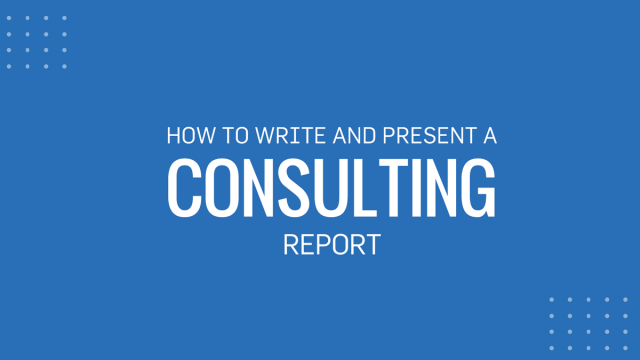
Filed under Business • January 7th, 2024
Consulting Report: How to Write and Present One
Consultants have many tools of the trade at their disposal: Frameworks, analytics dashboards, data science models, and more. Yet many clients still expect to receive a narrated consulting report. So how do you write one? This guide will show you.
Leave a Reply
- Public Speaking
- Visit our Store
5 Tips to Summarize Your Business Presentations Impressively
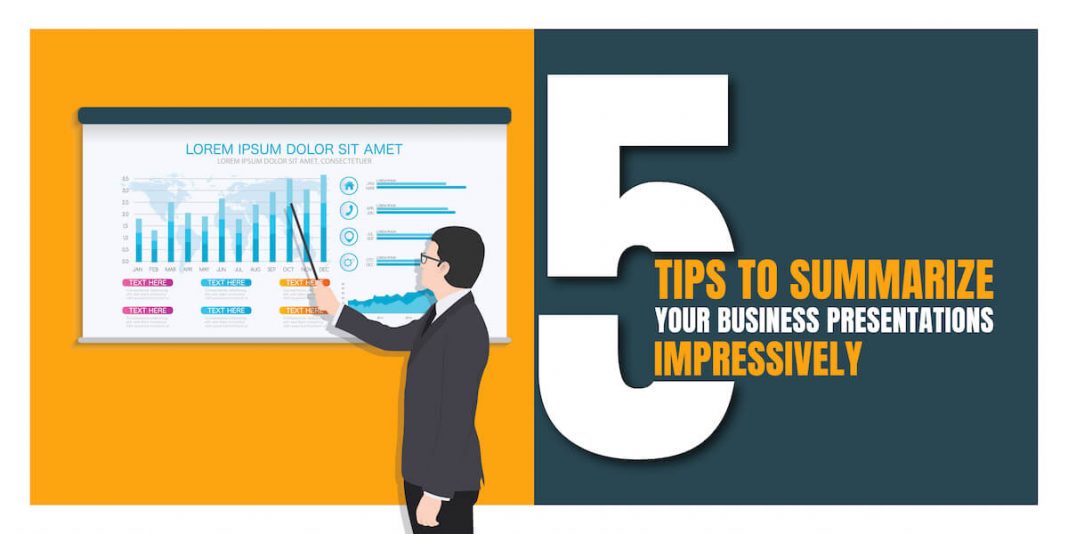
8 Effective Ways to Introduce Yourself in a Presentation
How to write a problem statement slide, how to write the perfect titles for your slides, pro tips to create an impactful employee induction presentation.
Standing in front of a crowd gives most of us jitters, and when the crowd consists of people like top management or potential investors, the stakes get even higher. You certainly wouldn’t want to ruin it.
However, business presentations can fall prey to 2 things quickly if presented poorly – the context can get lost, and with that interest of the audience.
If you don’t want to be the perpetrator of death by PowerPoint, you need to be thorough with one aspect that helps keep the presentation lucid and engaging – a presentation summary.
This article covers everything you need to know about summarizing business presentations. Let’s explore!
What Do You Mean by Presentation Summary?
A summary is an essential part of a presentation as it provides a bird’s eye view of everything essential. It condenses the main idea or significant details of your presentation into key takeaways, important points, or recommendations, helping the audience understand and remember it effortlessly.
Why is it Necessary to Summarize Business Presentations?
Adding a summary to your business presentation will help you in the following ways-
- It will help you clearly showcase the core message or gist of your speech to the audience and make it easier to explain.
- The reiteration and reinforcement of vital information will aid in learning and retention.
- A summary serves as a reference to which the audience can refer in the future.
- It will enable you to think clearly as a presenter. If you have trouble crafting the summary, it will give you insight into the complexity of your entire business presentation, which you can revise accordingly.
- Providing a summary will ensure that people don’t lose the context of your business presentation.
What Should You Include in Your Business Presentation Summary?
Your presentation summary should consist of these essential components-
a). Key Takeaways
The main purpose of the summary slide is to cover and reinforce the key message of your business presentation.
The slide will be your quick reference of the central points that you want people to take away with them. Condense everything important in bullet points to give a clear structure to your star content.
b). CTA (Call To Action)
Your CTA is another significant thing that should be there in your summary, along with the key points. Whether you want to introduce a new product or service or inspire some action, everything requires a meticulous CTA to encourage and facilitate further steps.
CTA in your summary will help strengthen the message. You might include everything else in your summary, but it won’t do much good if people forget to act upon it later.
c). Visuals
Visuals help us remember and retain information better. If your presentation summary includes complex data and statistics, showing it with the help of visuals would make the information attractive and easy to process.
Create an attractive visual summarizing the main points. You can even create a video to make your summary appealing and simplified.
d). Contact Details
Sharing your contact details will help people connect with you post-presentation. It can serve as an opportunity to strengthen your brand and expand your business.
It will also tell people that you are willing to connect and engage, which will help build connections, thereby serving the purpose of your presentation.
How to Summarize Your Presentation?
Now that we have gone through the ‘why,’ let’s cover the ‘how.’ The points below will help you create a crisp and engaging summary.
1. Figure Out the Main Points
As mentioned above, your business presentation should iterate the key points. Concretize your message by considering the following points-
- The goal of delivering the presentation.
- The key insights people should leave with.
- The problems/concerns you are addressing with the presentation.
Analyze these points along with the content of your presentation. It will help you zero in on the key message and idea of your presentation that you can highlight in your summary.
For instance, the presentation is about your business plan. The content includes information about competitors, SWOT analysis, market trends, case studies, etc. The questions above will help you condense the information in a summarized format.
2. Craft An Outline
Just like the presentation, you should create an outline for your summary, too. It will help you align what you seek to present from all the content. Collect your thoughts, take notes, and create a logical sequence that best defines the gist of your business presentation.
Note – You can segment all your material into different sections (for instance, next quarter forecast, previous reports, and growth prospects) to figure out key points from each section.
3. Take Help of Key Presentation Content
If you are uncertain about what content to include in your summary slides (along with the key message), consider incorporating important highlights of your business presentation.
For instance, if your presentation features the current and anticipated growth trajectory of your business (business forecast), you can include key trends in your summary slide.
4. Include Critical Data, Figures, and Analysis
Your slides will have pieces of information that are too important to mention just once. It could be crucial financial figures, data, statistics, analysis, etc., which need to be remembered by the audience.
Summary slides are a great tool for quick recalls and focused attention. Include the vital information in a bullet list, graphics, timelines, business matrices, or different colored texts to make it stand out as the most pivotal part of your presentation.
Note – Use a relevant layout (colors, images, graphics, etc.) that supports the context and content of your summary slide.
5. Use Self-Explanatory Visuals
Visuals (icons, illustrations, images) help explain complex ideas in a single image without needing any outside explanation.
It can really help condense your information while making it easily graspable since you can’t make your summary long and tedious for obvious reasons.
For instance, you must have seen the pictures of the dragon and the planet. It explains the economic concept of unlimited wants and resources, where the dragon (wants) is seen to eat the entire planet (resources).
You can download pre-designed summary templates featuring infographics, diagrams, bars, charts, etc., and include them in your presentations to make your summary outstanding and memorable.
Final Words
Just like an agenda slide is crucial to open your presentation and give the audience an idea about what they can expect in the next 30-40 minutes, a summary slide is essential to provide an impressive closure to your speech.
A well-designed summary slide gives a synopsis of your idea and a quick recap of critical points, ensuring all the audience members are on the same page.
It will also serve as your last chance to woo people.
So, don’t think of a summary slide merely as a formality; it’s an integral part that can make or break your presentation. Therefore, take the help of the above tips to create a compelling summary slide and enable your audience to drive home with the takeaways you want them to remember for longer.
More articles
7 essential skills to present statistical data compellingly, a guide to research presentations: crafting and delivering with impact, pro tips to prepare for a board interview, leave a reply cancel reply.
Save my name, email, and website in this browser for the next time I comment.
Latest Articles
12 tips to adapt your presentation style with the digital world, financial literacy: importance, components, and resources.
© 2024 Collidu.com. All Rights Reserved.
Information
- Visit Our Store
- Free PowerPoint Templates
- Google Slides Themes
Popular Categories
- Presentation Ideas 47
- Public Speaking 21
- Presentation Design 10
- Business 10
- PowerPoint Tips 4
- Google Slides Tips 1
Editor Picks
Have a language expert improve your writing
Run a free plagiarism check in 10 minutes, generate accurate citations for free.
- Knowledge Base
- Working with sources
- How to Write a Summary | Guide & Examples
How to Write a Summary | Guide & Examples
Published on November 23, 2020 by Shona McCombes . Revised on May 31, 2023.
Summarizing , or writing a summary, means giving a concise overview of a text’s main points in your own words. A summary is always much shorter than the original text.
There are five key steps that can help you to write a summary:
- Read the text
- Break it down into sections
- Identify the key points in each section
- Write the summary
- Check the summary against the article
Writing a summary does not involve critiquing or evaluating the source . You should simply provide an accurate account of the most important information and ideas (without copying any text from the original).
Table of contents
When to write a summary, step 1: read the text, step 2: break the text down into sections, step 3: identify the key points in each section, step 4: write the summary, step 5: check the summary against the article, other interesting articles, frequently asked questions about summarizing.
There are many situations in which you might have to summarize an article or other source:
- As a stand-alone assignment to show you’ve understood the material
- To keep notes that will help you remember what you’ve read
- To give an overview of other researchers’ work in a literature review
When you’re writing an academic text like an essay , research paper , or dissertation , you’ll integrate sources in a variety of ways. You might use a brief quote to support your point, or paraphrase a few sentences or paragraphs.
But it’s often appropriate to summarize a whole article or chapter if it is especially relevant to your own research, or to provide an overview of a source before you analyze or critique it.
In any case, the goal of summarizing is to give your reader a clear understanding of the original source. Follow the five steps outlined below to write a good summary.
Don't submit your assignments before you do this
The academic proofreading tool has been trained on 1000s of academic texts. Making it the most accurate and reliable proofreading tool for students. Free citation check included.

Try for free
You should read the article more than once to make sure you’ve thoroughly understood it. It’s often effective to read in three stages:
- Scan the article quickly to get a sense of its topic and overall shape.
- Read the article carefully, highlighting important points and taking notes as you read.
- Skim the article again to confirm you’ve understood the key points, and reread any particularly important or difficult passages.
There are some tricks you can use to identify the key points as you read:
- Start by reading the abstract . This already contains the author’s own summary of their work, and it tells you what to expect from the article.
- Pay attention to headings and subheadings . These should give you a good sense of what each part is about.
- Read the introduction and the conclusion together and compare them: What did the author set out to do, and what was the outcome?
To make the text more manageable and understand its sub-points, break it down into smaller sections.
If the text is a scientific paper that follows a standard empirical structure, it is probably already organized into clearly marked sections, usually including an introduction , methods , results , and discussion .
Other types of articles may not be explicitly divided into sections. But most articles and essays will be structured around a series of sub-points or themes.
Now it’s time go through each section and pick out its most important points. What does your reader need to know to understand the overall argument or conclusion of the article?
Keep in mind that a summary does not involve paraphrasing every single paragraph of the article. Your goal is to extract the essential points, leaving out anything that can be considered background information or supplementary detail.
In a scientific article, there are some easy questions you can ask to identify the key points in each part.
| Introduction | or problem was addressed? |
|---|---|
| Methods | |
| Results | supported? |
| Discussion/conclusion |
If the article takes a different form, you might have to think more carefully about what points are most important for the reader to understand its argument.
In that case, pay particular attention to the thesis statement —the central claim that the author wants us to accept, which usually appears in the introduction—and the topic sentences that signal the main idea of each paragraph.
Scribbr Citation Checker New
The AI-powered Citation Checker helps you avoid common mistakes such as:
- Missing commas and periods
- Incorrect usage of “et al.”
- Ampersands (&) in narrative citations
- Missing reference entries

Now that you know the key points that the article aims to communicate, you need to put them in your own words.
To avoid plagiarism and show you’ve understood the article, it’s essential to properly paraphrase the author’s ideas. Do not copy and paste parts of the article, not even just a sentence or two.
The best way to do this is to put the article aside and write out your own understanding of the author’s key points.
Examples of article summaries
Let’s take a look at an example. Below, we summarize this article , which scientifically investigates the old saying “an apple a day keeps the doctor away.”
Davis et al. (2015) set out to empirically test the popular saying “an apple a day keeps the doctor away.” Apples are often used to represent a healthy lifestyle, and research has shown their nutritional properties could be beneficial for various aspects of health. The authors’ unique approach is to take the saying literally and ask: do people who eat apples use healthcare services less frequently? If there is indeed such a relationship, they suggest, promoting apple consumption could help reduce healthcare costs.
The study used publicly available cross-sectional data from the National Health and Nutrition Examination Survey. Participants were categorized as either apple eaters or non-apple eaters based on their self-reported apple consumption in an average 24-hour period. They were also categorized as either avoiding or not avoiding the use of healthcare services in the past year. The data was statistically analyzed to test whether there was an association between apple consumption and several dependent variables: physician visits, hospital stays, use of mental health services, and use of prescription medication.
Although apple eaters were slightly more likely to have avoided physician visits, this relationship was not statistically significant after adjusting for various relevant factors. No association was found between apple consumption and hospital stays or mental health service use. However, apple eaters were found to be slightly more likely to have avoided using prescription medication. Based on these results, the authors conclude that an apple a day does not keep the doctor away, but it may keep the pharmacist away. They suggest that this finding could have implications for reducing healthcare costs, considering the high annual costs of prescription medication and the inexpensiveness of apples.
However, the authors also note several limitations of the study: most importantly, that apple eaters are likely to differ from non-apple eaters in ways that may have confounded the results (for example, apple eaters may be more likely to be health-conscious). To establish any causal relationship between apple consumption and avoidance of medication, they recommend experimental research.
An article summary like the above would be appropriate for a stand-alone summary assignment. However, you’ll often want to give an even more concise summary of an article.
For example, in a literature review or meta analysis you may want to briefly summarize this study as part of a wider discussion of various sources. In this case, we can boil our summary down even further to include only the most relevant information.
Using national survey data, Davis et al. (2015) tested the assertion that “an apple a day keeps the doctor away” and did not find statistically significant evidence to support this hypothesis. While people who consumed apples were slightly less likely to use prescription medications, the study was unable to demonstrate a causal relationship between these variables.
Citing the source you’re summarizing
When including a summary as part of a larger text, it’s essential to properly cite the source you’re summarizing. The exact format depends on your citation style , but it usually includes an in-text citation and a full reference at the end of your paper.
You can easily create your citations and references in APA or MLA using our free citation generators.
APA Citation Generator MLA Citation Generator
Finally, read through the article once more to ensure that:
- You’ve accurately represented the author’s work
- You haven’t missed any essential information
- The phrasing is not too similar to any sentences in the original.
If you’re summarizing many articles as part of your own work, it may be a good idea to use a plagiarism checker to double-check that your text is completely original and properly cited. Just be sure to use one that’s safe and reliable.
If you want to know more about ChatGPT, AI tools , citation , and plagiarism , make sure to check out some of our other articles with explanations and examples.
- ChatGPT vs human editor
- ChatGPT citations
- Is ChatGPT trustworthy?
- Using ChatGPT for your studies
- What is ChatGPT?
- Chicago style
- Paraphrasing
Plagiarism
- Types of plagiarism
- Self-plagiarism
- Avoiding plagiarism
- Academic integrity
- Consequences of plagiarism
- Common knowledge
A summary is a short overview of the main points of an article or other source, written entirely in your own words. Want to make your life super easy? Try our free text summarizer today!
A summary is always much shorter than the original text. The length of a summary can range from just a few sentences to several paragraphs; it depends on the length of the article you’re summarizing, and on the purpose of the summary.
You might have to write a summary of a source:
- As a stand-alone assignment to prove you understand the material
- For your own use, to keep notes on your reading
- To provide an overview of other researchers’ work in a literature review
- In a paper , to summarize or introduce a relevant study
To avoid plagiarism when summarizing an article or other source, follow these two rules:
- Write the summary entirely in your own words by paraphrasing the author’s ideas.
- Cite the source with an in-text citation and a full reference so your reader can easily find the original text.
An abstract concisely explains all the key points of an academic text such as a thesis , dissertation or journal article. It should summarize the whole text, not just introduce it.
An abstract is a type of summary , but summaries are also written elsewhere in academic writing . For example, you might summarize a source in a paper , in a literature review , or as a standalone assignment.
All can be done within seconds with our free text summarizer .
Cite this Scribbr article
If you want to cite this source, you can copy and paste the citation or click the “Cite this Scribbr article” button to automatically add the citation to our free Citation Generator.
McCombes, S. (2023, May 31). How to Write a Summary | Guide & Examples. Scribbr. Retrieved July 8, 2024, from https://www.scribbr.com/working-with-sources/how-to-summarize/
Is this article helpful?
Shona McCombes
Other students also liked, how to paraphrase | step-by-step guide & examples, how to quote | citing quotes in apa, mla & chicago, the basics of in-text citation | apa & mla examples, get unlimited documents corrected.
✔ Free APA citation check included ✔ Unlimited document corrections ✔ Specialized in correcting academic texts

How To Summarize A Presentation
- Success Team
- December 14, 2022
Working with language data? Save 80%+ of your time and costs.
Join 150,000+ individuals and teams who rely on Speak Ai to capture, transcribe and analyze unstructured language data for valuable insights. Streamline your workflows, unlock new revenue streams and keep doing what you love.
Get a 7-day fully-featured trial!

Presentations are a great way to share information and ideas with an audience. But when you’re done presenting, it’s important to summarize the key points and takeaways. Summarizing a presentation is a crucial step in ensuring that your audience has a clear understanding of the information you shared.
Why Summarizing Is Important
Summarizing a presentation is important for a few reasons. First, it helps to reinforce the key points and takeaways that you want your audience to remember. Second, it helps to ensure that your audience understands the information you shared. Third, it helps to ensure that everyone is on the same page and that everyone has the same understanding of the information. Finally, summarizing a presentation helps to provide closure and helps to ensure that everyone leaves with a clear understanding of the information you shared.
Tips For Summarizing A Presentation
Summarizing a presentation can be a challenge, but there are a few tips that can help make it easier.
1. Identify The Main Points
The first step in summarizing a presentation is to identify the main points. Take a few moments to review the presentation and identify the key points and takeaways. This will help you to ensure that you don’t miss any important information.
2. Use Simple Language
When summarizing a presentation, it’s important to use simple language. Avoid using jargon or technical terms that your audience may not understand. Instead, use language that is easy to understand and that everyone can follow.
3. Focus On The Big Picture
When summarizing a presentation, it’s important to focus on the big picture. Don’t get bogged down in the details. Instead, focus on the main points and takeaways that you want your audience to remember.
4. Ask Questions
Asking questions is a great way to ensure that everyone understands the information. Ask questions to make sure that everyone is on the same page and that everyone has the same understanding of the information.
5. Provide Examples
Providing examples is a great way to help your audience understand the information. Examples can help to illustrate the main points and takeaways and can help to ensure that everyone has a clear understanding of the information.
6. Use Visual Aids
Using visual aids is a great way to help your audience understand the information. Visual aids can help to illustrate the main points and takeaways and can help to ensure that everyone has a clear understanding of the information.
7. Give A Summary
Finally, give a summary of the presentation. This will help to reinforce the key points and takeaways and will help to ensure that everyone has a clear understanding of the information.
Summarizing a presentation is an important step in ensuring that your audience has a clear understanding of the information you shared. By following the tips outlined above, you can ensure that your audience has a clear understanding of the information you shared and that everyone is on the same page.
How To Summarize A Presentation With Speak
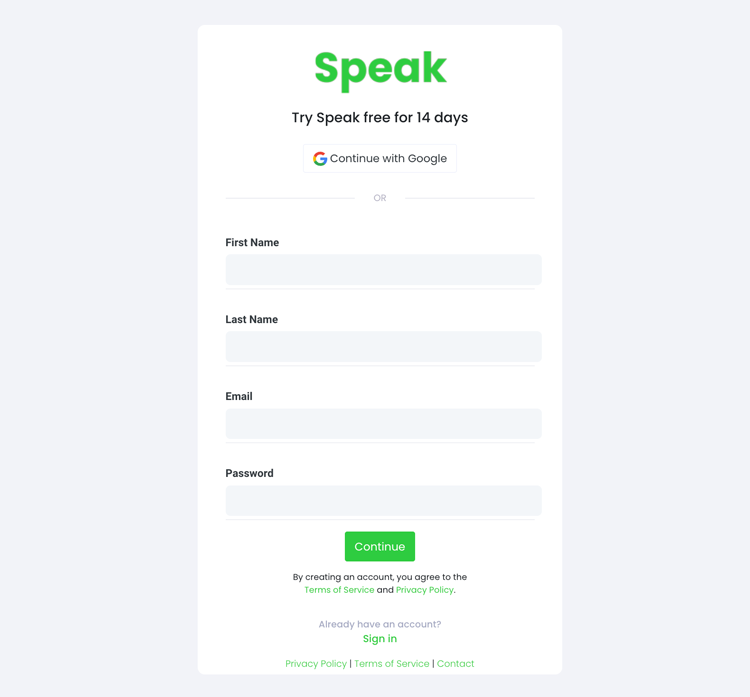
Step 1: Create Your Speak Account
To start your transcription and analysis, you first need to create a Speak account . No worries, this is super easy to do!
Get a 7-day trial with 30 minutes of free English audio and video transcription included when you sign up for Speak.
To sign up for Speak and start using Speak Magic Prompts, visit the Speak app register page here .
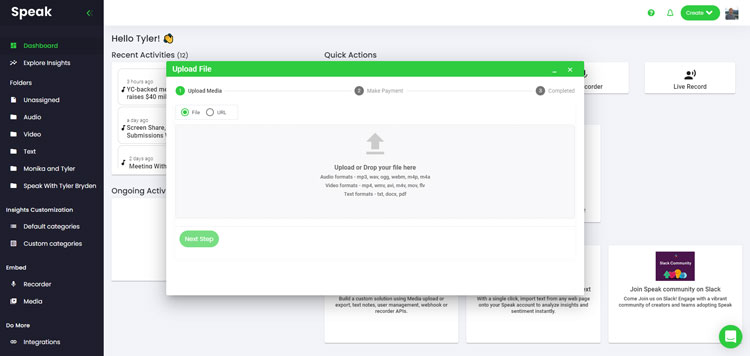
Step 2: Upload Your Language Data
In Speak, you can seamlessly upload, transcribe, and translate audio, video, and text files all at once! If you have video, you can use our AI video-to-text converter to convert video to text; if you have audio, you can use our AI audio-to-text converter to convert audio to text. You can also transcribe YouTube videos and use AI to analyze text . You can see compatible file types for each option below.
Accepted Audio File Types
Accepted video file types, accepted text file types, csv imports.
You can also upload CSVs of text files or audio and video files. You can learn more about CSV uploads and download Speak-compatible CSVs here .
With the CSVs, you can upload anything from dozens of YouTube videos to thousands of Interview Data.
Publicly Available URLs
You can also upload media to Speak through a publicly available URL.
As long as the file type extension is available at the end of the URL you will have no problem importing your recording for automatic transcription and analysis.
YouTube URLs
Speak is compatible with YouTube videos. All you have to do is copy the URL of the YouTube video (for example, https://www.youtube.com/watch?v=qKfcLcHeivc ).
Speak will automatically find the file, calculate the length, and import the video.
If using YouTube videos, please make sure you use the full link and not the shortened YouTube snippet. Additionally, make sure you remove the channel name from the URL.
Speak Integrations
As mentioned, Speak also contains a range of integrations for Zoom , Zapier , Vimeo and more that will help you automatically transcribe your media.
This library of integrations continues to grow! Have a request? Feel encouraged to send us a message.
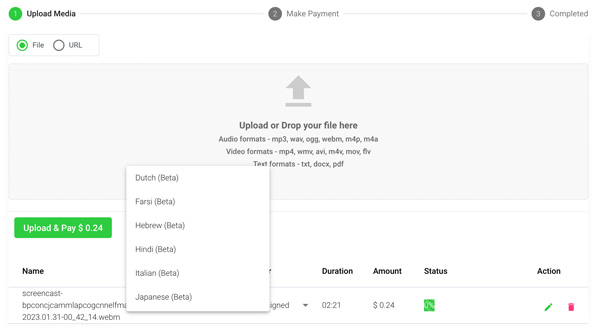
Step 3: Calculate and Pay the Total Automatically
Once you have your file(s) ready and load it into Speak, it will automatically calculate the total cost (you get 30 minutes of audio and video free in the 7-day trial - take advantage of it!).
If you are uploading text data into Speak, you do not currently have to pay any cost. Only the Speak Magic Prompts analysis would create a fee which will be detailed below.
Once you go over your 30 minutes or need to use Speak Magic Prompts, you can pay by subscribing to a personalized plan using our real-time calculator .
You can also add a balance or pay for uploads and analysis without a plan using your credit card .
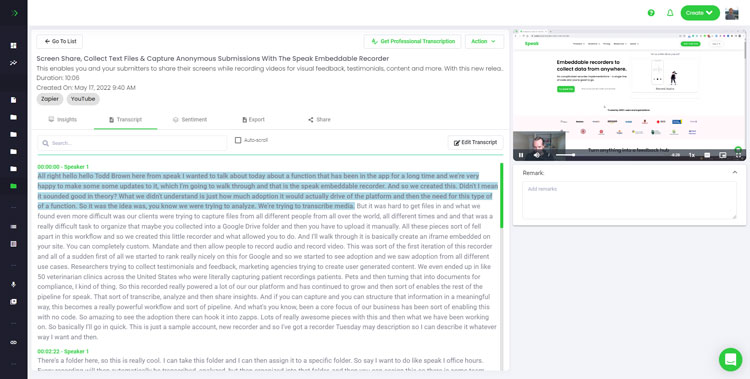
Step 4: Wait for Speak to Analyze Your Language Data
If you are uploading audio and video, our automated transcription software will prepare your transcript quickly. Once completed, you will get an email notification that your transcript is complete. That email will contain a link back to the file so you can access the interactive media player with the transcript, analysis, and export formats ready for you.
If you are importing CSVs or uploading text files Speak will generally analyze the information much more quickly.

Step 5: Visit Your File Or Folder
Speak is capable of analyzing both individual files and entire folders of data.
When you are viewing any individual file in Speak, all you have to do is click on the "Prompts" button.
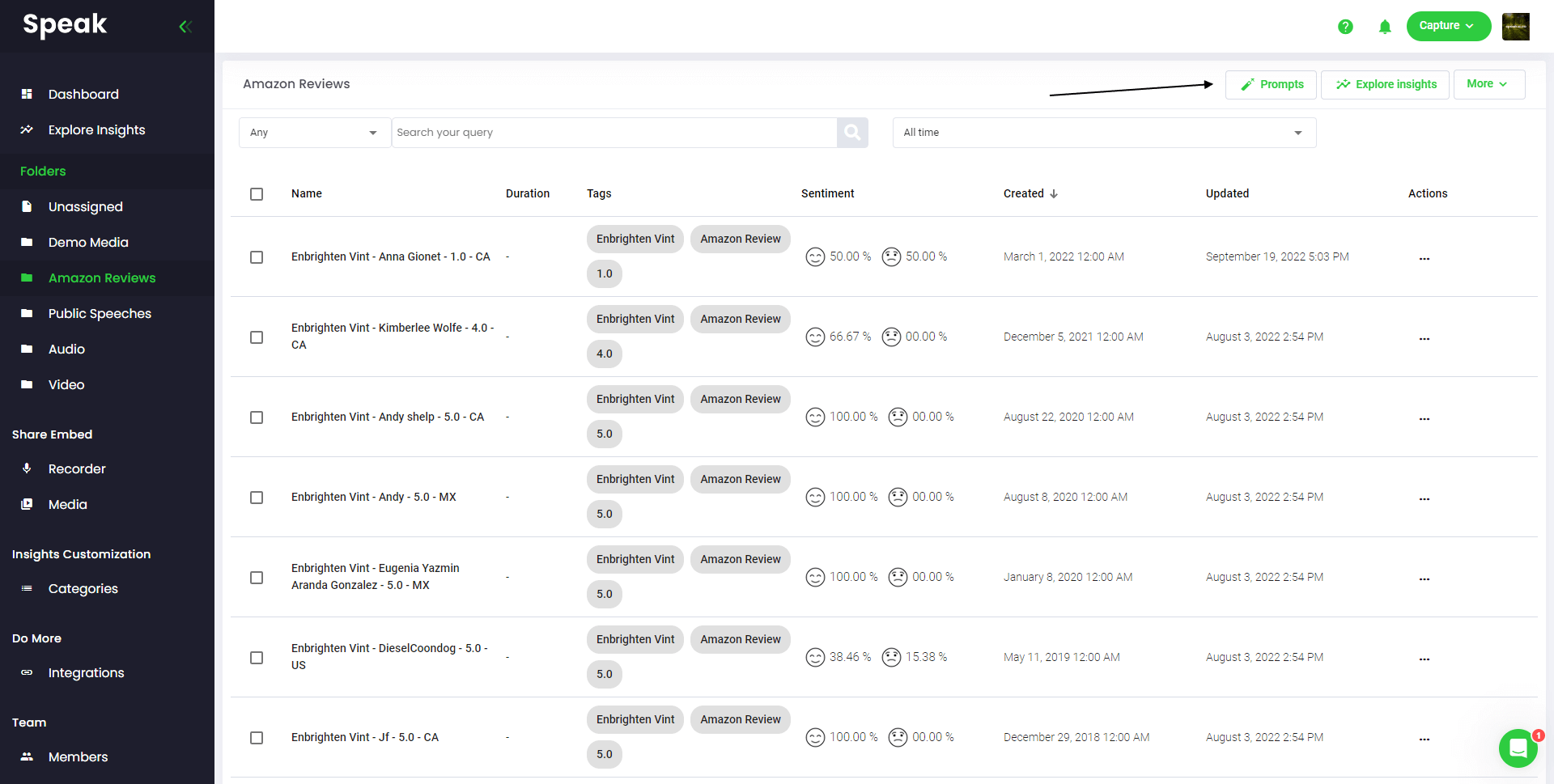
If you want to analyze many files, all you have to do is add the files you want to analyze into a folder within Speak.
You can do that by adding new files into Speak or you can organize your current files into your desired folder with the software's easy editing functionality.
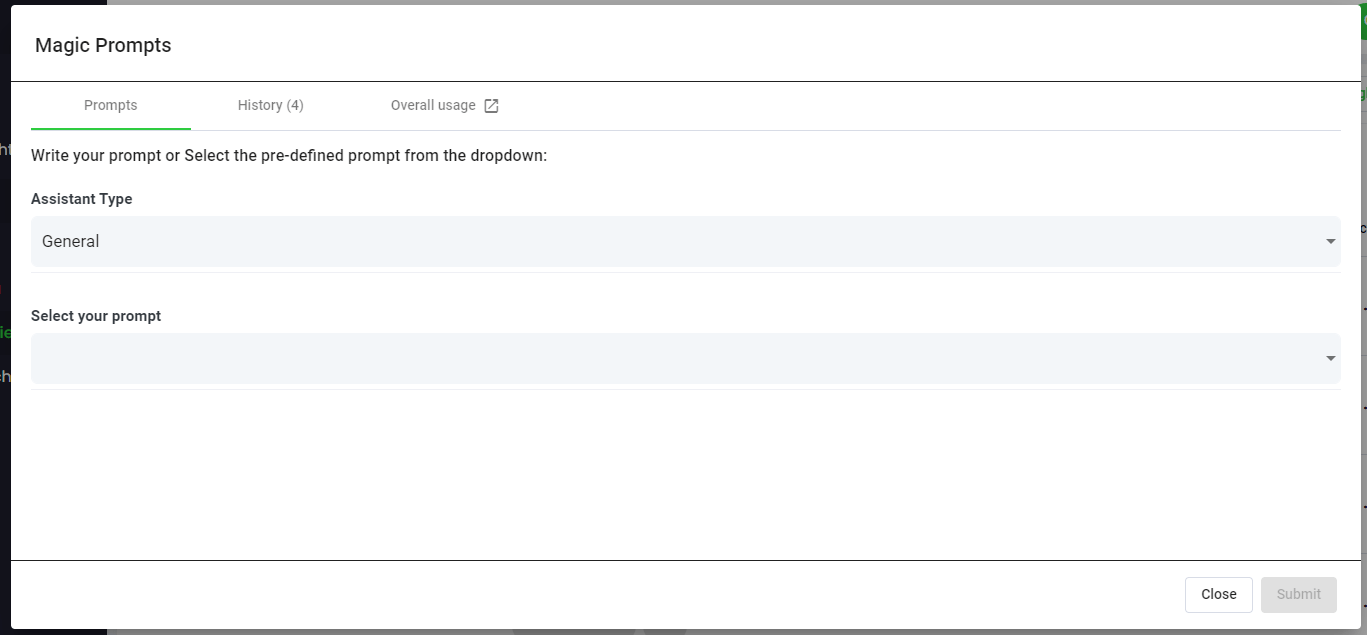
Step 6: Select Speak Magic Prompts To Analyze Your Data
What are magic prompts.
Speak Magic Prompts leverage innovation in artificial intelligence models often referred to as "generative AI".
These models have analyzed huge amounts of data from across the internet to gain an understanding of language.
With that understanding, these "large language models" are capable of performing mind-bending tasks!
With Speak Magic Prompts, you can now perform those tasks on the audio, video and text data in your Speak account.

Step 7: Select Your Assistant Type
To help you get better results from Speak Magic Prompts, Speak has introduced "Assistant Type".
These assistant types pre-set and provide context to the prompt engine for more concise, meaningful outputs based on your needs.
To begin, we have included:
Choose the most relevant assistant type from the dropdown.

Step 8: Create Or Select Your Desired Prompt
Here are some examples prompts that you can apply to any file right now:
- Create a SWOT Analysis
- Give me the top action items
- Create a bullet point list summary
- Tell me the key issues that were left unresolved
- Tell me what questions were asked
- Create Your Own Custom Prompts
A modal will pop up so you can use the suggested prompts we shared above to instantly and magically get your answers.
If you have your own prompts you want to create, select "Custom Prompt" from the dropdown and another text box will open where you can ask anything you want of your data!
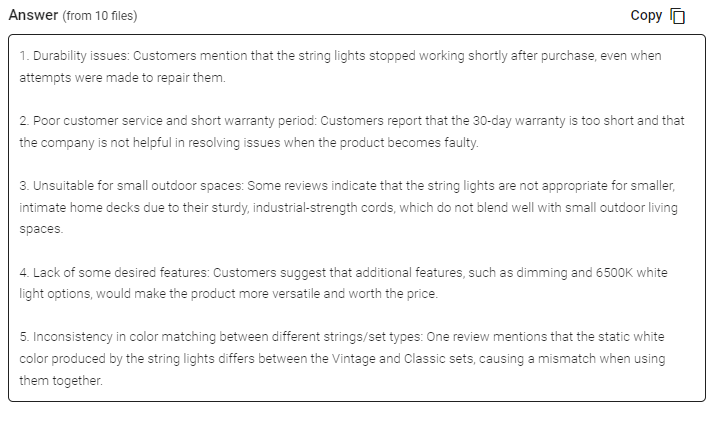
Step 9: Review & Share Responses
Speak will generate a concise response for you in a text box below the prompt selection dropdown.
In this example, we ask to analyze all the Interview Data in the folder at once for the top product dissatisfiers.
You can easily copy that response for your presentations, content, emails, team members and more!
Speak Magic Prompts As ChatGPT For Interview Data Pricing
Our team at Speak Ai continues to optimize the pricing for Magic Prompts and Speak as a whole.
Right now, anyone in the 7-day trial of Speak gets 100,000 characters included in their account.
If you need more characters, you can easily include Speak Magic Prompts in your plan when you create a subscription.
You can also upgrade the number of characters in your account if you already have a subscription.
Both options are available on the subscription page .
Alternatively, you can use Speak Magic Prompts by adding a balance to your account. The balance will be used as you analyze characters.
Completely Personalize Your Plan 📝
Here at Speak, we've made it incredibly easy to personalize your subscription.
Once you sign-up, just visit our custom plan builder and select the media volume, team size, and features you want to get a plan that fits your needs.
No more rigid plans. Upgrade, downgrade or cancel at any time.
Claim Your Special Offer 🎁
When you subscribe, you will also get a free premium add-on for three months!
That means you save up to $50 USD per month and $150 USD in total.
Once you subscribe to a plan, all you have to do is send us a live chat with your selected premium add-on from the list below:
- Premium Export Options (Word, CSV & More)
- Custom Categories & Insights
- Bulk Editing & Data Organization
- Recorder Customization (Branding, Input & More)
- Media Player Customization
- Shareable Media Libraries
We will put the add-on live in your account free of charge!
What are you waiting for?
Refer Others & Earn Real Money 💸
If you have friends, peers and followers interested in using our platform, you can earn real monthly money.
You will get paid a percentage of all sales whether the customers you refer to pay for a plan, automatically transcribe media or leverage professional transcription services.
Use this link to become an official Speak affiliate.
Check Out Our Dedicated Resources📚
- Speak Ai YouTube Channel
- Guide To Building Your Perfect Speak Plan
Book A Free Implementation Session 🤝
It would be an honour to personally jump on an introductory call with you to make sure you are set up for success.
Just use our Calendly link to find a time that works well for you. We look forward to meeting you!

Save 80% & more of your time and costs!
Use Speak's powerful AI to transcribe, analyze, automate and produce incredible insights for you and your team.

One Time Code
< Go back to Login
Forgot Password
Please enter your registered email ID. You will receive an email message with instructions on how to reset your password.

How To Write An Executive Summary Plus Examples Templates
Nowadays, it is becoming challenging to grab the attention of business executives. With jam-packed schedules, quick decisions to make, and not much time to spare, the executives are always looking for value for their time. Hence the need for the Executive Summary to capture the attention of the busy audience by providing the gist of the entire presentation engagingly.
What Is An Executive Summary?
An executive summary is a vital part of any business presentation. In the broader sense, the executive summary is the brief that precedes a more extended report or presentation and outlines the essence of the entire report.
In business environments, an executive summary presentation summarizes the intent of the entire business deck in a concise form.
The purpose of an executive summary is to pique the reader’s curiosity by presenting facts from the larger piece of content. A robust executive summary creates value for the reader as a first impression and generates interest in viewing the rest of the content.
How To Write An Executive Summary
After dealing with several professional clients, we have found many things to keep in mind while writing an executive summary format. These tips will help you build a winning executive summary.
Begin with a bang
The opening statement of your executive summary needs to be effective. Use the most differentiating plus point of your company and present it as the lead sentence. A few examples:
- List the unique problem you are solving, and the impact your solution has.
- Highlight if you have a huge market size, growth opportunity, or high potential investor return.
- Drop known names in the industry if they have collaborated, invested, or endorsed you.
Keep it Simple and Short
The executive summary template should only be 5% – 10% of the length of the entire presentation. Putting too many details in the executive summary is contradicting to its purpose. Make the executive summary focused and simple, by using short paragraphs or bullets, and subheadings.
Placement of the Summary
The executive summary slide should be the last thing you should write when making the presentation . With every revision, the summary needs an update. However, it should be placed right after the table of contents PowerPoint template , and before the introduction of the presentation so that the audience knows what to expect.
The Interest of the Audience
Do your research and consider the mindset of your audience. Tailor the summary to intrigue them with your study and proposal, convincing them to invest more effort in your presentation, and read further.
Good Examples Of Executive Summary For Different Business Scenarios
SlideUpLift has an extensive collection of PowerPoint & Google slide templates to whip up a compelling executive summary instantly. The templates cater to building an executive summary for different types of business presentations. Below are a few executive summary examples:
Strategic Initiatives Executive Summary Template
In this business summary example, you can showcase the snapshot of the strategic initiatives you are proposing in your plan. In a single executive summary slide, you can convey the current facts about the market, market trends, key milestones you wish to achieve, and further how you plan to reach milestones through your initiatives.
The template is perfect to showcase your executive in one single slide. The effective use of icons and shapes makes this template a good executive summary template.
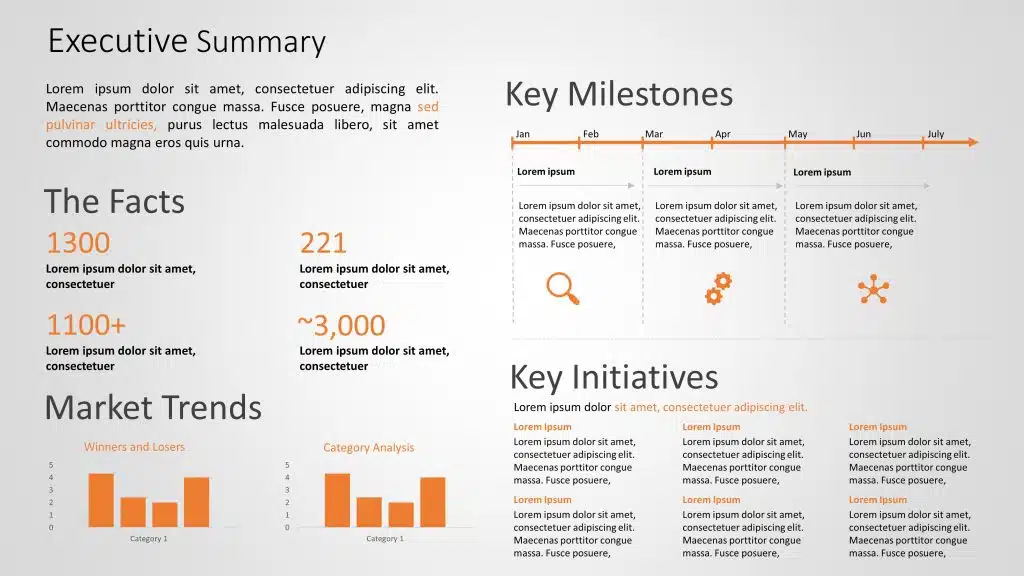
Business Proposal Executive Summary Template
This executive summary sample gives a snapshot of the size and expertise of your organization, conveying how you are qualified to take on the prospective client’s business.
An effective executive summary design format that showcases all important aspects can increase your chances to impress your client or prospect.
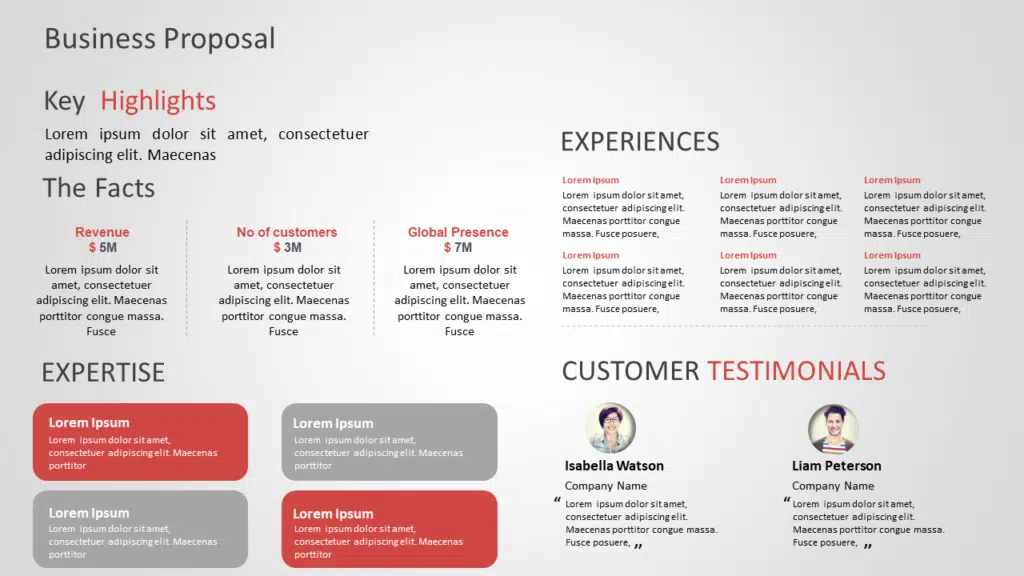
Customer Journey Executive Summary Template
This Executive Summary example showcases a customer’s journey with a brand, company, or organization using creative infographics. This framework allows the brands to summarize factors such as – a customer’s tenure, activity status, demographics, and customer spread across the world.
By using an Executive Summary Template to exhibit a customer’s journey, brands can improve their sales efficiency.
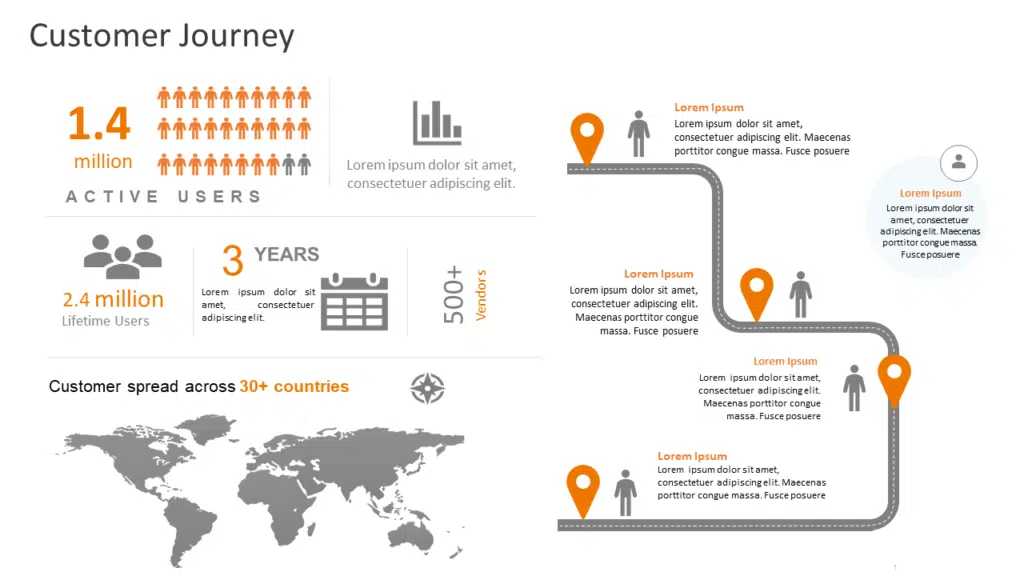
Business Review Executive Summary Template
The following sample of executive summary summarizes the major points an executive need to know for a business review. The slide covers, key milestones, market share and growth, product profile, company strategy, revenue, and profit, all in a structured way.
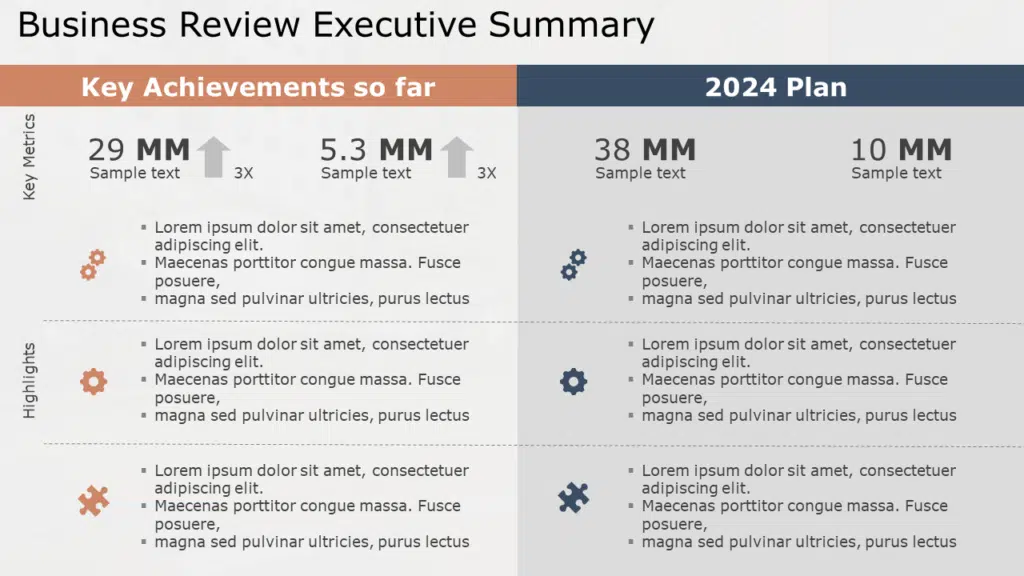
Project Executive Summary Template
This project executive summary example is used to outline a project plan in a business presentation. Using this executive summary of a project template, you can give a quick overview of a project plan with a focus on Team Members, key highlights, and the background of the project. This framework also allows you to compare actions taken and measure the results of a project plan.
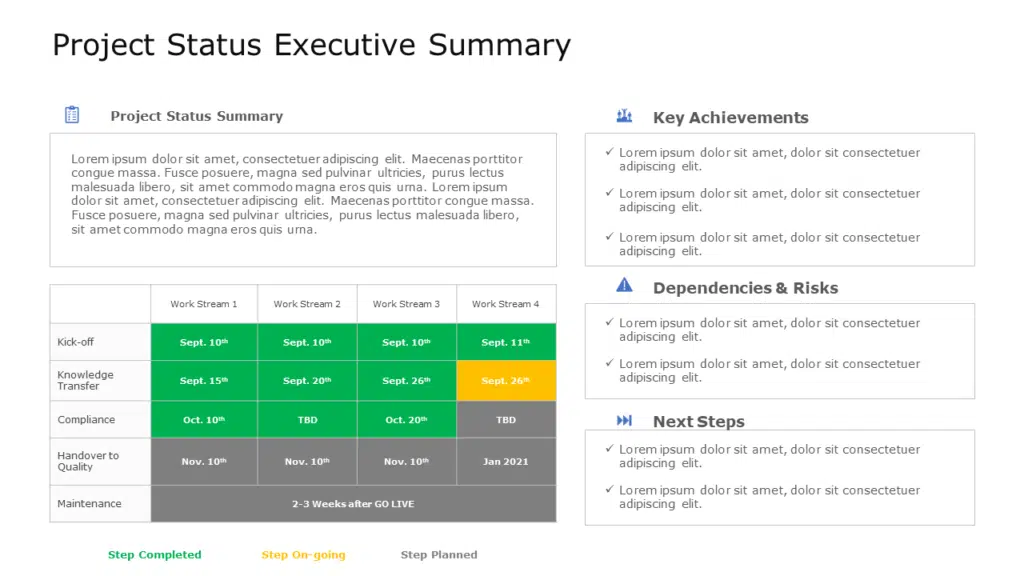
Project Launch Executive Summary Template
This project executive summary template allows you to give a quick overview of the context of your project planning.
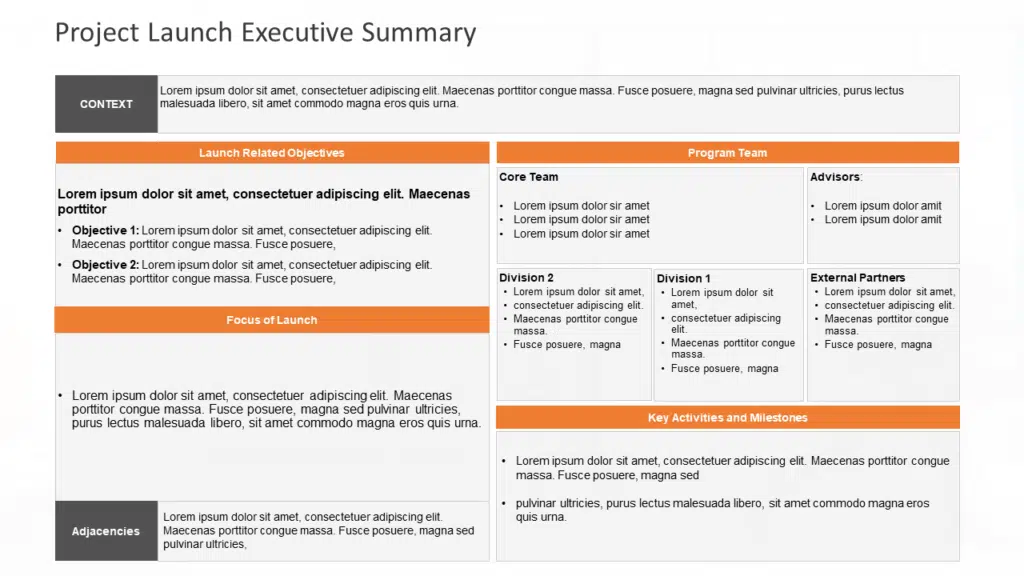
Sales Executive Summary Template
This is a marketing plan executive summary example that can be used to summarize your marketing and sales plan.
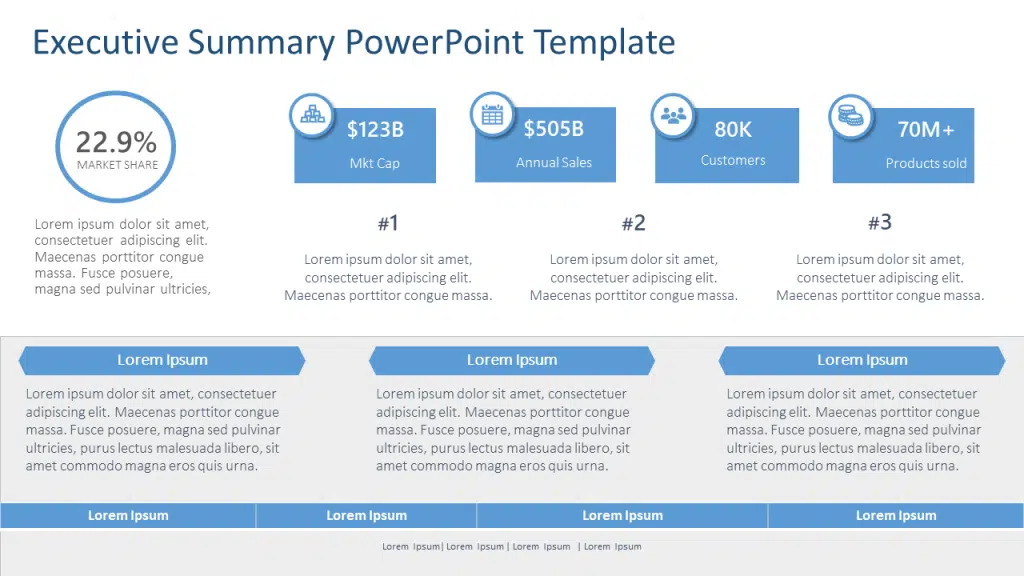
Financial Plan Executive Summary Template
This executive summary sample can help summarize financials in your presentation.
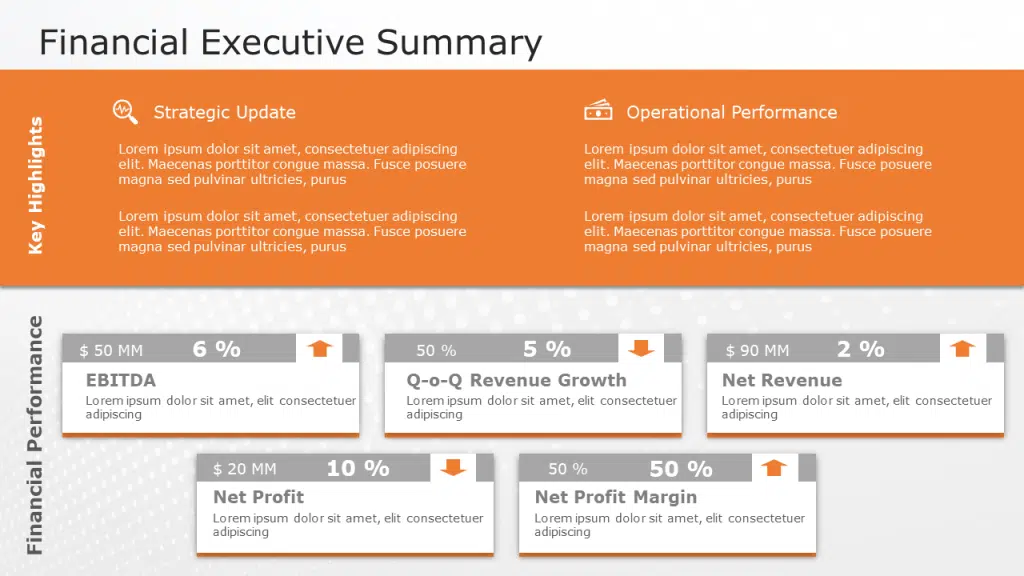
Resume Executive Summary Template
This is the best executive summary example that helps you highlight your career experiences and achievements and allows you to showcase the reasons that make you a suitable candidate.
Best Executive Summary Templates Collection
This collection of executive summary templates that cover most of the summarization of business professionals is available in PowerPoint Themes and Google Slides themes .
Building An Executive Summary Template For A Startup
Now that we know what an executive summary is and learn the tips on how to write an effective Executive Summary. An executive summary example for a startup should be a lean abbreviated version of a business plan with no extra fat. It is like a business plan executive summary example that is crisp. The goal of the startup executive summary presentation is to get a meeting with venture capitalists however the objective of a great executive summary format for a business proposal may include a company profile, existing client information, rich media like charts, graphs, images, projections, and more to keep the readers hooked.
The Punch Statement
The first statement or paragraph should make your audience stop everything else and focus on you. Lead with the most convincing statement and tell why your idea is huge and worthy of your audience’s time. If possible, throw in names that impress the room, like world-class advisors, famous companies you are already working with, or renowned investors you have.
The Problem
Emphasize how the problem you aim to solve is big and impacts a large demographic.
The Solution
What specifically are you offering to whom? Software, hardware, service, combination? Use commonly used terms to state concretely what you have, or what you do, that solves the problem you’ve identified.
The Opportunity
Briefly describe your target customer, size of the market, growth opportunities, market dynamics, and plan for the market.
Your competitive advantage
Describe the competitive position of your company over your competitors, the possible opportunities in the future, plans for growth, and overcoming possible competitor threats.
The Business Model
How specifically are you going to generate revenues, and from whom? Why is your model leverageable and scalable? Why will it be capital efficient?
Why is your team uniquely qualified to win? Don’t just add a shortened form of each founder’s resume; explain why the background of each team member fits.
Detail the exact amount you want to raise, and the key areas where you will invest the funds. Use this section to highlight the growth and add perspective for the reader by showing relevant numbers.
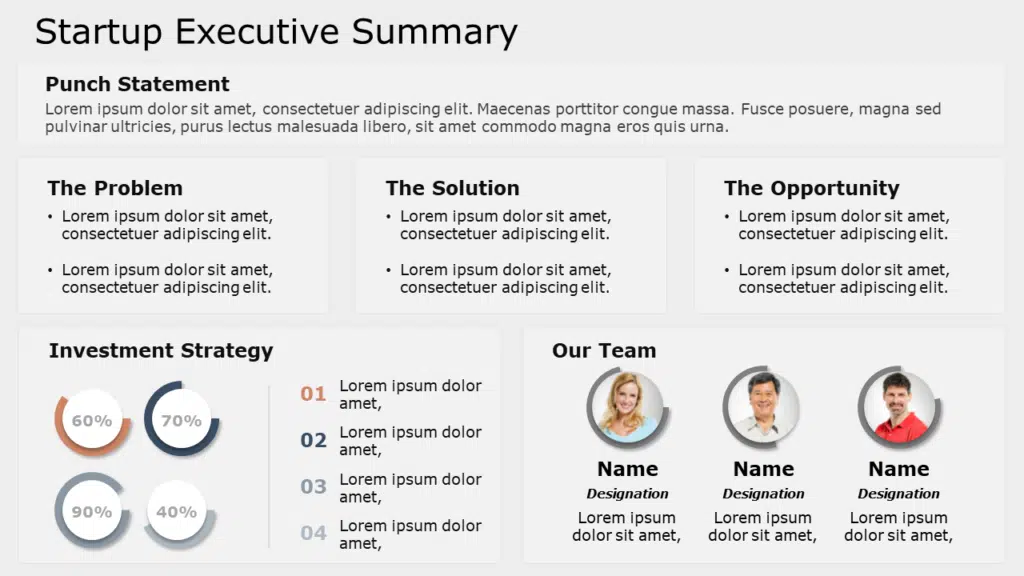
In short, having a good executive summary is crucial to capturing the attention and excitement of your audience. An effective executive summary template captures the core message of your presentation and successfully raises your audience’s intrigue to read further into your presentation.
Build an excellent executive summary to convey to the business executives how you value their time and are worthy of the same, increasing the likelihood of the success of your business presentation . Get ideas from 100+ creative ways of building executive summaries from SlideUpLift Library.
Table Of Content
Related presentations.

Executive Summary PowerPoint Template

Project Executive Summary PowerPoint Template

Related posts from the same category

21 Dec, 2022 | SlideUpLift
6 Tips for Excelling in Executive C Level Presentation
Executives determine the destiny of a corporation. They rely significantly on their team to get the information to make decisions. These decisions are often made during or after high-stakes discussions
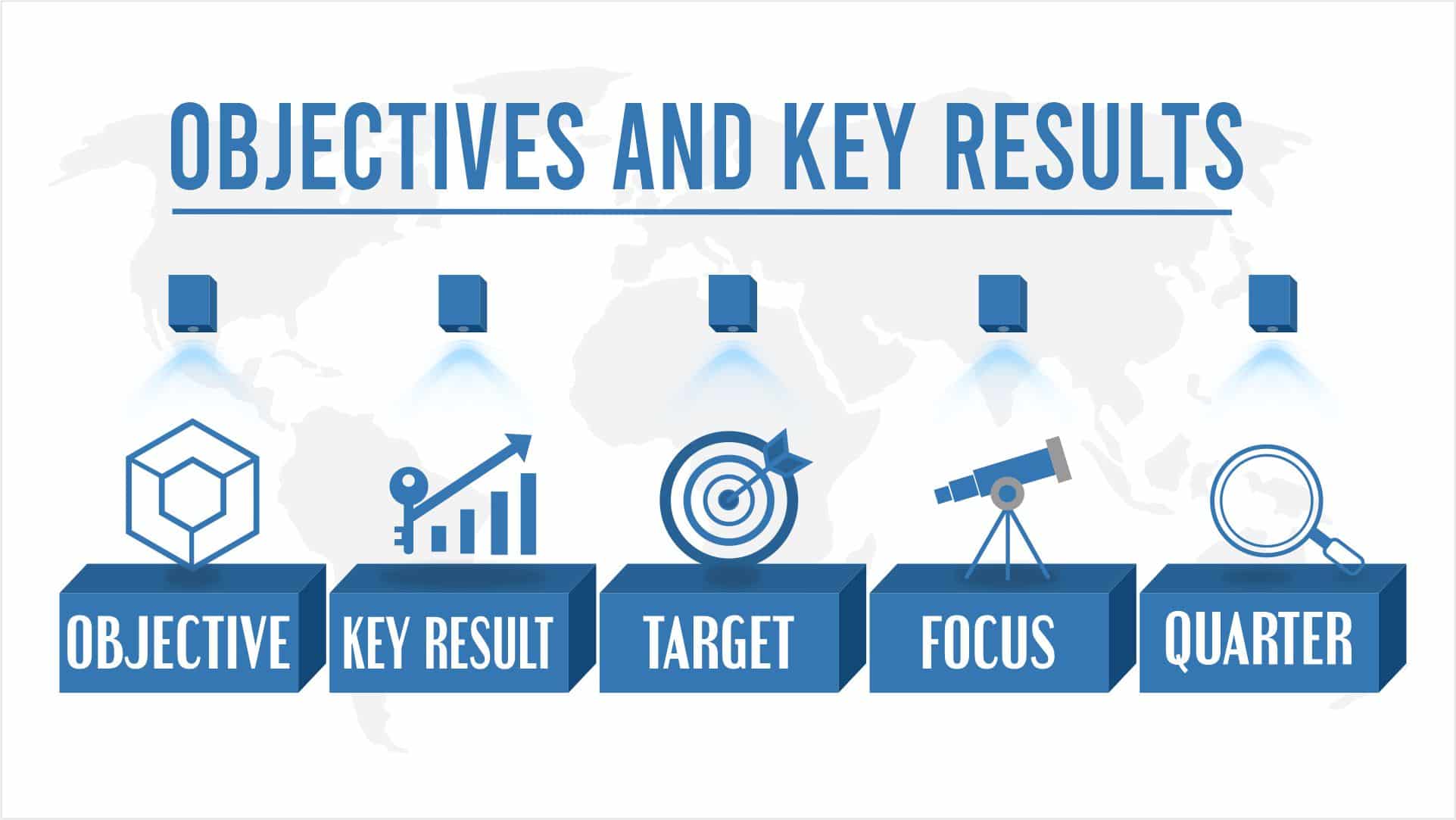
11 Feb, 2021 | SlideUpLift
OKR: The perfect goal-setting framework for ultimate productivity (plus OKR Templates)
The process we go through in our business journey can sometimes be overwhelming. Looking back and reflecting on past mistakes can only get us so far. The real progress is
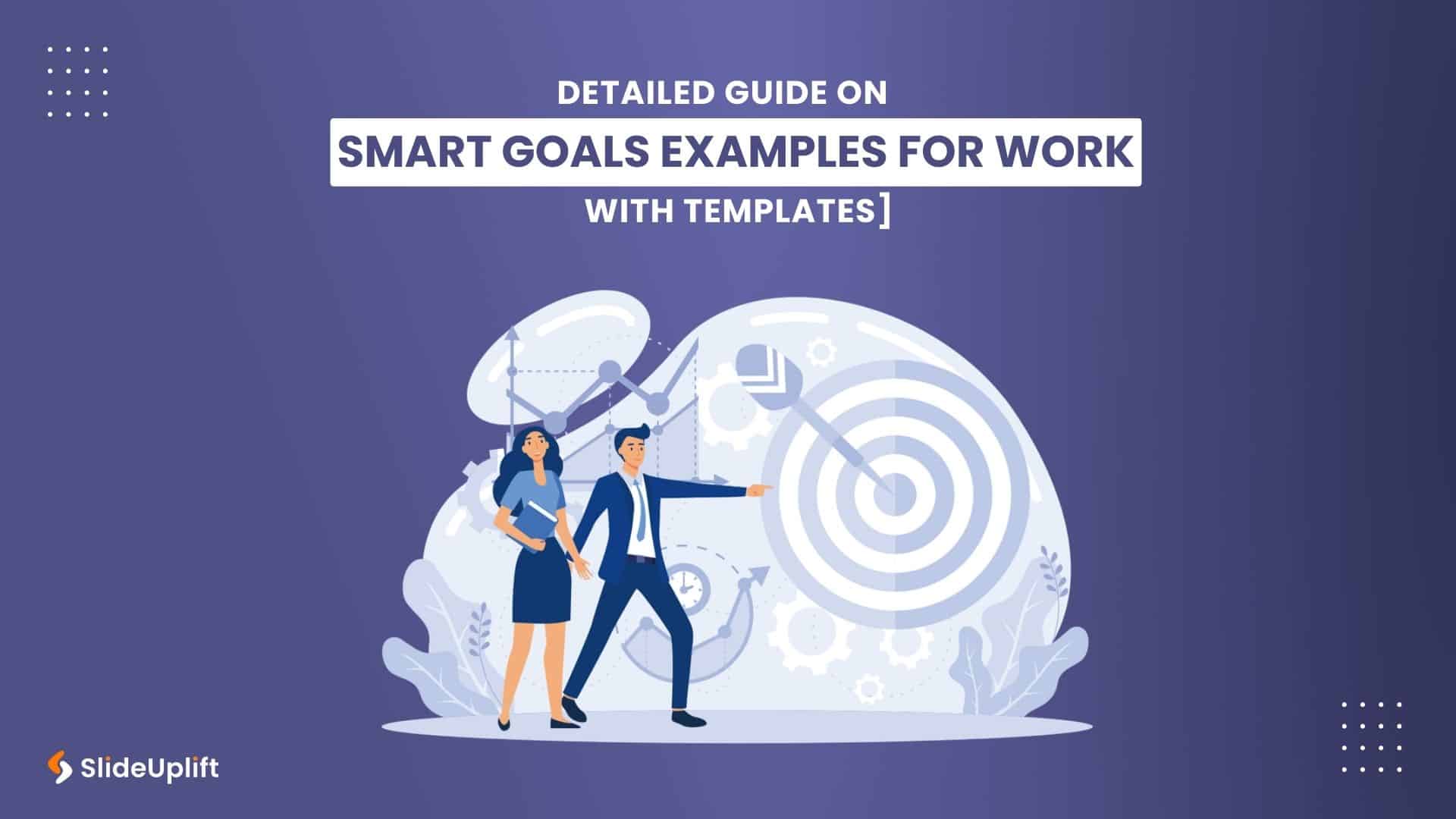
2 Feb, 2024 | SlideUpLift
SMART Goals Examples For Work [Guide For Professionals With Templates]
As we step into the fresh year of 2024, it's time to set resolutions for both our personal and professional lives. This includes taking a close look at our business

22 Mar, 2024 | SlideUpLift
Best Pros And Cons List For Effective Decision-Making
It takes a lot of work to make decisions when choosing one option over the other, especially when there are multiple factors to consider. You may want to opt for

25 Aug, 2021 | SlideUpLift
Top Summarization Techniques that Pro Presenters use
There is an expression experience presenters often use: “I don’t want to drain the slides, so here are the key ideas.” An audience on the verge of drifting to another

9 May, 2023 | SlideUpLift
6 Steps For Designing A Mind Map Presentation (With Templates)
Have you ever been tasked with creating a presentation, only to find yourself struggling with organizing your ideas? Many of us have experienced this situation, and it can feel overwhelming.

13 Sep, 2022 | SlideUpLift
The 5 Most Essential Google Slides Themes Every Business Professional Must Have
Making powerful and memorable Google slides presentations is a highly specialized talent that business people sometimes undervalue yet need it to thrive in the corporate world. However, that's easier said

4 May, 2022 | SlideUpLift
What Is A Key To Problem Solving? CATWOE Analysis Has The Answers
What lies at the core of addressing thorny business issues? We believe it is problem-solving. The most common and difficult obstacle to resolving problems using first principles is defining the

2 Jul, 2021 | SlideUpLift
4 Decision Frameworks That Will Change The Way You Make Decisions
Decision-making is the process of gathering information, evaluating alternatives and resolutions. According to the Oxford Advanced Learners Dictionary, the word "decision making" means "the process of deciding what is important

24 Apr, 2020 | SlideUpLift
What Successful New Business Managers Do: Learn Their Secrets To Success
In a recently conducted study, speaking to 14 new managers we received some amazing insights on the challenges, actions, learnings, and patterns for the success of a new business manager
Related Tags And Categories
Forgot Password?
Privacy Overview
Necessary cookies are absolutely essential for the website to function properly. This category only includes cookies that ensures basic functionalities and security features of the website. These cookies do not store any personal information
Any cookies that may not be particularly necessary for the website to function and is used specifically to collect user personal data via ads, other embedded contents are termed as non-necessary cookies. It is mandatory to procure user consent prior to running these cookies on your website.
Creating an Executive Summary PowerPoint Presentation in 2024: Expert Tips and Techniques
- By Judhajit Sen
- March 20, 2024
What is an Executive Summary in PowerPoint Presentations?
A n executive summary slide gives a quick peek into a more extended presentation, usually found at the start of a slide deck. Its job is to summarize the main points so readers don’t have to go through the whole thing. These slides often have more text than regular slides because they’re meant to be read, not presented live. It’s important to keep live presentations engaging by avoiding too much text on slides.
Think of an executive summary as a short version of a big document, giving important info in an easy-to-understand way. Even though it’s short, an excellent executive summary must focus on the main message. Executives and decision-makers, who are often busy, like presentations that get to the point quickly and professionally. If you can’t do that, you might seem unprepared or unable to communicate well.
An executive summary PPT slide makes presenting vital info from a bigger report or business plan easier. It usually includes a title slide, an agenda or outline slide, and a few summary slides. This helps quickly share critical details like the problem you’re addressing, solutions, expected outcomes, and budget plans.
An executive summary template condenses a more extended presentation into crucial points. It aims to catch readers’ interest, clarify the presentation’s goals, and prepare the audience for the discussion. A good executive summary grabs attention and sets the stage for a complete understanding of the topic.
What are the Benefits of an Executive Summary in Slide Presentations?
In slide presentations, a business plan executive summary is a crucial connection between the presenter and the audience, giving a quick look into what’s coming up. Stakeholders often need to understand proposals, project details, or research quickly, especially in business. Creating a well-organized executive summary ensures that essential points are easy to see, setting the stage for deeper exploration if needed.
In the midst of a PowerPoint slide deck, it’s easy for readers to get lost, trying to remember earlier slides and the main story. Executive summary slides help guide readers through the presentation. They have a few main jobs:
1. Providing Context: Executive summaries provide background information, explaining why the slide deck’s topic is important, which helps the audience understand better.
2. Showing the Main Argument: Executive summaries help readers understand the main idea of the presentation before getting into the details by summarizing the central argument right away.
3. Acting as a Guide: These summaries work like maps for readers, helping them stay on track with the presentation’s story.
Executive summaries, especially in PowerPoint, are handy in the business world. They’re the first thing the audience sees, grabbing attention and making people curious by summarizing long and potentially dull content. The benefits of using an executive summary PowerPoint template include:
1. Saving Time: Executive summaries save presenters and audience members time by condensing important points from long reports or presentations.
2. Clear Organization Overview: These summaries give a quick and optimistic overview of the organization, showing its successes and goals, which makes the audience want to learn more about it.
Executive summaries in slide presentations are crucial for smoother communication and ensuring everyone can easily understand important information. By guiding the audience to deeper insights, they make engagement and understanding easier, moving the story along with clarity and purpose.
How To Write an Effective Executive Summary Slide

To ensure clarity and engagement, crafting a compelling executive summary for slide templates involves several key steps.
1. Start with a Clear Problem Statement: Think of your first paragraph as the opening slide of a presentation. You need to make a strong statement that immediately communicates the agenda. Address the urgency of the issue, highlight its importance, or provide background information to set the scene. Clearly outline the chief goals of the report or document.
2. Present the Main Discussion Points: Expand on the points or scope of the report to meet audience expectations. Break down large blocks of text into bullet points for easier digestion. Use figures to highlight key findings and quantify significant results. Discuss the research methods and data sources, and mention any report limitations. Summarize the conclusions in a paragraph or as a featured quote to highlight critical information. Use concise language throughout the executive summary. For this, an AI summary generator is a useful solution. It uses AI technology to accurately summarize your information around the key points.
3. List Recommendations or Next Steps: Allocate a section at the bottom of the summary to emphasize outcomes, conclusions, and follow-up actions expected from the reader. Summarize the research findings and identify any recommended solutions or actions. Seek feedback from team members who have not seen the full report to ensure the summary effectively conveys the document’s content and piques interest without additional context.
By following these steps, you can create an executive summary that effectively communicates the main points of your presentation and encourages audience engagement.

How To Make an Executive Summary Engaging

A creative executive summary presentation involves several vital strategies to capture your audience’s attention and convey the main points effectively.
1. Create an Engaging Slide Title: The title of your slide is the first thing your audience will see. Make it count by clearly stating the main takeaway and setting the tone for the rest of the slide.
2. Use Basic Story Structure: Your summary should provide a complete presentation overview, including a clear beginning, middle, and end. Many summaries focus solely on insights or data without providing a proper introduction or conclusion.
3. Ensure Scannability: Executive summary slides often contain lots of information, making them dense and challenging to navigate. Make it easier for your audience by organizing information into easily discernible sections. Group related text and graphs together, and include text headers for each section so even those scanning will understand the main points.
4. Maintain Consistent Tone: Ensure that the tone and language used in your slide match those of the primary document. Consistency in tone prevents confusion and keeps the audience engaged.
5. Focus on The Story: While stakeholders may have time to read the full report later, your goal during the presentation is to draw their attention to the most critical issues and highlight the value within the report, enticing them to delve deeper.
6. Use Bullet Points: Present information in bullet points to keep it concise and easily digestible. Avoid overloading your audience with long lists or full sentences, as this can overwhelm them and diminish the impact of your presentation.
7. Limit Data Overload: While data is essential, too much of it can overwhelm your audience. Choose three main data points to highlight on your executive summary slide and provide context for why these points are significant.
8. Utilize Professional Presentation Templates: Consider using presentation templates designed specifically for executive summaries. These help you create visually appealing slides that enhance your message and engage your audience. Prioritize white space and use icons and simple visualizations to minimize clutter and make your slides visually appealing.
By incorporating these strategies, you can create an executive summary slide that conveys important information and keeps your audience curious and engaged.
Crafting a compelling executive summary in slide presentations is essential for conveying critical information concisely and engagingly.
By following strategies such as creating an engaging slide title, using basic story structure, ensuring scannability, maintaining a consistent tone, focusing on the story, using bullet points, limiting data overload, and utilizing professional presentation templates, presenters can captivate their audience’s attention and communicate their main points effectively.
An engaging executive summary sets the stage for a deeper exploration of the topic and facilitates smoother communication, ultimately leading to better stakeholder understanding and engagement.
Frequently Asked Questions (FAQs)
1. What is the purpose of an executive summary slide in a presentation?
An executive summary PPT slide gives a quick overview of a more extended presentation, usually at the beginning of a slide deck. It summarizes the main points so readers don’t have to review the entire presentation. These slides are more text-heavy because they’re meant to be read, not presented live.
2. Why is it essential to have an executive summary in slide presentations?
Executive summaries are a crucial connection between presenters and audiences, offering a glance into the content ahead. They help stakeholders quickly understand proposals, project details, or research findings. By guiding readers through the presentation and providing context, they ensure that important points are easily grasped, setting the stage for deeper exploration if needed.
3. What are the key sections typically included in an executive summary?
An executive summary usually includes sections such as introduction, problem statement, outcomes/recommendations, and importance. These sections help readers understand the document quickly. It’s common to organize them into a clear outline using bullet points to make them easier to turn into slides for a PowerPoint presentation.
4. How can I make an executive summary slide engaging?
Crafting a creative executive summary slide involves:
- Creating an engaging slide title.
- Using basic story structure.
- Ensuring scannability.
- Maintaining a consistent tone.
- Focusing on the story.
- Using bullet points.
- Limiting data overload.
- Utilizing professional presentation templates.
Presenters can capture their audience’s attention by incorporating these strategies and effectively communicate their main points.
Ready to Transform Your Presentations?
Are you looking to elevate your presentations to new heights? Look no further than Prezentium! With our AI-powered services, including overnight presentations, Prezentation Specialists, and Zenith Learning workshops, we’re here to make your presentations shine.
Whether you need a stellar deck delivered by tomorrow morning or expert guidance on transforming ideas into captivating slides, Prezentium has you covered. Don’t settle for mediocre presentations—join the ranks of satisfied clients who trust Prezentium to deliver excellence every time.
Get started today and experience the power of impactful presentations with Prezentium!
Why wait? Avail a complimentary 1-on-1 session with our presentation expert. See how other enterprise leaders are creating impactful presentations with us.
Types of Verbal Communication Skills: Tips, Importance and Styles
9 types of nonverbal communication: importance and examples, 5 active listening skills for better communication.

How to Summarize a Presentation
How to structure a presentation.
Summarizing a presentation provides the opportunity to leave a lasting impression on the audience. The concluding remarks of a presentation are what usually sticks in the audience's head. At one level, the concluding remarks of a summary are like sound bites. They are short and condensed version of the the presentation. If someone missed the actual presentation and only heard the summary, they should have a good idea about the essence of the presentation.
Tell the audience that you are concluding the presentation. This sets the context for the summary and prepares the audience members for your concluding remarks.
Briefly summarize the primary points of the presentation. Avoid digressing into new information, arguments or points of view. Also avoid running a point into the ground that you have already discussed in detail during the presentation. The point of the summary is to remind the audience about the essential core of the presentation. Concentrate on the major ideas and the argument you made that supported the ideas..
Inform the audience about future work that you are interested in pursuing. The subject matter of a presentation usually has room for growth,development or elaboration. It is impossible to cover all of the bases in the time span of a presentation.
Conclude the summary be thanking the audience for listening. Tell the audience that you would be happy to respond to any questions they may having that relate to the presentation.
Related Articles

How to Do a Paper Review Presentation

How to Write an Introduction to a Reflective Essay

How to Evaluate an Oral Presentation

How to Write an Introduction to an Analytical Essay

How to Set Up a Rhetorical Analysis

How to Write a Conclusion for PowerPoint Presentation

How to Write a Dissertation Summary

Tips on Writing a Welcome Address at a High School Graduation
- English Club: Presentations In English
Robert Russell began writing online professionally in 2010. He holds a Ph.D. in philosophy and is currently working on a book project exploring the relationship between art, entertainment and culture. He is the guitar player for the nationally touring cajun/zydeco band Creole Stomp. Russell travels with his laptop and writes many of his articles on the road between gigs.

Improve your practice.
Enhance your soft skills with a range of award-winning courses.
Design Ideas for your Presentation Summary Slide
November 7, 2017 - Dom Barnard
As mentioned in this article , a summary slide will be more beneficial to your audience than a ‘Thank You’ slide. It gives the audience a chance to recap on the main points of the presentation and gives them areas to think about for any audience questions.
What should be included in the summary slide?
A summary slide should include the main points of your presentation which support the message you are trying to get across. You can also add your contact details, such as email address, as people are likely to photograph this slide which their mobiles to remind them of the presentation. Keep the summary slide up when you are going through the questions and answers session.
When going through the summary, briefly explain each point and if possible, highlight the summary point in a different colour when you are talking about it. This keeps it as simple as possible for the audience as their attention span will have reduced by end of your presentation .
Design and content tips
MS PowerPoint offers different well designed layouts for your summary slide, go to Home – Slides Panel – Layout and choose a suitable layout.
Another tip is to hyperlink the points in your summery slide, in case you are asked a question about one of the points and you want to quickly refer to that slide in more detail.
You can also include visual images in the summary if they were used earlier in the presentation. People are much better at remembering images than verbal information. When talking about a summary point, you can bring up an image from that section of the presentation to jog the audiences memory.
Some simple examples
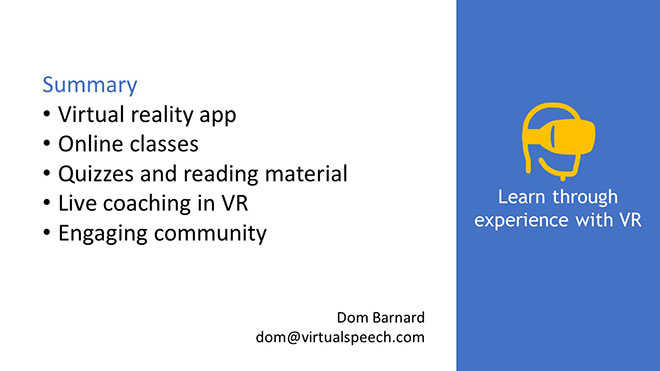
Basic summary slide with main points and contact information on it. The key message of the presentation is highlighted on the right hand side.
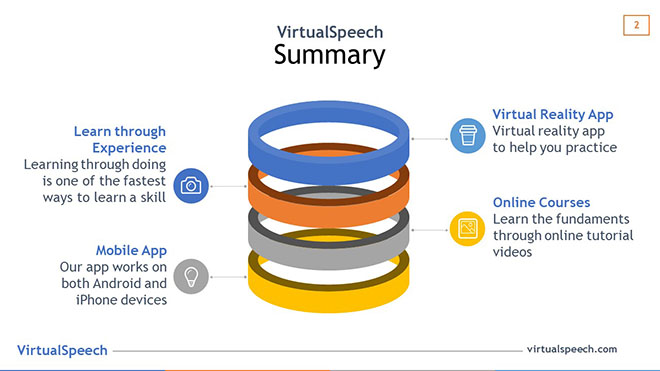
This summary slide is a little more visual, with the key points still mentioned on the slide.
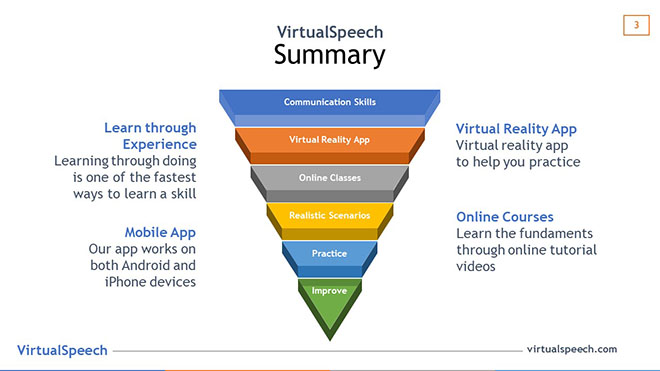
This diagram gives the audience a little more context to the information around it. The audience can see how this information leads to improving skills.

30 Examples: How to Conclude a Presentation (Effective Closing Techniques)
By Status.net Editorial Team on March 4, 2024 — 9 minutes to read
Ending a presentation on a high note is a skill that can set you apart from the rest. It’s the final chance to leave an impact on your audience, ensuring they walk away with the key messages embedded in their minds. This moment is about driving your points home and making sure they resonate. Crafting a memorable closing isn’t just about summarizing key points, though that’s part of it, but also about providing value that sticks with your listeners long after they’ve left the room.
Crafting Your Core Message
To leave a lasting impression, your presentation’s conclusion should clearly reflect your core message. This is your chance to reinforce the takeaways and leave the audience thinking about your presentation long after it ends.
Identifying Key Points
Start by recognizing what you want your audience to remember. Think about the main ideas that shaped your talk. Make a list like this:
- The problem your presentation addresses.
- The evidence that supports your argument.
- The solution you propose or the action you want the audience to take.
These key points become the pillars of your core message.
Contextualizing the Presentation
Provide context by briefly relating back to the content of the whole presentation. For example:
- Reference a statistic you shared in the opening, and how it ties into the conclusion.
- Mention a case study that underlines the importance of your message.
Connecting these elements gives your message cohesion and makes your conclusion resonate with the framework of your presentation.
30 Example Phrases: How to Conclude a Presentation
- 1. “In summary, let’s revisit the key takeaways from today’s presentation.”
- 2. “Thank you for your attention. Let’s move forward together.”
- 3. “That brings us to the end. I’m open to any questions you may have.”
- 4. “I’ll leave you with this final thought to ponder as we conclude.”
- 5. “Let’s recap the main points before we wrap up.”
- 6. “I appreciate your engagement. Now, let’s turn these ideas into action.”
- 7. “We’ve covered a lot today. To conclude, remember these crucial points.”
- 8. “As we reach the end, I’d like to emphasize our call to action.”
- 9. “Before we close, let’s quickly review what we’ve learned.”
- 10. “Thank you for joining me on this journey. I look forward to our next steps.”
- 11. “In closing, I’d like to thank everyone for their participation.”
- 12. “Let’s conclude with a reminder of the impact we can make together.”
- 13. “To wrap up our session, here’s a brief summary of our discussion.”
- 14. “I’m grateful for the opportunity to present to you. Any final thoughts?”
- 15. “And that’s a wrap. I welcome any final questions or comments.”
- 16. “As we conclude, let’s remember the objectives we’ve set today.”
- 17. “Thank you for your time. Let’s apply these insights to achieve success.”
- 18. “In conclusion, your feedback is valuable, and I’m here to listen.”
- 19. “Before we part, let’s take a moment to reflect on our key messages.”
- 20. “I’ll end with an invitation for all of us to take the next step.”
- 21. “As we close, let’s commit to the goals we’ve outlined today.”
- 22. “Thank you for your attention. Let’s keep the conversation going.”
- 23. “In conclusion, let’s make a difference, starting now.”
- 24. “I’ll leave you with these final words to consider as we end our time together.”
- 25. “Before we conclude, remember that change starts with our actions today.”
- 26. “Thank you for the lively discussion. Let’s continue to build on these ideas.”
- 27. “As we wrap up, I encourage you to reach out with any further questions.”
- 28. “In closing, I’d like to express my gratitude for your valuable input.”
- 29. “Let’s conclude on a high note and take these learnings forward.”
- 30. “Thank you for your time today. Let’s end with a commitment to progress.”
Summarizing the Main Points
When you reach the end of your presentation, summarizing the main points helps your audience retain the important information you’ve shared. Crafting a memorable summary enables your listeners to walk away with a clear understanding of your message.
Effective Methods of Summarization
To effectively summarize your presentation, you need to distill complex information into concise, digestible pieces. Start by revisiting the overarching theme of your talk and then narrow down to the core messages. Use plain language and imagery to make the enduring ideas stick. Here are some examples of how to do this:
- Use analogies that relate to common experiences to recap complex concepts.
- Incorporate visuals or gestures that reinforce your main arguments.
The Rule of Three
The Rule of Three is a classic writing and communication principle. It means presenting ideas in a trio, which is a pattern that’s easy for people to understand and remember. For instance, you might say, “Our plan will save time, cut costs, and improve quality.” This structure has a pleasing rhythm and makes the content more memorable. Some examples include:
- “This software is fast, user-friendly, and secure.”
- Pointing out a product’s “durability, affordability, and eco-friendliness.”
Reiterating the Main Points
Finally, you want to circle back to the key takeaways of your presentation. Rephrase your main points without introducing new information. This reinforcement supports your audience’s memory and understanding of the material. You might summarize key takeaways like this:
- Mention the problem you addressed, the solution you propose, and the benefits of this solution.
- Highlighting the outcomes of adopting your strategy: higher efficiency, greater satisfaction, and increased revenue.
Creating a Strong Conclusion
The final moments of your presentation are your chance to leave your audience with a powerful lasting impression. A strong conclusion is more than just summarizing—it’s your opportunity to invoke thought, inspire action, and make your message memorable.
Incorporating a Call to Action
A call to action is your parting request to your audience. You want to inspire them to take a specific action or think differently as a result of what they’ve heard. To do this effectively:
- Be clear about what you’re asking.
- Explain why their action is needed.
- Make it as simple as possible for them to take the next steps.
Example Phrases:
- “Start making a difference today by…”
- “Join us in this effort by…”
- “Take the leap and commit to…”
Leaving a Lasting Impression
End your presentation with something memorable. This can be a powerful quote, an inspirational statement, or a compelling story that underscores your main points. The goal here is to resonate with your audience on an emotional level so that your message sticks with them long after they leave.
- “In the words of [Influential Person], ‘…'”
- “Imagine a world where…”
- “This is more than just [Topic]; it’s about…”
Enhancing Audience Engagement
To hold your audience’s attention and ensure they leave with a lasting impression of your presentation, fostering interaction is key.
Q&A Sessions
It’s important to integrate a Q&A session because it allows for direct communication between you and your audience. This interactive segment helps clarify any uncertainties and encourages active participation. Plan for this by designating a time slot towards the end of your presentation and invite questions that promote discussion.
- “I’d love to hear your thoughts; what questions do you have?”
- “Let’s dive into any questions you might have. Who would like to start?”
- “Feel free to ask any questions, whether they’re clarifications or deeper inquiries about the topic.”
Encouraging Audience Participation
Getting your audience involved can transform a good presentation into a great one. Use open-ended questions that provoke thought and allow audience members to reflect on how your content relates to them. Additionally, inviting volunteers to participate in a demonstration or share their experiences keeps everyone engaged and adds a personal touch to your talk.
- “Could someone give me an example of how you’ve encountered this in your work?”
- “I’d appreciate a volunteer to help demonstrate this concept. Who’s interested?”
- “How do you see this information impacting your daily tasks? Let’s discuss!”
Delivering a Persuasive Ending
At the end of your presentation, you have the power to leave a lasting impact on your audience. A persuasive ending can drive home your key message and encourage action.
Sales and Persuasion Tactics
When you’re concluding a presentation with the goal of selling a product or idea, employ carefully chosen sales and persuasion tactics. One method is to summarize the key benefits of your offering, reminding your audience why it’s important to act. For example, if you’ve just presented a new software tool, recap how it will save time and increase productivity. Another tactic is the ‘call to action’, which should be clear and direct, such as “Start your free trial today to experience the benefits first-hand!” Furthermore, using a touch of urgency, like “Offer expires soon!”, can nudge your audience to act promptly.
Final Impressions and Professionalism
Your closing statement is a chance to solidify your professional image and leave a positive impression. It’s important to display confidence and poise. Consider thanking your audience for their time and offering to answer any questions. Make sure to end on a high note by summarizing your message in a concise and memorable way. If your topic was on renewable energy, you might conclude by saying, “Let’s take a leap towards a greener future by adopting these solutions today.” This reinforces your main points and encourages your listeners to think or act differently when they leave.
Frequently Asked Questions
What are some creative strategies for ending a presentation memorably.
To end your presentation in a memorable way, consider incorporating a call to action that engages your audience to take the next step. Another strategy is to finish with a thought-provoking question or a surprising fact that resonates with your listeners.
Can you suggest some powerful quotes suitable for concluding a presentation?
Yes, using a quote can be very effective. For example, Maya Angelou’s “People will forget what you said, people will forget what you did, but people will never forget how you made them feel,” can reinforce the emotional impact of your presentation.
What is an effective way to write a conclusion that summarizes a presentation?
An effective conclusion should recap the main points succinctly, highlighting what you want your audience to remember. A good way to conclude is by restating your thesis and then briefly summarizing the supporting points you made.
As a student, how can I leave a strong impression with my presentation’s closing remarks?
To leave a strong impression, consider sharing a personal anecdote related to your topic that demonstrates passion and conviction. This helps humanize your content and makes the message more relatable to your audience.
How can I appropriately thank my audience at the close of my presentation?
A simple and sincere expression of gratitude is always appropriate. You might say, “Thank you for your attention and engagement today,” to convey appreciation while also acknowledging their participation.
What are some examples of a compelling closing sentence in a presentation?
A compelling closing sentence could be something like, “Together, let’s take the leap towards a greener future,” if you’re presenting on sustainability. This sentence is impactful, calls for united action, and leaves your audience with a clear message.
- How to Build Rapport: Effective Techniques
- Active Listening (Techniques, Examples, Tips)
- Effective Nonverbal Communication in the Workplace (Examples)
- What is Problem Solving? (Steps, Techniques, Examples)
- 2 Examples of an Effective and Warm Letter of Welcome
- 8 Examples of Effective Interview Confirmation Emails

How to Summarize a Presentation: 5 Easy Steps
Table of Contents
Introduction
Different people have varying needs for summaries. For a student, summaries are a great way to keep notes. They help them during their exam preparations.
The reason presentations are used is that they can, paired with images and graphs, effectively utilize the least amount of text. However, even these need to be summarized frequently because the executives do not have a lot of time to go through an entire presentation.In this post, we will check out some ways to summarize presentations.
Using a Tool
They can use summarizing tools to generate succinct summaries of presentations or plans/strategies.
Summarizing tools are widely available on the internet. And a lot of them are free to use. A great text summarizer can summarize your content in the shortest possible time using the number of words you like. Some summarizers come with the option of condensing the source material into a paragraph or a series of bullet points. Since there are a lot of tools to pick from, you can try out a few and use the ones that suit your needs best.
By Hand/Manually
Read and understand the presentation, segment the material into sections, identify key points, write the summary, compare to the original and revise.
Summarizing can be a difficult task depending on what kind of topic is being talked about or who is doing the summarizing. Some people have a way with words and they are naturally able to say things in a concise manner, while others have to learn how to do so.
Summarizing is a skill that is required in presentations and speeches. These are both mediums using which information and possibly new concepts are provided to the audience. At the end of both, a summary is required to nicely round up the entire topic. Using summarizing tools is an easier way as compared to manually writing a summary since they save a lot of time and effort.
Related Posts:

5 quick tips on how to write a summary for a presentation
Table of contents, 5 quick tips on how to write a summary for a presentation.
Before writing a summary for a presentation , make sure to time your talk! You only have fifteen minutes to deliver your presentation . Creating effective notes will help you get your point across in a short time. Don’t write out your entire presentation – use your outline to create quick reminders of what you want to say. Make sure to make the text large enough for the audience to easily read.
Using A Non-Linear Writing Tool Like Milanote
If you have a lot of information to cover, you can write a summary for a presentation by using a tool that makes it easier to manage your ideas. It also helps you to keep notes organized . A non-linear writing tool such as Milanote can be used for this purpose. It allows you to make notes without following a traditional writing style.
Using a non-linear writing app like Milanote can be helpful if you want to write a comprehensive, concise summary for a presentation . You can keep notes on the go with its free version and competitive pricing. However, if you’re not a creative type, you might consider using another tool such as Evernote, Simplenote, Genei, and Roam Research.
When writing a non-linear narrative, you can try using Milanote or Evernote to write a summary for a presentation . This tool lets you skip the traditional chronological order of events, making the story more engaging and exciting for the audience. When creating a non-linear story, be sure to use it only when it is necessary to drive the story forward. However, you might end up with an unresolved mess in the first draft. If you do this, you might surprise your audience with a twist that you didn’t see coming.
One advantage of using a non-linear writing tool like this one is that it allows you to create many points of reference in one document. This helps you avoid bad links and can help you spot mistakes. Another advantage of non-linear writing is that it’s much easier to edit and sift through large amounts of information, allowing you to whittle it down to the bare essentials.
Using A Presentation Template
There are several benefits to using a presentation template to write a summary for a presentation . It can make it easier to get your point across in a concise way. This is particularly useful if you are presenting a technical or business presentation. This way, you can make sure to include everything you need to include in your presentation. A good example of a template is a decktopus template. This presentation tool lets you create slides , create a summary for a presentation , and present your information in an organized and professional manner.
Using a template will help you to write a summary for a presentation that is more concise, comprehensive, and data-driven than your own. As the title of your document is often the first thing that an audience will look at, you must ensure it conveys the most important takeaway from your presentation. This will set the tone for the remainder of the document. It also makes it easier for you to highlight the main points and showcase the most important benefits.
Another advantage to using a template is that you can choose the color scheme that suits your presentation and target audience. For instance, if your presentation has a lot of graphics, you can use a color palette that is more appealing to your target audience. For the text on the presentation, you can use a font that has a higher contrast than your title slide. The same applies to the background color. A dark background might be better for a conference presentation, while a light background may be more appropriate for a corporate presentation.
Using a template for a summary for a presentation will give you the confidence you need to give an effective presentation. It will also help you create an attractive and visually appealing presentation that will keep your audience engaged. It also saves you time and helps you focus on the content of your presentation, rather than the presentation template itself. If you’re a beginner in creating a presentation, use a template and make changes as needed.
Avoiding Wordy Slides
During a presentation, the audience will read the text on the slides and any unspoken physical cues to determine if it is relevant. One of the most common mistakes that presenters make is using slides to write full-fledged essays. Instead of using the slides as a text-heavy substitute for the narrative portion of the presentation, draw out the most relevant and immediate information, and then feature those core ideas on the slides. Alternatively, some presenters use the “6×6 technique”: six bullet points or lines of text per slide.
Wordy slides can overwhelm the audience. Educators often fill their slides with wordy information, leaving no room for images or other visual media. This leads to collective information overload. The best approach is to use a limited number of words on each slide to support the overall message of the presentation. You can also add a few visual elements to the slides if you need to, but do not overload them.
Remember that people have limited memory capacity. Keeping your slides brief and to the point will make your audience more receptive to your content. It is also easier to recall and digest information if you use diagrams or other visuals to convey the main points. You should also remember that wordy slides are boring and unprofessional. To avoid this problem, use a short summary for a presentation or outline for each slide.
Instead of reading your slides, make sure to summarize your ideas verbally to a listener who doesn’t know the topic. Then, use a whiteboard to write down your points. Keep your slides simple and concise – use the 5×5 rule, and make use of images in your presentation. You may also need to practice your talk in front of an audience member to become more comfortable.
Keeping Eye Contact With The Audience
One of the best tips for a successful presentation is to keep eye contact with your audience throughout your speech. While it can be difficult to keep eye contact with every member of the audience, you should aim to make eye contact for as long as possible. While you may be tempted to glance away at your notes or props, this is actually a bad idea, and could make the audience feel uncomfortable. Instead, focus on the people in front of you.

While it may not be practical to maintain eye contact with your audience during a presentation, it’s important to remember that it’s important to make your words memorable. Eye contact is not just a conversation between you and your audience; it’s a way to communicate and establish rapport with your audience. So, while writing your summary for a presentation , be sure to maintain eye contact with your audience during key points like your opening, closing, and any critical lines.
Another way to make a connection with your audience is to keep your eye contact with them throughout your presentation. This is important because the more eye contact you maintain, the more your audience will be engaged with your speech and will respond positively. This will create a bond between you and your audience, and it will be easier to keep your audience engaged and interested. However, if you don’t make eye contact, you’ll lose your audience’s attention and your audience will feel ignored.
Another way to make eye contact is to show that you’re confident and prepared. When you are able to show confidence in yourself, your audience will be more engaged with your speech. Not only will they show nodding and smiling, but they’ll be more attentive and willing to participate in the speech. Maintaining eye contact with your audience will help you establish a personal connection with them and keep them interested in what you’re saying.
Using A Progress Bar To Indicate Where You Are In Your Presentation
A progress bar shows how much work is complete or in progress. This visual cue is useful for many purposes. It can indicate how much budget has been spent on a project and how long the presentation will take to complete. It can also serve as a visual cue of how many slides are currently on display. There are a number of ways to create a progress bar, and these methods all involve creating a shape that resembles a bar.

Using a progress bar to indicate where your presentation is in its completion is an easy way to keep the audience updated on the progress of the slides. You can also choose to show a percentage of the slides to show how much work is done in each slide. Progress bars can be visually appealing or simple and subtle, depending on how you decide to use them. It is important to keep in mind that a progress bar can make the presentation more enticing to your audience.
Another way to create a progress bar is to use a macro in PowerPoint. This macro automatically adjusts itself based on how many slides are in your presentation. Make sure to select the appropriate shape for the bar, and remember to enter a unique name for it. Using the keyboard shortcut CTRL+D, you can rotate the last shape in the progress bar 180 degrees and complete the bar.
If you are presenting a complex task, using a progress bar to indicate where you are can make it easier for your audience to follow along. Progress bars are particularly helpful when an operation is long, and they provide a visual indication of the time remaining. When used with a progress bar, it helps your audience to be aware of any failures or delays. If you do not have the time to provide accurate information, you can use a percentage of completion instead
Related Posts
Recent Posts
- Use Case Powerpoint Template: A Complete Guide
- USA Flag Powerpoint Background
- US State Map Powerpoint: A Visual Way to Master US Geography
- Teamwork Powerpoint Slides: Complete Guide
- Sustainability Powerpoint Template: Steps to Create
10 Tips To Summarize Information For Presentation

Table of Contents
- Introduction
10 Best Presentation Slide Design Tips
Key takeaways.
Let us all admit, designing and presenting a PowerPoint Presentation is a dicey, tedious task that you either hit or miss totally. However, as discussed in this article, knowing some smart tips and tricks can save you from boardroom mishaps!

1. Identify your audience
The first essential step in designing an effective presentation is to know your audience . The content of your presentation should be largely inspired by and based on the nature and composition of your target audience.
I clearly remember an incident where a colleague of mine presented some extremely technical financial information to an audience that was barely into finance. The result was he received extremely negative feedback even though his facts and technical presentation were bang-on!
For example, if you are delivering a presentation on mutual funds and your audience is mostly women who have not handled personal finances in their life, you should rid your presentation of all technical jargon and case-based scenarios that the audience can not connect with.
Thus, it is pertinent to know the gender composition, the age mix, the educational background, the regional orientation, the likes and preferences, and other related factors of the target audience to cater to the needs better.

2. Focus on design and layout
After you have successfully identified the target audience, the next best practice for PowerPoint design is to chalk out the layout of your presentation. You need to keep certain factors in mind when it comes to design and layout; the color palette, the text font, the font size, the contrast, the background, etc.
While delivering a corporate presentation, neutral color such as a shade of gray or blue is picked up for a more professional finish. If the presentation is text-intensive, the background is kept neutral and fading.
We all remember such embarrassing moments from our college days. We were all beginners at designing and presenting PowerPoint presentations, and we messed up with the presentation’s formatting. From wrong font size to going overboard with PowerPoint visual effects. We have realized the hard way that less is more when it comes to a presentation!
You should always try to be minimalistic when using color shades; a maximum of two colors should be used in a presentation.

Source
3. Mention the agenda
The first slide of your presentation should define all points that will be covered in your presentation. It should give a general overview and understanding of the topic being addressed by the presenter.
For example, if you are delivering a presentation on rising cases of cybersecurity issues, your agenda should be defined as A) What is a cybersecurity threat? B) Summarized comparison of rising in cybersecurity threats over the years. C) Approach towards tackling such issues D) Solution if you encounter a Cybersecurity threat E) Conclusion F) Way ahead.
The last slide should, of course, be a thank-you slide for your audience for being patient.

4. Less text, more impact
Believe us when we say this, as an audience, we all hate being bombarded with a lot of text to read on screen, so why serve it when you are the presenter? You should serve the least information via simple plain texts.
While you must give as much information as you can, you still need to be compact and precise. The best way to do this is to give only pointers/headings in your presentation and let the detailed information be conveyed orally while presenting.
Too much text will fail to retain the interest of the audience. Moreover, if it is a technical presentation, you need to avoid unnecessary text in your PowerPoint presentation.
You also need to remove redundancy and ensure that you are painting a complete picture in the as minimal text as possible while keeping the audience engaged.
For example, while giving a presentation on Mutual Funds, you can put the types of mutual funds, i.e., debt and equity, in your slide as a pointer and give detailed textual information orally to your audience while explaining the same.
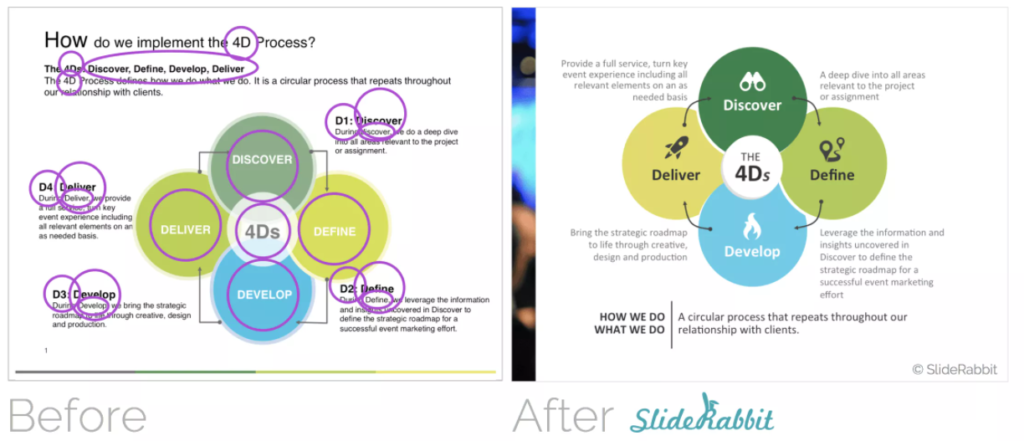
5. Use of charts and graphs
A presentation flooded with raw data and nothing eye-catchy will fail miserably to keep the audience engaged. Charts and graphs come to your rescue when your presentation is data intensive. Data, if presented in the raw form, fails to develop and sustain the target audience’s interest.
Let us say you are presenting before the head of sales department with the data on monthly sales of a product, region wise. There are 12 months and 20 regions for which you must display the data most comprehensively. A tabular representation will be okay until multiple locations and multiple period data are not involved. Post that, tabular data is an eyesore, and graphical representation is more appropriate.
The top management generally runs short of time and is keen on getting summarized information; use graphs and charts to summarize your data and give full yet concise information in a simplified manner.
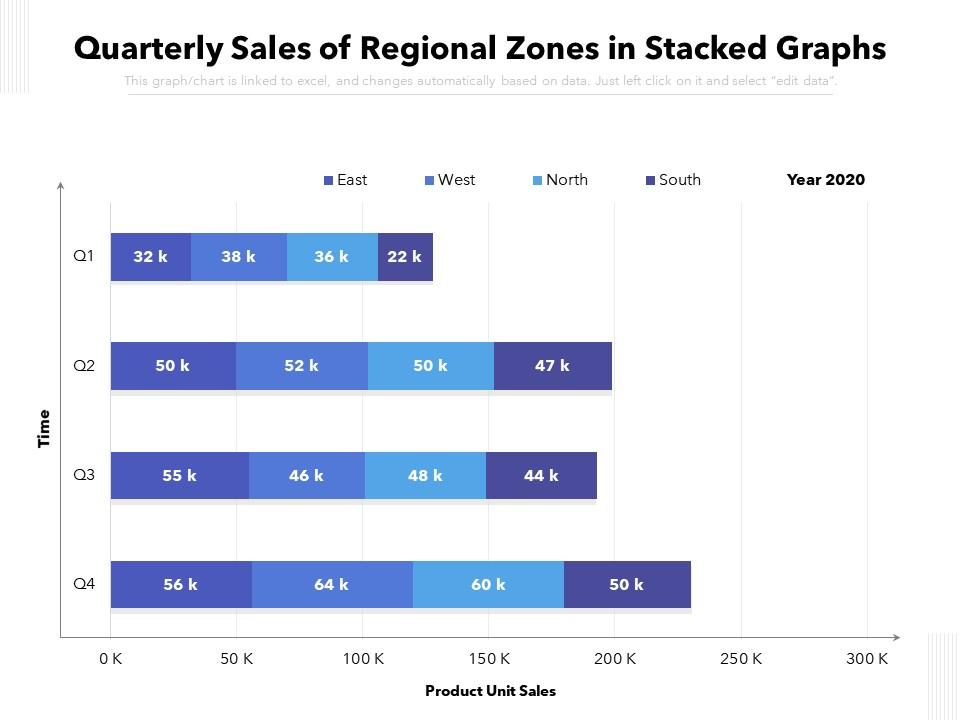
6. Structuring information
The flow of data across all slides should be smooth, and the transitions should be cohesive. Consistency is the key. You should not bombard the audience with a lot of data at the beginning of the slide or towards the end of the presentation.
There should be adequate pauses, breaks, and gaps in the data flow. Too much information is hard to process in a short span; hence, you should aim at structuring the entire information in such a manner so that the core message of your presentation reaches the audience.
Enough emphasis and time should be given to each slide of your presentation. You should have a key message at the end of each slide that briefly summarises the agenda of that particular slide so that the audience remembers and recollects all the information when needed.
7. Pictorial representations
A picture speaks a thousand words, and at the same time, it also helps you in avoiding a data-heavy presentation.
Pictorial representation of data is the most convenient and articulate way to deliver the desired information smartly.
For example, if you are explaining SWOT Analysis in your presentation, it is always advisable to use pictures rather than going for textual representation in the form of bullet points. A plain-text reading of what SWOT stands for is not pleasing to the eye. It is also less impactful when compared to a pictorial representation.
Maintaining a balance between textual and pictorial information should be maintained. Your audience should absorb the slides while still being attentive to what you are speaking.

8. Elimination to finalization
The moment you start gathering data for a presentation, you need to follow the elimination to finalization method. You need to jot down only the relevant points to be conveyed to the audience and chop off the remaining by editing the data.
For example, you must have gathered a lot of data relating to Mutual Funds but keeping in mind all the above points that we have discussed so far, you will have to edit and keep only the essential information in your presentation slides.
What to include in a presentation ? Include all relevant data such as types of mutual funds, modes of investments, schemes of investments, expense ratios, Net Asset Value (NAV) and exclude redundant data, heavy data involving statistics, data involving specific fund performances.
A smart presentation should be an easily-digestible, soothing meal without a heavy concoction of disrupting elements.
9. Examples and quotations
Any PowerPoint presentation is incomplete if you do not include sufficient examples to make your audience understand your point in a better manner.
Continuing with our example of a PowerPoint presentation on mutual funds, if you are delivering a presentation before prospective investors, you need to quote some real-life examples that will win their trust with investing money. This can include the past performance of a fund, real-life calculations of a past investor, etc.
You need motivation as the driving factor behind encouraging your audience to invest; hence, you should be quoting biggies from the investing world like Warren Buffett to make a powerful impact on the minds of your target audience.
10. The slide is to time ratio
Time management is a crucial factor when we talk about Presentation design tips. As a rule of thumb, you should be dedicating a minute per slide of your presentation.
However, in practice, this may vary. Certain slides, such as a slide with a comprehensive example, will require more time to be explained to the audience.
For example, if you are delivering a 10-minute PowerPoint presentation of 10 slides, you should try to allocate a minute to each slide and nothing more. Of course, if the slide can be managed with less time than a minute, you should not stretch it any further.
Too much information in too little time is as lethal as no information.
Thus, you should try and maintain an optimum ratio as far as the time is taken to explain each slide is concerned.
- Before even assimilating information for your PowerPoint presentation, always know your target audience in advance. Doing this ensures that you eliminate unnecessary data at the inception and changes your outlook towards building a presentation.
- Once you have finalized details about the target audience, the next best practice is to design the PowerPoint Presentation per your audience’s mix. The color theme, background, use of objects is taken care of in this step. The format should be per the type of audience being addressed.
- The topic of discussion should be clear in your head and your presentation. You should lay down the plan clearly so that the audience knows the topics being covered for them. This helps in building a connection with the audience at the onset. While walking them through the agenda, you can briefly touch base on points included therein to give them an overview of what to expect from the PowerPoint presentation.
- Let’s reiterate the positive impact that the absence of more textual information has on a PowerPoint presentation. A heavy, data-loaded presentation is always difficult for the audience to comprehend. So, keep your textual information to the bare minimum so that it just serves the need without impacting audience engagement.
- If you remove textual information, what is the other way to present it? Well, it is through pictures, graphs, and charts. Studies show that audience engagement is higher when the presentation includes more graphical elements than basic textual information.
- A power-packed presentation sometimes may fail to deliver its objective if it is not well-structured. Your presentation should flow smoothly in a chronological manner, sensing your audience’s emotions.
- Pictorial representations are an extension of what we have discussed in including more graphical information. While graphical information comes to the rescue while presenting complex data in a simplified manner, pictorial representation helps in removing the monotony of plain texts. Including pictures more often keeps the audience engrossed in the message being conveyed.
- Sometimes, while assimilating information for your presentation, you will feel overwhelmed with the amount of data you gather. The best way to keep only relevant information is to edit and eliminate irrelevant data. Make sure you stick to the agenda of your presentation.
- Real-life examples are always motivating, and we all feel genuinely connected with them. Quoting unrealistic case scenarios will burden the audience with something they can’t resonate with. Hence, you should always quote and share real-life examples wherever possible. In your presentation, a little motivational quote or a famous quote that people are aware of, here and there, establishes an instant connection with the audience.
- Lastly, always try to adhere to the time slide ratio. Remember not to spend too much time explaining things that won’t matter much to the audience. Explain in detail but not in-depth.
To sum it up, these ten extremely helpful presentation design tips will help you navigate the process step by step and will aid you in delivering appropriate information in the most lucid presentable manner.
Your presentation is the medium to provide information in an organized manner to the recipients seeking that information. If the design or format of the presentation is not comfortable for the audience, they will not be able to absorb the information at all. Hence, it is important to design the presentation so that the audience gets influenced and digests every fact that is served via the presentation.
Be creative, but don’t go overboard with it. Try to keep it simple and pleasing to the eyes. Try not to implement each element that you know of while preparing a PowerPoint presentation. Use subtle colors and background so that it is pleasant in appearance.
While deciding the target audience and the plan, you will realize that your PowerPoint presentation must be any of the below-mentioned types: Informative- Informative presentation is a presentation that intends to disseminate information to a group of people, such as a presentation on awareness on the spread of HIV. Instructional – Instructional presentation is a type of presentation that intends to educate, teach, and induce people to follow a path such as a presentation on using MS Office. Persuasive- Persuasive presentation is a kind of presentation that intends to induce a response from the audience, such as a presentation on Investing in Mutual Funds. Decision-making: A kind of presentation that intends to support or drive a decision, such as a presentation on prospective product marketing areas, is known as a decision-making presentation.
Ensure there is enough empty space in your slides, and the text is clearly visible. Make sure you use variations in font size and not in font type. You should use a neutral color palette as background and contrast; your slides shouldn’t appear to be carved out of a rainbow!
As a thumb rule, we should be allocating nothing more than a minute to each slide. If any slide requires a detailed explanation, the time should be balanced accordingly.
The best way to structure or start structuring a presentation is by setting a defined agenda. Once you chalk out an agenda, start working on the structure of the presentation by keeping only that information that is essential.
It depends on the kind of presentation that you are presenting. 1. If it is an informative presentation, you can conclude by taking up queries and questions from the audience. 2. If it is instructional in nature, you can ask questions to the audience to get a better idea of their understanding. 3. If the presentation is persuasive or a decision-making presentation, you can conclude by reiterating the selling point of the presentation.
Latest Blogs
In this blog, explore the golden rules of using AI marketing tools so you can leverage the benefits to their maximum potential.
In this blog, you’ll learn how to avoid the pitfalls of SEO over-optimization while enhancing your site’s performance.
In this article, we’ll take a look at what AMP is, its advantages and disadvantages, and how it affects SEO.
Get your hands on the latest news!
Similar posts.

9 mins read
Content Marketing vs Advertising – Which One is More Effective?

11 mins read
Interactive Content vs. Static Content: Which is More Effective?

6 mins read
Unlocking Success: 4 Case Studies of Successful Content Marketing Campaigns Using a Platform
- How it works

Writing a Summary – Explanation & Examples
Published by Alvin Nicolas at October 17th, 2023 , Revised On October 17, 2023
In a world bombarded with vast amounts of information, condensing and presenting data in a digestible format becomes invaluable. Enter summaries.
A summary is a brief and concise account of the main points of a larger body of work. It distils complex ideas, narratives, or data into a version that is quicker to read and easier to understand yet still retains the essence of the original content.
Importance of Summaries
The importance of summarising extends far beyond just making reading more manageable. In academic settings, summaries aid students in understanding and retaining complex materials, from textbook chapters to research articles. They also serve as tools to showcase one’s grasp of the subject in essays and reports.
In professional arenas, summaries are pivotal in business reports, executive briefings, and even emails where key points need to be conveyed quickly to decision-makers. Meanwhile, summarising skills come into play in our personal lives when we relay news stories to friends, recap a movie plot, or even scroll through condensed news or app notifications on our smartphones.
Why Do We Write Summaries?
In our modern information age, the sheer volume of content available can be overwhelming. From detailed research papers to comprehensive news articles, the quest for knowledge is often met with lengthy and complex resources. This is where the power of a well-crafted summary comes into play. But what drives us to create or seek out summaries? Let’s discuss.
Makes Important Things Easy to Remember
At the heart of summarisation is the goal to understand. A well-written summary aids in digesting complex material. By distilling larger works into their core points, we reinforce the primary messages, making them easier to remember. This is especially crucial for students who need to retain knowledge for exams or professionals prepping for a meeting based on a lengthy report.
Simplification of Complex Topics
Not everyone is an expert in every field. Often, topics come laden with jargon, intricate details, and nuanced arguments. Summaries act as a bridge, translating this complexity into accessible and straightforward content. This is especially beneficial for individuals new to a topic or those who need just the highlights without the intricacies.
Aid in Researching and Understanding Diverse Sources
Researchers, writers, and academics often wade through many sources when working on a project. This involves finding sources of different types, such as primary or secondary sources , and then understanding their content. Sifting through each source in its entirety can be time-consuming. Summaries offer a streamlined way to understand each source’s main arguments or findings, making synthesising information from diverse materials more efficient.
Condensing Information for Presentation or Sharing
In professional settings, there is often a need to present findings, updates, or recommendations to stakeholders. An executive might not have the time to go through a 50-page report, but they would certainly appreciate a concise summary highlighting the key points. Similarly, in our personal lives, we often summarise movie plots, book stories, or news events when sharing with friends or family.
Characteristics of a Good Summary
Crafting an effective summary is an art. It’s more than just shortening a piece of content; it is about capturing the essence of the original work in a manner that is both accessible and true to its intent. Let’s explore the primary characteristics that distinguish a good summary from a mediocre one:
Conciseness
At the core of a summary is the concept of brevity. But being concise doesn’t mean leaving out vital information. A good summary will:
- Eliminate superfluous details or repetitive points.
- Focus on the primary arguments, events, or findings.
- Use succinct language without compromising the message.
Objectivity
Summarising is not about infusing personal opinions or interpretations. A quality summary will:
- Stick to the facts as presented in the original content.
- Avoid introducing personal biases or perspectives.
- Represent the original author’s intent faithfully.
A summary is meant to simplify and make content accessible. This is only possible if the summary itself is easy to understand. Ensuring clarity involves:
- Avoiding jargon or technical terms unless they are essential to the content. If they are used, they should be clearly defined.
- Structuring sentences in a straightforward manner.
- Making sure ideas are presented in a way that even someone unfamiliar with the topic can grasp the primary points.
A jumble of ideas, no matter how concise, will not make for a good summary. Coherence ensures that there’s a logical flow to the summarised content. A coherent summary will:
- Maintain a logical sequence, often following the structure of the original content.
- Use transition words or phrases to connect ideas and ensure smooth progression.
- Group related ideas together to provide structure and avoid confusion.
Steps of Writing a Summary
The process of creating a compelling summary is not merely about cutting down content. It involves understanding, discerning, and crafting. Here is a step-by-step guide to writing a summary that encapsulates the essence of the original work:
Reading Actively
Engage deeply with the content to ensure a thorough understanding.
- Read the entire document or work first to grasp its overall intent and structure.
- On the second read, underline or highlight the standout points or pivotal moments.
- Make brief notes in the margins or on a separate sheet, capturing the core ideas in your own words.
Identifying the Main Idea
Determine the backbone of the content, around which all other details revolve.
- Ask yourself: “What is the primary message or theme the author wants to convey?”
- This can often be found in the title, introduction, or conclusion of a piece.
- Frame the main idea in a clear and concise statement to guide your summary.
List Key Supporting Points
Understand the pillars that uphold the main idea, providing evidence or depth to the primary message.
- Refer back to the points you underlined or highlighted during your active reading.
- Note major arguments, evidence, or examples that the author uses to back up the main idea.
- Prioritise these points based on their significance to the main idea.
Draft the Summary
Convert your understanding into a condensed, coherent version of the original.
- Start with a statement of the main idea.
- Follow with the key supporting points, maintaining logical order.
- Avoid including trivial details or examples unless they’re crucial to the primary message.
- Use your own words, ensuring you are not plagiarising the original content.
Fine-tune your draft to ensure clarity, accuracy, and brevity.
- Read your draft aloud to check for flow and coherence.
- Ensure that your summary remains objective, avoiding any personal interpretations or biases.
- Check the length. See if any non-essential details can be removed without sacrificing understanding if it is too lengthy.
- Ensure clarity by ensuring the language is straightforward, and the main ideas are easily grasped.
The research done by our experts have:
- Precision and Clarity
- Zero Plagiarism
- Authentic Sources

Dos and Don’ts of Summarising Key Points
Summarising, while seemingly straightforward, comes with its nuances. Properly condensing content demands a balance between brevity and fidelity to the original work. To aid in crafting exemplary summaries, here is a guide on the essential dos and don’ts:
Use your Own Words
This ensures that you have truly understood the content and are not merely parroting it. It also prevents issues of plagiarism.
Tip: After reading the original content, take a moment to reflect on it. Then, without looking at the source, write down the main points in your own words.
Attribute Sources Properly
Giving credit is both ethical and provides context to readers, helping them trace back to the original work if needed. How to cite sources correctly is a skill every writer should master.
Tip: Use signal phrases like “According to [Author/Source]…” or “As [Author/Source] points out…” to seamlessly incorporate attributions.
Ensure Accuracy of the Summarised Content
A summary should be a reliable reflection of the original content. Distorting or misrepresenting the original ideas compromises the integrity of the summary.
Tip: After drafting your summary, cross-check with the original content to ensure all key points are represented accurately and ensure you are referencing credible sources .
Avoid Copy-Pasting Chunks of Original Content
This not only raises plagiarism concerns but also shows a lack of genuine engagement with the material.
Tip: If a particular phrase or sentence from the original is pivotal and cannot be reworded without losing its essence, use block quotes , quotation marks, and attribute the source.
Do not Inject your Personal Opinion
A summary should be an objective reflection of the source material. Introducing personal biases or interpretations can mislead readers.
Tip: Stick to the facts and arguments presented in the original content. If you find yourself writing “I think” or “In my opinion,” reevaluate the sentence.
Do not Omit Crucial Information
While a summary is meant to be concise, it shouldn’t be at the expense of vital details that are essential to understanding the original content’s core message.
Tip: Prioritise information. Always include the main idea and its primary supports. If you are unsure whether a detail is crucial, consider its impact on the overall message.
Examples of Summaries
Here are a few examples that will help you get a clearer view of how to write a summary.
Example 1: Summary of a News Article
Original Article: The article reports on the recent discovery of a rare species of frog in the Amazon rainforest. The frog, named the “Emerald Whisperer” due to its unique green hue and the soft chirping sounds it makes, was found by a team of researchers from the University of Texas. The discovery is significant as it offers insights into the biodiversity of the region, and the Emerald Whisperer might also play a pivotal role in understanding the ecosystem balance.
Summary: Researchers from the University of Texas have discovered a unique frog, termed the “Emerald Whisperer,” in the Amazon rainforest. This finding sheds light on the region’s biodiversity and underscores the importance of the frog in ecological studies.
Example 2: Summary of a Research Paper
Original Paper: In a study titled “The Impact of Urbanisation on Bee Populations,” researchers conducted a year-long observation on bee colonies in three urban areas and three rural areas. Using specific metrics like colony health, bee productivity, and population size, the study found that urban environments saw a 30% decline in bee populations compared to rural settings. The research attributes this decline to factors like pollution, reduced green spaces, and increased temperatures in urban areas.
Summary: A study analysing the effects of urbanisation on bee colonies found a significant 30% decrease in bee populations in urban settings compared to rural areas. The decline is linked to urban factors such as pollution, diminished greenery, and elevated temperatures.
Example 3: Summary of a Novel
Original Story: In the novel “Winds of Fate,” protagonist Clara is trapped in a timeless city where memories dictate reality. Throughout her journey, she encounters characters from her past, present, and imagined future. Battling her own perceptions and a menacing shadow figure, Clara seeks an elusive gateway to return to her real world. In the climax, she confronts the shadow, which turns out to be her own fear, and upon overcoming it, she finds her way back, realising that reality is subjective.
Summary: “Winds of Fate” follows Clara’s adventures in a surreal city shaped by memories. Confronting figures from various phases of her life and battling a symbolic shadow of her own fear, Clara eventually discovers that reality’s perception is malleable and subjective.
Frequently Asked Questions
How long is a summary.
A summary condenses a larger piece of content, capturing its main points and essence. It is usually one-fourth of the original content.
What is a summary?
A summary is a concise representation of a larger text or content, highlighting its main ideas and points. It distils complex information into a shorter form, allowing readers to quickly grasp the essence of the original material without delving into extensive details. Summaries prioritise clarity, brevity, and accuracy.
When should I write a summary?
Write a summary when you need to condense lengthy content for easier comprehension and recall. It’s useful in academic settings, professional reports, presentations, and research to highlight key points. Summaries aid in comparing multiple sources, preparing for discussions, and sharing essential details of extensive materials efficiently with others.
How can I summarise a source without plagiarising?
To summarise without plagiarising: Read the source thoroughly, understand its main ideas, and then write the summary in your own words. Avoid copying phrases verbatim. Attribute the source properly. Use paraphrasing techniques and cross-check your summary against the original to ensure distinctiveness while retaining accuracy. Always prioritise understanding over direct replication.
What is the difference between a summary and an abstract?
A summary condenses a text, capturing its main points from various content types like books, articles, or movies. An abstract, typically found in research papers and scientific articles, provides a brief overview of the study’s purpose, methodology, results, and conclusions. Both offer concise versions, but abstracts are more structured and specific.
You May Also Like
In our vast world of information, conveying ideas in our own words is crucial. This brings us to the practice of “paraphrasing.”
Academic sources, also known as scholarly sources or academic references, are materials used by researchers, scholars, and students to support their academic work. These sources are specifically created for use in academic contexts and contribute to the body of knowledge in a particular field of study.
The vast sea of information is merely a click away in today’s fast-paced, digitally dominated world. With the proliferation of blogs, forums, news outlets, and social media platforms, anyone can become an ‘expert’ and share ‘facts’.
USEFUL LINKS
LEARNING RESOURCES

COMPANY DETAILS

- How It Works

Microsoft 365 Life Hacks > Presentations > How many slides does your presentation need?
How many slides does your presentation need?
When you’re creating a presentation, it’s important to consider the amount of information you’re sharing with your audience. You don’t want to overwhelm them, but you also want to be comprehensive and ensure that you’re covering all your bases. Whether you’re giving a 10, 15, or 30-minute presentation, see how many slides your presentation needs to get your point across.

Rules and guidance for PowerPoint presentations
PowerPoint is a powerful visual aid for introducing data, statistics, and new concepts to any audience. In PowerPoint, you can create as many slides as you want—which might sound tempting at first. But length doesn’t always guarantee a successful presentation . Most presentations last around 10-15 minutes, and anything longer than that (such as a 30-minute presentation) may have additional visual aids or speakers to enhance your message.
A handy rule to keep in mind is to spend about 1-2 minutes on each slide. This will give you ample time to convey your message, let data sink in, and allow you to memorize your presentation . When you limit each slide to this length of time, you also need to be selective about how much information you put on each slide and avoid overloading your audience.
For 10-minute presentations
Ten minutes is usually considered the shortest amount of time you need for a successful presentation. For a shorter 10-minute presentation, you’ll need to be selective with your content. Limit your slide count to approximately 7 to 10 slides.
For 15-minute presentations
When preparing for a 15-minute presentation, concise and focused content is key. Aim for around 10 to 15 slides to maintain a good pace, which will fit with the 1-2 minute per slide rule.
For 30-minute presentations
A longer presentation gives you more room to delve deeper into your topic. But to maintain audience engagement, you’ll need to add interactivity , audience participation, and elements like animations . Aim for around 20 to 30 slides, allowing for a balanced distribution of content without overwhelming your audience.

Tell your story with captivating presentations
Powerpoint empowers you to develop well-designed content across all your devices
Using the 10-20-30 rule
The 10-20-30 rule is an effective way to structure your presentation. It calls for no more than 10 slides and no longer than 20 minutes (as well as a 30-point font).
Tips for crafting an effective presentation
No matter how long a presentation is, there are guidelines for crafting one to enhance understanding and retention. Keep these tips in mind when creating your PowerPoint masterpiece:
- Avoid overload: Ensure that each slide communicates a single idea clearly, avoiding cluttered layouts or excessive text.
- Pay attention to structure: Think of slides as bullet points with introductions, endings, and deep dives within each subject.
- Add visual appeal: Incorporate images, charts, and graphics to convey information without using too many words to make your audience read.
- Engage with your audience: Encourage interaction through questions, polls, or storytelling techniques to keep your audience actively involved.
- Put in the practice: Familiarize yourself with your slides and practice your delivery to refine your timing and confidence.
Ultimately, the ideal number of slides for your presentation depends on the allocated time frame and how detailed your content is. By striking a balance between informative content and engaging delivery, you can create a compelling presentation that can teach your audience something new.
Get started with Microsoft 365
It’s the Office you know, plus the tools to help you work better together, so you can get more done—anytime, anywhere.
Topics in this article
More articles like this one.

How to introduce yourself in a presentation
Gain your audience’s attention at the onset of a presentation. Craft an impressionable introduction to establish tone, presentation topic, and more.

How to add citations to your presentation
Conduct research and appropriately credit work for your presentation. Understand the importance of citing sources and how to add them to your presentation.

How to work on a group presentation
Group presentations can go smoothly with these essential tips on how to deliver a compelling one.

How to create a sales presentation
Engage your audience and get them interested in your product with this guide to creating a sales presentation.

Everything you need to achieve more in less time
Get powerful productivity and security apps with Microsoft 365

Explore Other Categories

FactChecking the Biden-Trump Debate
In the first debate clash of the 2024 campaign, the two candidates unleashed a flurry of false and misleading statements.
By Robert Farley , Eugene Kiely , D'Angelo Gore , Jessica McDonald , Lori Robertson , Catalina Jaramillo , Saranac Hale Spencer and Alan Jaffe
Posted on June 28, 2024
Para leer en español, vea esta traducción de El Tiempo Latino.
The much-anticipated first debate of 2024 between President Joe Biden and former President Donald Trump featured a relentless barrage of false and misleading statements from the two candidates on immigration, the economy, abortion, taxes and more.
- Both candidates erred on Social Security, with Biden incorrectly saying that Trump “wants to get rid” of the program, and Trump falsely alleging that Biden will “wipe out” Social Security due to the influx of people at the border.
- Trump misleadingly claimed that he was “the one that got the insulin down for the seniors,” not Biden. Costs were lowered for some under a limited project by the Trump administration. Biden signed a law capping costs for all seniors with Medicare drug coverage.
- Trump warned that Biden “wants to raise your taxes by four times,” but Biden has not proposed anything like that. Trump was also mostly wrong when he said Biden “wants the Trump tax cuts to expire.” Biden said he would extend them for anyone making under $400,000 a year.
- Biden repeated his misleading claim that billionaires pay an average federal tax rate of 8%. That White House calculation factors in earnings on unsold stock as income.
- Trump repeated his false claim that “everybody,” including all legal scholars, wanted to end Roe v. Wade’s constitutional right to abortion.
- Trump falsely claimed that “the only jobs” Biden “created are for illegal immigrants and bounced back jobs that bounced back from the COVID.” Total nonfarm employment is higher than it was before the pandemic, as is the employment level of native-born workers.
- Biden claimed that Trump oversaw the “largest deficit of any president,” while Trump countered that “we now have the largest deficit” under Biden. The largest budget deficit was under Trump in fiscal year 2020, but that was largely because of emergency spending due to COVID-19.
- Biden misleadingly said that “Black unemployment is the lowest level it has been in a long, long time.” The rate reached a record low in April 2023, and it was low under Trump, too, until the pandemic.
- Biden said Trump called U.S. veterans killed in World War I “suckers and losers,” which Trump called a “made up quote.” The Atlantic reported that, based on anonymous sources. A former Trump chief of staff later seemed to confirm Trump said it.
- Trump claimed that Biden “caused the inflation,” but economists say rising inflation was mostly due to disruptions to the economy caused by the pandemic.
- Trump grossly inflated the number of immigrants who have entered the country during the Biden administration — putting the number at 18 million to 20 million — and he said, without evidence, that many of them are from prisons and mental institutions.
- Trump claimed that “we had the safest border in history” in the “final months” of his presidency. But apprehensions of those trying to cross illegally in the last three full months of his presidency were about 50% higher than in the three months before he took office.
- Biden criticized Trump for presiding over a loss of jobs when he was president, but that loss occurred because of the COVID-19 pandemic.
- Trump falsely claimed that “some states” run by Democrats allow abortions “after birth.” If it happened, it would be homicide, and that’s illegal.
- Trump made the unsupported claim that the U.S. border with Mexico is “the most dangerous place in the world,” and suggested that it has opened the country to a violent crime wave. The data show a reduction in violent crime in the U.S.
- Trump overstated how much food prices have risen due to inflation. Prices are up by about 20%, not double or quadruple.
- Trump boasted his administration “had the best environmental numbers ever.” Trump reversed nearly 100 environmental rules limiting pollution. Although greenhouse gas emissions did decline from 2019 to 2020, the EPA said that was due to the impacts of the pandemic on travel and the economy.
- Biden said he joined the Paris Agreement because “if we reach the 1.5 degrees Celsius, and then … there’s no way back.” Limiting global warming to 1.5 degrees would reduce the damages and losses of global warming, but scientists agree that climate action is still possible after passing the threshold.
- Trump said immigrants crossing the border illegally were living in “luxury hotels.” New York City has provided hotel and motel rooms to migrant families, but there is no evidence that they are being placed in “luxury” hotels.
- Trump falsely claimed that there was “no terrorism, at all” in the U.S. during his administration. There were several terrorist acts carried out by foreign-born individuals when he was president.
- While talking about international trade, Trump falsely claimed that the U.S. currently has “the largest deficit with China.” In 2023, the trade deficit in goods and services with China was the lowest it has been since 2009.
- Trump wrongly claimed that prior to the pandemic, he had created “the greatest economy in the history of our country.” That’s far from true using economists’ preferred measure — growth in gross domestic product.
- As he has many times before, Trump wrongly claimed, “I gave you the largest tax cut in history.” That’s not true either as a percentage of gross domestic product or in inflation-adjusted dollars.
- Trump contrasted his administration with Biden’s by misleadingly noting that when he left office, the U.S. was “energy independent.” The U.S. continues to export more energy than it imports.
The debate was hosted by CNN in Atlanta on June 27.
Social Security
Biden claimed that Trump “wants to get rid” of Social Security, even though the former president has consistently said he will not cut the program and has advised Republicans against doing so.

Earlier this year, Biden and his campaign based the claim on Trump saying in a March 11 CNBC interview that “there is a lot you can do in terms of entitlements in terms of cutting and in terms of also the theft and the bad management of entitlements.” As we’ve said , in context, instead of reducing benefits, Trump was talking about cutting waste and fraud in those programs — although there’s not enough of that to make the program solvent over the long term.
“I will never do anything that will jeopardize or hurt Social Security or Medicare,” Trump later said in a March 13 Breitbart interview . “We’ll have to do it elsewhere. But we’re not going to do anything to hurt them.”
During the GOP presidential primary, Trump also criticized some of his Republican opponents for proposing to raise the retirement age for Social Security, which budget experts have said would reduce scheduled benefits for those affected.
Some critics of Trump have argued that he cannot be expected to keep his promise because of his past budget proposals. But, as we’ve written , Trump did not propose cuts to Social Security retirement benefits.
Meanwhile, Trump claimed during the debate that Biden “is going to single handedly destroy Social Security” because of illegal immigration. “These millions and millions of people coming in, they’re trying to put them on Social Security. He will wipe out Social Security,” Trump said of Biden.
As we and others have explained before, immigrants who are not authorized to be in the U.S. aren’t eligible for Social Security. In fact, because many such individuals pay into Social Security via payroll taxes but cannot receive benefits, illegal immigrants bolster rather than drain the finances of the program.
In referring to what seniors pay for insulin, Trump misleadingly claimed, “I heard him say before ‘insulin.’ I’m the one that got the insulin down for the seniors. I took care of the seniors.” Insulin costs went down for some beneficiaries under a limited project under Trump; Biden signed a more expansive law affecting all seniors with Medicare drug coverage.
Under Trump, out-of-pocket costs were lowered to $35 for some Medicare Part D beneficiaries under a two-year pilot project in which some insurers could voluntarily reduce the cost for some insulin products. KFF, a nonpartisan health policy research organization, explained earlier this month that under this model, in effect from 2021 to 2023, “participating Medicare Part D prescription drug plans covered at least one of each dosage form and type of insulin product at no more than $35 per month,” and “less than half of all Part D plans chose to participate in each year.”
But in 2022, Biden signed a law that required all Medicare prescription drug plans to cap all insulin products at $35. The law also capped the out-of-pocket price for insulin that’s covered under Medicare Part B, which covers drugs administered in a health care provider’s office. The caps went into effect last year.
STAT, a news site that covers health care issues, reported that the idea for a $35 cap for seniors initially came from Eli Lilly, the pharmaceutical company, which proposed it in 2019.
Trump on Biden Tax Plan
“He’s the only one I know he wants to raise your taxes by four times,” Trump said of Biden. “He wants to raise everybody’s taxes by four times. He wants the Trump tax cuts to expire. So everybody … [is] going to pay four to five times – nobody ever heard of this before.”
Trump regularly warns of massive tax hikes for “everybody,” should Biden be reelected. That doesn’t jibe with anything Biden has proposed.
In his more than three years as president, Biden’s major tax changes have included setting a minimum corporate tax rate of 15% and lowering taxes for some families by expanding the child tax credit and, for a time, making it fully refundable, meaning families could still receive a refund even if they no longer owe additional taxes.
As we wrote in 2020, when Trump made a similar claim, Biden proposed during that campaign to raise an additional $4 trillion in taxes over the next decade, although the increases would have fallen mainly on very high-income earners and corporations. The plan would not have doubled or tripled people’s taxes at any income level (on average), according to analyses of Biden’s plan by the Penn Wharton Budget Model , the Tax Policy Center and the Tax Foundation .
In March 2023, the TPC’s Howard Gleckman wrote that Biden proposed a 2024 budget that would, on average, increase after-tax incomes for low-income households and “leave them effectively unchanged for middle-income households.” The Tax Policy Center noted, “The top 1 percent, with at least roughly $1 million in income, would pay an average of $300,000 more than under current law, dropping their after-tax incomes by 14 percent.”
This March, Biden released his fiscal year 2025 budget , which contains many of the same proposals and adds a few new wrinkles. But it still does not contain any “colossal tax hikes” on typical American families, as Trump has said.
Biden’s latest plan proposes — as he has in the past — to increase the corporate income tax rate from 21% to 28%, and to restore the top individual tax rate of 39.6% from the current rate of 37%. It would also increase the corporate minimum tax rate from 15% to 21% for companies that report average profits in excess of $1 billion over a three-year period. And the plan would impose a 25% minimum tax on very wealthy individuals. The plan also proposes to extend the expanded child tax credit enacted in the American Rescue Plan through 2025, and to make the child tax credit fully refundable on a permanent basis.
Trump is also mostly wrong that Biden “wants the Trump tax cuts to expire.”
As he has said since the 2020 campaign, Biden’s FY 2025 budget vows not to increase taxes on people earning less than $400,000.
In order to keep that pledge, Biden would have to extend most of the individual income tax provisions enacted in the Tax Cuts and Jobs Act that are set to expire at the end of 2025. And that’s what Biden says he would do — but only for individual filers earning less than $400,000 and married couples making less than $450,000. (In order to pass the TCJA with a simple Senate majority, Republicans wrote the law to have most of the individual income tax changes expire after 2025 .)
The Biden budget plan “would raise marginal income tax rates faced by higher earners and corporations while expanding tax credits for lower-income households,” according to a Tax Foundation analysis of the tax provisions in Biden’s budget. “The budget would redistribute income from high earners to low earners. The bottom 60 percent of earners would see increases in after-tax income in 2025, while the top 40 percent of earners would see decreases.”
Biden on Taxes Paid by Billionaires
In arguing that wealthy households should pay a minimum tax, Biden repeated his misleading claim that billionaires pay an average federal tax rate of 8%.
“We have a thousand … billionaires in America, and what’s happening?” Biden said . “They’re in a situation where they in fact pay 8.2% in taxes.”
That’s not the average rate in the current tax system; it’s a figure calculated by the White House and factors in earnings on unsold stock as income. When only considering income, the top-earning taxpayers, on average, pay higher tax rates than those in lower income groups, as we’ve written before.
The top 0.1% of earners pay an average rate of 25.1% in federal income and payroll taxes, according to an analysis by the Tax Policy Center in October 2022 for the 2023 tax year.
The point that Biden tried to make is that earnings on assets, such as stock, currently are not taxed until that asset is sold, which is when the earnings become subject to capital gains taxes. Until stocks and assets are sold, the earnings are referred to as “unrealized” gains. Unrealized gains, the White House has argued , could go untaxed forever if wealthy people hold on to them and transfer them on to heirs when they die.
Roe v. Wade
As he has before , Trump wildly exaggerated the popularity of ending Roe v. Wade — even going so far as to claim that it was “something that everybody wanted.”
“51 years ago, you had Roe v. Wade and everybody wanted to get it back to the states,” he said , referring to the 1973 Supreme Court ruling that established a constitutional right to abortion, which was overturned in 2022.
Trump: Everybody, without exception: Democrats, Republicans, liberals, conservatives. Everybody wanted it back — religious leaders. And what I did is I put three great Supreme Court justices on the court and they happened to vote in favor of killing Roe v. Wade, and moving it back to the states. This is something that everybody wanted. Now 10 years ago or so they started talking about how many weeks and how many this and getting into other things. But every legal scholar throughout the world — the most respected — wanted it brought back to the states. I did that.
In fact, a majority of Americans have disagreed with ending Roe v. Wade, including plenty of legal scholars, as we’ve explained before . While some scholars criticized aspects of the legal reasoning in Roe, it did not necessarily mean they wanted the ruling overturned. Legal experts told us that Trump’s claim was “utter nonsense” and “patently absurd.”
Trump Wrong on Jobs
After Biden talked about job creation during his administration, Trump falsely claimed that “the only jobs [Biden] created are for illegal immigrants and bounced back jobs that bounced back from the COVID.”
In fact, as of May, total nonfarm employment in the U.S. had gone up about 6.2 million from the pre-pandemic peak in February 2020, according to figures from the Bureau of Labor Statistics. The increase is about 15.6 million if you count from when Biden took office in January 2021 until now — but that would include some jobs that were temporarily lost during the pandemic and then came back during the economic recovery.
Furthermore, there is no evidence that only “illegal immigrants” have seen employment gains.
Since Biden became president in January 2021, employment of U.S.-born workers has increased more than employment of foreign-born workers, a category that includes anyone who wasn’t a U.S. citizen at birth, as we’ve written before . BLS says the foreign-born population includes “legally-admitted immigrants, refugees, temporary residents such as students and temporary workers, and undocumented immigrants.” There is no employment breakdown for just people in the U.S. illegally.
In looking at employment since the pre-pandemic peak, the employment level of foreign-born workers was up by about 3.2 million, from roughly 27.7 million in February 2020 to nearly 30.9 million in May. Employment for the U.S.-born population increased by about 125,000 — from nearly 130.3 million in February 2020 to 130.4 million, as of May.
Conflicting Budget Deficit Claims
Biden and Trump accused each other of presiding over the largest budget deficit in the U.S.
After talking about Trump’s plans for additional tax cuts, Biden said Trump already had the “largest deficit of any president in American history.” When he got a chance to respond, Trump said, “We now have the largest deficit in the history of our country under this guy,” referring to Biden.
Biden is correct: The largest budget deficit on record was about $3.1 trillion in fiscal year 2020 under Trump. However, that was primarily because of trillions of dollars in emergency funding that both congressional Republicans and Democrats approved to address the COVID-19 pandemic. Before the pandemic, the largest budget deficit under Trump was about $1 trillion in fiscal 2019.
Meanwhile, the most recent budget deficit under Biden was about $1.7 trillion in fiscal 2023. As of June, the nonpartisan Congressional Budget Office projected that the deficit for fiscal 2024, which ends on Sept. 30, would be about $2 trillion.
Black Unemployment
Biden boasted that on his watch, “Black unemployment is the lowest level it has been in a long, long time.”
It’s true that the unemployment rate for Black or African American people reached a record low of 4.8% in April 2023, but it is currently 6.1%, according to the Bureau of Labor Statistics, which has data going back to 1972.
Also, the unemployment rate was low under Trump, too, until the pandemic.
Under Trump, the unemployment rate for Black Americans went down to 5.3% in August 2019 – the lowest on record at that time. It shot up to 16.9% in April 2020, when the economic effects of the pandemic took hold. When Trump left office in January 2021, amid the pandemic, the rate was 9.3%.
The rate has been 6% or less in only 29 months since 1972, and it happened only under two presidents: 21 times under Biden and eight times under Trump.
‘Suckers and Losers’
Biden said Trump called U.S. veterans killed in World War I “suckers and losers,” which Trump called a “made up quote … that was in a third-rate magazine.”
It was first reported by a magazine — the Atlantic — but Trump’s former chief of staff, John F. Kelly , a retired four-star Marine general, later seemed to confirm it.
Biden was referring to a trip Trump made to France in November 2018, where he reportedly declined to visit the Aisne-Marne American Cemetery near the location of the Battle of Belleau Wood. “He was standing with his four-star general and he told him, ‘I don’t want to go in there because they’re a bunch of losers and suckers.’”
The Atlantic wrote about this alleged incident in 2020, citing unnamed sources. The magazine wrote that Trump made his remark about “losers” when he declined to visit the Aisne-Marne American Cemetery, and his remark about “suckers” during that same trip.
The Atlantic, Sept. 3, 2020: In a conversation with senior staff members on the morning of the scheduled visit, Trump said, “Why should I go to that cemetery? It’s filled with losers.” In a separate conversation on the same trip, Trump referred to the more than 1,800 marines who lost their lives at Belleau Wood as “suckers” for getting killed.
In October 2023, Kelly – who was on that trip and visited the Aisne-Marne Cemetery — gave a statement to CNN that seemed to confirm those remarks. CNN published Kelly’s statement.
CNN, Oct. 3, 2023: “What can I add that has not already been said?” Kelly said, when asked if he wanted to weigh in on his former boss in light of recent comments made by other former Trump officials. “A person that thinks those who defend their country in uniform, or are shot down or seriously wounded in combat, or spend years being tortured as POWs are all ‘suckers’ because ‘there is nothing in it for them.’ A person that did not want to be seen in the presence of military amputees because ‘it doesn’t look good for me.’ A person who demonstrated open contempt for a Gold Star family – for all Gold Star families – on TV during the 2016 campaign, and rants that our most precious heroes who gave their lives in America’s defense are ‘losers’ and wouldn’t visit their graves in France.”
Trump said, “We had 19 people who said I didn’t say it.” One of those who said that he didn’t hear Trump make those remarks is John Bolton, Trump’s former national security adviser who was also on the trip and said he was there when the decision was made not to visit the cemetery.
“I didn’t hear that,” Bolton told the New York Times in 2020 after the magazine story first appeared. “I’m not saying he didn’t say them later in the day or another time, but I was there for that discussion.”
Biden Misleads on Jobs
Biden ignored the economic impact of the COVID-19 pandemic when he criticized Trump for employment going down over Trump’s time in office.
“He’s the only president other than Herbert Hoover that lost more jobs than he had when he began,” Biden said.
Job growth during Trump’s term was positive until the economy lost 20.5 million jobs in April 2020, as efforts to slow the spread of the novel coronavirus led to business closures and layoffs. By the time Trump left office in January 2021, employment had partly rebounded, but was still 9.4 million jobs below the February 2020 peak, according to the Bureau of Labor Statistics .
Trump repeatedly claimed that Biden “caused the inflation” and that “I gave him a country with no essentially no inflation. It was perfect. It was so good.”
It’s true that inflation was relatively modest when Trump was president. The Consumer Price Index rose 7.6% under Trump’s four years — continuing a long period of low inflation. And inflation has been high over the entirety of Biden’s time in office. The Consumer Price Index for all items rose 19.3% between January 2021 and May.
For a time, it was the worst inflation in decades. The 12 months ending in June 2022 saw a 9% increase in the CPI (before seasonal adjustment), which the Bureau of Labor Statistics said was the biggest such increase since the 12 months ending in November 1981.
Inflation has moderated more recently. The CPI rose 3.3% in the 12 months ending in May, the most recent figure available.
Although Trump claims that Biden is entirely responsible for massive inflation, economists we have spoken to say Biden’s policies are only partly to blame. The economists placed the lion’s share of the blame for inflation on disruptions to the economy caused by the pandemic, including supply shortages, labor issues and increased consumer spending on goods. Inflation was then worsened by Russia’s attack on Ukraine, which drove up oil and gas prices, experts told us.
Indeed, inflation has been a worldwide problem post-pandemic.
However, many economists say Biden’s policies — particularly aggressive stimulus spending early in his presidency to offset some of the economic damage caused by the pandemic — played a modest role.
Jason Furman , a former economic adviser to President Barack Obama and now a Harvard University professor, told us in June 2022 that he estimated about 1 to 4 percentage points worth of the inflation was due to Biden’s stimulus spending in the American Rescue Plan — a $1.9 trillion pandemic relief measure that included $1,400 checks to most Americans; expanded unemployment benefits; and money for schools, small businesses and states. Mark Zandi , chief economist of Moody’s — whose work is often cited by the White House — said the impact of the stimulus measure now “has largely faded.”
Economists note that the American Rescue Plan came after two other pandemic stimulus laws enacted under Trump that were worth a total of $3.1 trillion. That spending, too, could have contributed to inflation.
Immigrants Entering U.S. Under Biden
Trump grossly inflated the number of immigrants who have entered the country during the Biden administration — putting the number at 18 million to 20 million. The number, by our calculation, is about a third of that. Trump also claimed, without evidence, that many of those immigrants are from prisons and mental institutions.
“It could be 18, it could be 19, and even 20 million people,” Trump said of the immigrants who have entered the U.S. during the Biden administration. Later in the debate, Trump asked Biden why there had been no accountability “for allowing 18 million people many from prisons, many from mental institutions” into the country.
That’s a greatly exaggerated number. We took a deep dive into the immigration numbers in February , and again in mid-June , and we came up with an estimate of at most a third of Trump’s number.
Here’s the breakdown:
Department of Homeland Security data show nearly 8 million encounters at the U.S.-Mexico border between February 2021, the month after Biden took office, and May, the last month of available statistics . That’s a figure that includes both the 6.9 million apprehensions of migrants caught between legal ports of entry – the number typically used for illegal immigration – and nearly 1.1 million encounters of migrants who arrived at ports of entry without authorization to enter the U.S.
DHS also has comprehensive data, through February, of the initial processing of these encounters. That information shows 2.9 million were removed by Customs and Border Protection and 3.2 million were released with notices to appear in immigration court or report to Immigration and Customs Enforcement in the future, or other classifications, such as parole. (Encounters do not represent the total number of people, because some people attempt multiple crossings. For example, the recidivism rate was 27% in fiscal year 2021, according to the most recent figures from CBP.)
As we’ve explained before , there are also estimates for “gotaways,” or migrants who crossed the border illegally and evaded the authorities. Based on an average annual apprehension rate of 78%, which DHS provided to us, that would mean there were an estimated 1.8 million gotaways from February 2021 to February 2024. The gotaways plus those released with court notices or other designations would total about 5 million.
There were also 407,500 transfers of unaccompanied children to the Department of Health and Human Services and 883,000 transfers to ICE. The ICE transfers include those who are then booked into ICE custody, enrolled in “ alternatives to detention ” (which include technological monitoring) or released by ICE. We don’t know how many of those were released into the country with a court notice. But even if we include those figures, it still doesn’t get us to anywhere near 18 to 20 million.
And we should note that these figures do not reflect whether a migrant may ultimately be allowed to stay or will be deported, particularly since there is a yearslong backlog of immigration court cases.
Also, as we have written repeatedly , Trump has provided no credible support for his incendiary claim that countries are emptying their prisons and mental institutions and sending those people to the U.S. Experts tell us they have seen no evidence to substantiate it.
Earlier this month, we looked into Trump’s claim as it relates to Venezuela, because Trump has repeatedly cited a drop in crime there to support his claim about countries emptying their prisons and sending inmates to the U.S. Reported crime is trending down in Venezuela, but crime experts in the country say there are numerous reasons for that — including an enormous out-migration of citizens and a consolidation of gang activity — and they have nothing to do with sending criminals to the U.S.
“We have no evidence that the Venezuelan government is emptying the prisons or mental hospitals to send them out of the country, whether to the USA or any other country,” Roberto Briceño-León, founder and director of the independent Venezuelan Observatory of Violence, told us.
Border Under Trump
Trump claimed that “we had the safest border in history” in the “final months” of his presidency, according to Border Patrol. But according to data provided by Customs and Border Protection, apprehensions of those trying to cross illegally into the U.S. in the last three full months of Trump’s presidency were about 50% higher than in the three months before he took office.
In fact, as we wrote in our piece, “ Trump’s Final Numbers ,” illegal border crossings, as measured by apprehensions at the southwest border , were 14.7% higher in Trump’s final year in office compared with the last full year before he was sworn in.
But these statistics tell only part of the story. The number of apprehensions fluctuated wildly during Trump’s presidency, from a monthly low of 11,127 in April 2017 to a high of 132,856 in May 2019.
Back in April, we wrote about a misleading chart that Trump showed to the crowd during a speech in Green Bay, Wisconsin. “See the arrow on the bottom? That was my last week in office,” Trump said. “That was the lowest number in history.” But Trump was wrong on both points.
The arrow was pointing to apprehensions in April 2020, when apprehensions plummeted during the height of the pandemic.
“The pandemic was responsible for a near-complete halt to all forms of global mobility in 2020, due to a combination of border restrictions imposed by countries around the world,” Michelle Mittelstadt , director of communications for the Migration Policy Institute, told us.
After apprehensions reached a pandemic low in April 2020, they rose every month after that. In his last months in office, apprehensions had more than quadrupled from that pandemic low and were higher than the month he took office.
Trump falsely claimed that “some states” run by Democrats allow abortions “after birth.” As we have written , that’s simply false. If it happened, it would be homicide , and that’s illegal .
“No such procedure exists,” the American College of Obstetricians and Gynecologists says on its website.
The former president has wrongly said that abortions after birth were permitted under Roe v. Wade — the Supreme Court ruling that established a constitutional right to abortion until it was reversed in 2022. It was not.
Under Roe, states could outlaw abortion after fetal viability, but with exceptions for risks to the life or health of the mother. Many Republicans have objected to the health stipulation, saying it would allow abortion for any reason. Democrats say exceptions are needed to protect the mother from medical risks. We should note, late-term abortions are rare . According to the Centers for Disease Control and Prevention , less than 1% of abortions in the U.S. in 2020 were performed after 21 weeks gestational time.
In June 2022, after Trump had appointed three conservative justices to the Supreme Court, the court overturned Roe in a 5-4 ruling. Biden supports restoring Roe as “the law of the land,” as he said in his State of the Union address in March.
Trump Calls Border ‘The Most Dangerous Place’
In his focus on the U.S. border with Mexico, Trump made the unsupported claim that it is “the most dangerous place in the world.”
It’s true that unauthorized border crossings can be dangerous — 895 people died while doing so in fiscal year 2022, which is the most recent year for which the Customs and Border Protection has data . Most of those deaths were heat related.
And the International Organization for Migration called calendar year 2022 “the deadliest year on record” for migration in the Americas, with a total of 1,457 fatalities throughout South America, Central America, North America and the Caribbean. The organization began tracking deaths and disappearances related to migration in 2014.
“Most of these fatalities are related to the lack of options for safe and regular mobility, which increases the likelihood that people see no other choice but to opt for irregular migration routes that put their lives at risk,” the organization said in its 2022 report .
Trump suggested that the border crossings imperil Americans when he went on to say, “these killers are coming into our country, and they are raping and killing women.”
But, as we’ve written before , FBI data show a downward trend in violent crime in the U.S., and there’s no evidence to support the claim that there’s been a crime wave driven by immigrants.
Crime analyst Jeff Asher, co-founder of the New Orleans firm AH Datalytics , told us in May that there’s no evidence in the data to indicate a migrant crime wave.
Similarly, Jeffrey Butts, director of the Research and Evaluation Center at the John Jay College of Criminal Justice, told the New York Times in February there was no evidence of a migrant crime wave in New York City after Texas Gov. Greg Abbott began busing migrants there in April 2022.
“I would interpret a ‘wave’ to mean something significant, meaningful and a departure from the norm,” Butts said at the time. “So far, what we have are individual incidents of crime.”
Also, it’s worth noting that the Institute for Economics and Peace’s Global Peace Index — which measures the safety of 163 countries based on 23 indicators, including violent crime, deaths from internal conflict and terrorism — said the “least peaceful country” is Afghanistan, followed by Yemen, Syria, South Sudan and the Democratic Republic of the Congo.
In discussing inflation, the former president embellished the degree to which food prices have increased.
“It’s killing people. They can’t buy groceries anymore,” Trump said. “You look at the cost of food, where it’s doubled, tripled and quadrupled. They can’t live.”
According to the Bureau of Labor Statistics, the Consumer Price Index for food has gone up 17.5% — not 100% to 300% — since January 2021. The Consumer Price Index specifically for groceries, or “food at home,” has risen 20.8% .
Climate Change
During a short exchange about climate change, Trump boasted that during his tenure “we had the best environmental numbers ever.” It is not clear what he was referring to exactly, but he said if elected president he wanted to have “absolutely immaculate clean water and I want absolutely clean air — and we had it.” He might have been referring to a talking point that Andrew Wheeler, Trump’s former Environmental Protection Agency administrator, had recommended Trump mention during the debate: “CO2 emissions went down” during his administration, as the Hill reported .
Greenhouse gas emissions, which are responsible for global warming, did decline from 2019 to 2020. But that was “largely due to the impacts of the coronavirus (COVID-19) pandemic on travel and economic activity,” according to the EPA. Emissions increased by 5.7% from 2020 to 2022, once the economy started getting reactivated again, the agency said.
According to an analysis by the New York Times , Trump’s administration reversed nearly 100 environmental rules, including 28 regulations on air pollution and emissions, and eight rules that limited water pollution. Reportedly, Trump recently asked oil executives and lobbyists to donate to his campaign, promising he would roll back other environmental rules that hurt fossil fuel interests.
“He’s not done a damn thing for the environment,” Biden said in response, pointing out that Trump had pulled the U.S. out of the Paris Agreement . “I immediately joined it because if we reach the 1.5 degrees Celsius … there’s no way back,” Biden said.
As we’ve reported , although reaching 1.5 degrees Celsius, or 2.7 degrees Fahrenheit, of warming comes with a number of very serious impacts, it is not a point of no return. Scientists agree that every increment of global warming increases these negative impacts, but 1.5 degrees is not a magic number after which everything is doomed, they say.
Immigrants Living in Hotels
During the debate, Trump mentioned twice that while immigrants crossing the border illegally were “living in luxury hotels,” in New York City and other cities “our veterans are living in the street.”
While it is true that New York City has provided hotel rooms to migrant families as a temporary shelter solution, there is no evidence that immigrants are being placed in “luxury” hotels.
In 2023, Mayor Eric Adams signed a $275 million contract with the Hotel Association of New York City to house 5,000 migrants. The deal was intended to help struggling hotels impacted by the pandemic and did not expect to include luxury hotels. “There are no gold-plated rooms that are being given away contrary to any reports that you may have seen,” the association president told NY1 at the time. In January, the city signed another $77 million contract to shelter migrant families in hotels.
In April, social media posts falsely claimed immigrants had stormed New York City Hall to demand luxury hotel accommodations. But as the Associated Press reported , the immigrants were there for a hearing about racial inequities in shelter and immigrant services.
In 2023, the number of veterans experiencing homelessness increased 7.4% from 2022, according to data from the Department of Housing and Urban Development. But homelessness among veterans has been declining in recent years, with a 4% overall reduction within the last three years alone.
Terrorist Attacks Under Trump
While talking about Iran and terrorism, Trump falsely claimed that “you had no terror, at all, during my administration.” As we’ve written , there were several acts of terrorism carried out by foreign-born individuals when Trump was in office.
For example, in October 2017, Sayfullo Saipov used a truck to run down people in New York City. He killed eight people, including Americans and tourists, in an attack carried out on behalf of the Islamic State.
Then in December 2017, Akayed Ullah detonated a homemade pipe bomb he was wearing inside a New York City subway station. Ullah told authorities he did it in response to U.S. airstrikes against the Islamic State in Syria and other places.
Then in December 2019 , Second Lt. Mohammed Saeed Alshamrani, a member of the Royal Saudi Air Force, shot 11 people at Florida’s Naval Air Station Pensacola, killing three U.S. sailors. Trump’s own attorney general, William Barr, called it an act of terrorism in January 2020. “The evidence shows that the shooter was motivated by jihadist ideology,” Barr said in a statement.
China Trade Deficit
When discussing U.S. trade relations with China, Trump said “we have the largest deficit with China.” That’s false, as we’ve written .
In 2023, the U.S. had a trade deficit with China in goods and services of roughly $252 billion, according to revised figures the Bureau of Economic Analysis released in early June. The deficit in goods trading was about $279 billion which was partially offset by a roughly $27 billion surplus in the trading of services — which can include travel, transportation, finance and intellectual property.
The trade gap with China last year was the lowest it had been since 2009, when it was $220 billion.
In fact, according to BEA data going back to 1999, the highest total U.S.-China trade deficit in goods and services was about $378 billion in 2018 — when Trump was president. Under Biden, the highest trade deficit with China was $366 billion in 2022.
Not ‘Greatest Economy’ Under Trump
Trump falsely said that prior to the pandemic, the U.S. had “the greatest economy in the history of our country. … Everything was locked in good.”
Trump’s boast about creating the “greatest economy in history” is ubiquitous in his campaign speeches. And it’s not true, at least not by the objective measure typically used to gauge the health of the economy.
As we have written , economists generally measure a nation’s health by the growth of its inflation-adjusted gross domestic product . Under Trump, growth was modest. Real GDP in Trump’s four years grew annually by 2.5% in 2017, 3% in 2018 and 2.5% in 2019 — before the economy went into a tailspin during the pandemic in 2020, when real GDP declined by 2.2%, according to the Bureau of Economic Analysis.
So, in the best year under Trump, U.S. real GDP grew annually by 3%. By contrast, the nation’s economy grew at a faster annual rate 48 times and under every president before and after Trump dating to 1930, except Barack Obama and Herbert Hoover. The economy grew at more than 3% six of Ronald Reagan’s eight years, including 7.2% in 1984, and it grew 5% or more 10 times under Franklin D. Roosevelt, including 18.9% in 1942. Under Biden , the GDP grew by 5.8% in 2021 — a post COVID-19 bounce-back — by 1.9% in 2022 and 2.5% in 2023.
Trump’s Was Not Largest Tax Cut in History
As he has many times before, Trump wrongly claimed, “I gave you the largest tax cut in history.” But saying this over and over, as Trump has for years, doesn’t make it any more true.
As we have been writing even before the 2017 Tax Cuts and Jobs Act was enacted into law, while the law provided tax relief to nearly all Americans, it was not the largest tax cut in U.S. history either as a percentage of gross domestic product (the measure preferred by economists) or in inflation-adjusted dollars.
According to a Tax Policy Center analysis , the law reduced the individual income taxes owed by Americans by about $1,260 on average in 2018. It also reduced the top corporate tax rate from 35% to 21% , beginning in January 2018.
The law signed by Trump was initially projected to cost $1.49 trillion over 10 years, according to the nonpartisan Joint Committee on Taxation . It could end up costing substantially more if individual tax provisions are extended past 2025. Over the first four years, the average annual cost was estimated to be $185 billion. That was about 0.9% of gross domestic product in 2018.
That’s nowhere close to President Ronald Reagan’s 1981 tax cut, which was 2.89% of GDP over a four-year average. That’s according to a 2013 Treasury Department analysis on the revenue effects of major tax legislation. Five more tax measures since 1940 had an impact larger than 1% of GDP, and the Committee for a Responsible Federal Budget includes a 1921 measure as also being larger than the 2017 plan. That’s eighth place for Trump’s “biggest tax cut in our history.”
In inflation-adjusted dollars, the Trump-era tax cut is also less than the American Taxpayer Relief Act of 2012, which comes in at No. 1 with a $320.6 billion cost over a four-year average. And it’s less than tax reductions in 2010 ($210 billion) and 1981 ($208 billion).
Energy Independence
Trump boasted, as he often does , that “on Jan. 6 [2021], we were energy independent,” implying that’s no longer the case under Biden. But by Trump’s definition, the country remains energy independent.
To be clear, under Trump, the U.S. never stopped importing sources of energy, including crude oil , from other countries. What he likely means is that the country either produced more energy than it consumed, or exported more energy than it imported. During Trump’s presidency, after years trending in that direction, the U.S. did hit a tipping point where exports of primary energy exceeded energy imports from foreign sources in 2019 and 2020 — the first times that had happened since 1952, according to the U.S. Energy Information Administration.
But contrary to Trump’s suggestion, that has continued in the Biden presidency. The U.S., during Biden’s presidency, has exported more energy, including petroleum , than it imported, and it has produced more energy than it consumed. Also, the U.S. is producing record amounts of oil and natural gas under Biden.
Editor’s note: FactCheck.org does not accept advertising. We rely on grants and individual donations from people like you. Please consider a donation. Credit card donations may be made through our “Donate” page . If you prefer to give by check, send to: FactCheck.org, Annenberg Public Policy Center, 202 S. 36th St., Philadelphia, PA 19104.
Bureau of Labor Statistics. “ Unemployment Rate – Black or African American .” Data extracted 27 Jun 2024.
Robertson, Lori. “ Biden’s Tax Rate Comparison for Billionaires and Schoolteachers .” FactCheck.org. 16 Feb 2023.
“ Average Effective Federal Tax Rates – All Tax Units, By Expanded Cash Income Percentile, 2023 .” Tax Policy Center. 14 Oct 2022.
Goldberg, Jeffrey. “ Trump: Americans Who Died in War Are ‘Losers’ and ‘Suckers’. ” 3 Sep 2020.
Baker, Peter and Maggie Haberman. “ Trump Faces Uproar Over Reported Remarks Disparaging Fallen Soldiers .” 4 Sep 2020.
Tapper, Jake. “ Exclusive: John Kelly goes on the record to confirm several disturbing stories about Trump .” CNN. 3 Oct 2023.
Leiserson, Greg and Danny Yagan. “ What Is the Average Federal Individual Income Tax Rate on the Wealthiest Americans? ” White House. 23 Sep 2021.
Budryk, Zack. “ Trump posts climate talking points online before debate with Biden ”. The Hill. 27 Jun 2024.
“ Climate Change Indicators: U.S. Greenhouse Gas Emissions .” EPA. Updated 27 Jun 2024.
Popovich, Nadja, et al. “ The Trump Administration Rolled Back More Than 100 Environmental Rules. Here’s the Full List. ” The New York Times. 20 Jan 2021.
Friedman,Lisa, et al. “ At a Dinner, Trump Assailed Climate Rules and Asked $1 Billion From Big Oil. ” The New York Times. 9 May 2024.
McGrath, Matt. “ Climate change: US formally withdraws from Paris agreement .” BBC. 4 Nov 2020.
Jaramillo, Catalina. “ Warming Beyond 1.5 C Harmful, But Not a Point of No Return, as Biden Claims .” FactCheck.org. 27 Apr 2023.
Zraick, Karen. “ How Manhattan Hotels Became Refuges for Thousands of Migrants .” New York Times. 23 Mar 2023.
Izaguirre, Anthony. “ New York City limiting migrant families with children to 60-day shelter stays to ease strain on city. ” AP. 16 Oct 2023.
Goldin, Melissa. “ No, immigrants did not storm New York City Hall in pursuit of luxury hotel rooms. ” 17 Apr 2024.
Lazar, David. “ Mayor signs $275 million deal with hotels to house migrants .” Spectrum News NY1. 15 Jan 2023.
Nahmias, Laura and Fola Akinnibi. “ NYC Pays Over $300 a Night for Budget Hotel Rooms for Migrants .” Bloomberg. 9 Jun 2023.
Adcroft, Patrick and Spectrum News Staff. “ New York City signs $77M contract with hotels to house migrant families .” Spectrum News. 24 Jan 2024.
Diaz, Monica. “ Veteran homelessness increased by 7.4% in 2023. ” VA News. 15 Dec 2023.
Robertson, Lori. “ Trump’s False Claim About Roe .” FactCheck.org. 9 Apr 2024.
U.S. Bureau of Labor Statistics. Consumer Price Index for All Urban Consumers: Food at Home in U.S. City Average . Retrieved from FRED, Federal Reserve Bank of St. Louis. Accessed 27 Jun 2024.
U.S. Bureau of Labor Statistics. Consumer Price Index for All Urban Consumers: Food in U.S. City Average . Retrieved from FRED, Federal Reserve Bank of St. Louis. Accessed 27 Jun 2024.
Farley, Robert. “ Trump’s Comments About ‘Cutting’ Entitlements in Context .” FactCheck.org. 15 Mar 2024.
Jaffe, Alan. “ Posts Misrepresent Immigrants’ Eligibility for Social Security Numbers, Benefits .” FactCheck.org. 26 Apr 2024.
Kessler, Glenn. “ No, Donald Trump, migrants aren’t ‘killing’ Social Security and Medicare .” Washington Post. 26 Mar 2024.
Federal Reserve Bank of St. Louis. All Employees, Total Nonfarm . Accessed 27 Jun 2024.
Federal Reserve Bank of St. Louis. Employment Level – Foreign Born . Accessed 27 Jun 2024.
Federal Reserve Bank of St. Louis. Employment Level – Native Born . Accessed 27 Jun 2024.
Robertson, Lori and D’Angelo Gore. “ FactChecking Trump’s Immigration-Related Claims in Phoenix and Las Vegas .” 17 June 2024.
Federal Reserve Bank of St. Louis. Federal Surplus or Deficit . Accessed 27 Jun 2024.
Congressional Budget Office. “ An Update to the Budget and Economic Outlook: 2024 to 2034 .” Jun 2024.
Gore, D’Angelo and Robert Farley. “ FactChecking Trump’s Iowa Victory Speech .” 18 Jan 2024.
U.S. Department of Justice, Office of Public Affairs. “ Sayfullo Saipov Charged With Terrorism and Murder in Aid of Racketeering in Connection With Lower Manhattan Truck Attack .” Press release. 21 Nov 2017.
U.S. Attorneys Office, Southern District of New York. “ Akayed Ullah Sentenced To Life In Prison For Bombing New York City Subway Station In 2017 On Behalf Of ISIS .” Press release. 22 Apr 2021.
LaForgia, Michael and Eric Schmitt. “ The Lapses That Let a Saudi Extremist Shoot Up a U.S. Navy Base .” New York Times. 21 Jun 2020.
Robertson, Lori. “ Familiar Claims in a Familiar Presidential Race .” FactCheck.org. 11 Apr 2024.
Cybersecurity and Infrastructure Security Agency. “ Joint Statement from Elections Infrastructure Government Coordinating Council & the Election Infrastructure Sector Coordinating Executive Committees .” 12 Nov 2020.
Cummings, William, Garrison, Joey and Sergent, Jim. “ By the numbers: President Donald Trump’s failed efforts to overturn the election .” USA Today. 06 Jan 2021.
Election Law at Ohio State. “ Major Pending Election Cases .” Accessed 28 Jun 2024.
GovInfo.gov. Transcript of hearing before the House Select Committee to Investigate the January 6th Attack on the United States Capitol. 13 Jun 2022.
Kiely, Eugene. “ Trump Ignored Aides, Repeated False Fraud Claims .” FactCheck.org. 14 Jun 2022.
Robertson, Lori. “ Breaking Down the Immigration Figures. ” FactCheck.org. 27 Feb 2024.
U.S. Customs and Border Protection. Southwest Land Border Encounters. Accessed 28 Jun 2024.
Department of Homeland Security. “ Alternatives to Detention .” Accessed 28 Jun 2024.
Farley, Robert. “ Trump’s Unfounded ‘Colossal’ Tax Hike Warning .” FactCheck.org. 17 Apr 2024.
Penn Wharton Budget Model. “ The Updated Biden Tax Plan .” 10 Mar 2020.
Tax Policy Center. “ An Analysis of Former Vice President Biden’s Tax Proposals .” 05 Mar 2020.
Watson, Garrett, and Li, Huaqun. “ Details and Analysis of President Joe Biden’s Campaign Tax Plan .” Tax Foundation. 22 Oct 2020.
White House Website. Biden’s Proposed Fiscal Year 2025 Budget . Accessed 28 Jun 2024.
Kiely, Eugene. “ A Guide to the Tax Changes .” FactCheck.org. 20 Dec 2017.
Tax Foundation. “ Details and Analysis of President Biden’s Fiscal Year 2025 Budget Proposal. ” 21 Jun 2024.
Congress.gov. Tax Cuts and Jobs Act. Introduced 20 Dec 2017.
Joint Committee on Taxation. “ Estimated Revenue Effects Of H.R. 1, The ‘Tax Cuts And Jobs Act.’ ” 06 Nov. 2017.
Gambino, Lauren, et al. “ The unprecedented situation at the US-Mexico border – visualized .” Guardian. 7 Feb 2024.
U.S. Customs and Border Protection. Border Rescues and Mortality Data . Updated 29 Mar 2024.
International Organization for Migration. The Americas — Annual Regional Overview . 2022.
Farley, Robert. “ Trump’s Bogus Attack on FBI Crime Statistics .” FactCheck.org. 3 Mar 2024.
Institute for Economics & Peace. Global Peace Index 2023 . June 2023.
For the claim about Trump and the national debt:
Fiscal Data. Debt to the Penny . fiscaldata.treasury.gov. Updated 27 Jun 2024.
Treasury Direct. FAQs About the Public Debt . Accessed 27 Jun 2024.
Robertson, Lori. “ Biden Leaves Misleading Impression on U.S. Debt .” FactCheck.org. 13 Aug 2021.
Congressional Budget Office. “ The Budget and Economic Outlook: 2017 TO 2027 .” Jan 2017.
Cubanski, Juliette and Tricia Neuman. “ The Facts About the $35 Insulin Copay Cap in Medicare .” KFF. 12 Jun 2024.
Poll Everywhere vs Mentimeter
Poll Everywhere vs Mentimeter: Which one is better in 2024?
17.06.2024 • 6 minutes

After two weeks of researching and testing Poll Everywhere, Mentimeter, and Wooclap, we found that each platform has unique strengths and ideal use cases.
Poll Everywhere is a simple web-based audience response system for creating surveys, live polls, and open-ended feedback forms without having to use a web form builder. It includes presentation features with slide controls, detailed engagement features, and standout performance reports. Although it’s very useful for making your presentations interactive, experienced presenters will need more. It has no live communication tools, its look seems outdated, and it relies heavily on third-party integrations.
Similarly, Mentimeter has interactive tools for gathering audience sentiment during live events and a handy feature for viewing presenter notes and remotely controlling slides. Like Poll Everywhere, most question types are designed to capture ideas and thoughts rather than for scoring and competition purposes. However, combined with its surgically clean UI, it’s a good choice for engaging participants in professional presentation settings like corporate meetings.
Neither platform perfectly balances presentation, interaction, and gamification, so we added Wooclap to the comparison.
Wooclap has everything the other two have, and more. Its diverse question types, fun but unobtrusive UI, presenter view, two-way interaction tools, and competitive mode make it perfect for higher-education lecturers and professional training environments to encourage active participation, boost knowledge retention, and conduct comprehensive assessments.
Let’s take a deeper dive into Poll Everywhere vs Mentimeter vs Wooclap to understand how they differ in the following key areas:
1. Event Management
2. Question Types
3. Integrations
We’ll also touch on reporting, ease of onboarding, and customer support in the comparison summary below to give you a comprehensive overview of each tool.
Comparison Summary: Poll Everywhere vs Mentimeter vs Wooclap
| Poll Everywhere | Mentimeter | Wooclap |
| ⭐️⭐️⭐️ and go up to (billed monthly) and are limited to 700 participants. Education plans are separate. | ⭐️⭐️ . Education plans go from . | ⭐️⭐️⭐️⭐️ . Business plans cost between . |
| ⭐️⭐️⭐️
| ⭐️⭐️⭐️
| ⭐️⭐️⭐️⭐️
|
| ⭐️⭐️
| ⭐️⭐️⭐️
| ⭐️⭐️⭐️⭐️
|
| ⭐️⭐️⭐️⭐️
| ⭐️⭐️
| ⭐️⭐️⭐️⭐️
|
| ⭐️⭐️⭐️
| ⭐️⭐️
| ⭐️⭐️⭐️⭐️ (like Blackboard, Canvas, Moodle, & BrightSpace). |
| ⭐️⭐️⭐️⭐️
| ⭐️⭐️⭐️⭐️
| ⭐️⭐️⭐️⭐️
|
| ⭐️⭐️⭐️⭐️
| ⭐️⭐️⭐️⭐️
| ⭐️⭐️⭐️⭐️
|
| ⭐️⭐️⭐️⭐️
| ⭐️⭐️⭐️⭐️
| ⭐️⭐️⭐️⭐️
|
| ⭐️⭐️⭐️⭐️
| ⭐️⭐️⭐️⭐️
| ⭐️⭐️⭐️⭐️
|
What is Poll Everywhere?
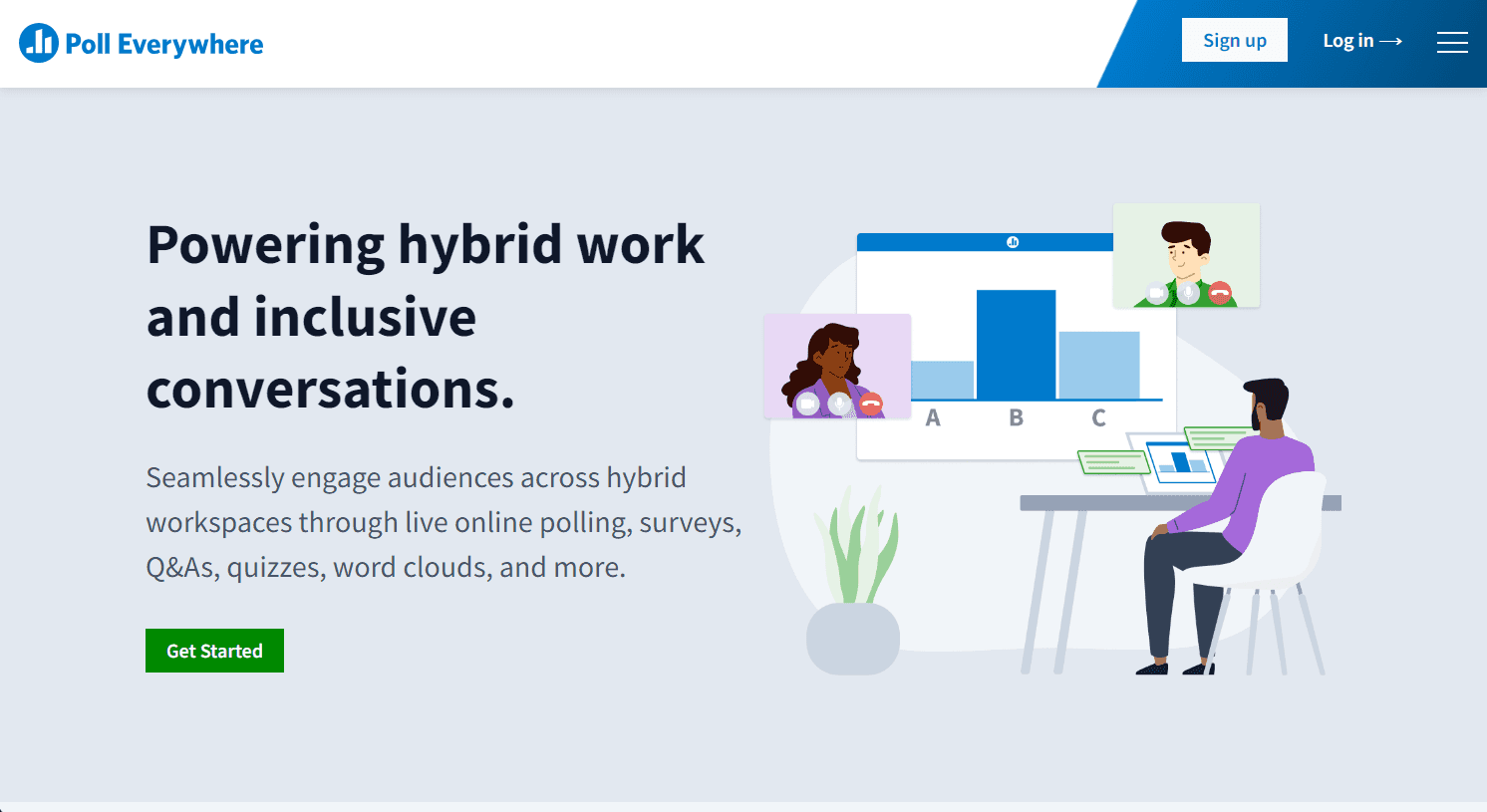
Poll Everywhere allows users to make interactive presentations with live polls, word clouds, quizzes, competitions, Q&As, and more. Most activity types let presenters engage their audience and gather responses, while the Competition activity fosters gamification with live quizzes. It supports multiple response methods: web browsers, text messages, mobile apps, and social media, ensuring accessibility for diverse audiences. After a presentation, you can generate detailed participation summaries and reports that emphasize both engagement and performance.
On its own, Poll Everywhere isn't meant for hosting events; for that, it has to be integrated with presentation software. However, it is excellent for creating polls, surveys, and open-ended feedback forms. This makes it ideal for presenters who need a quick and easy platform for interactive webinars and collecting audience feedback.
What is Mentimeter?
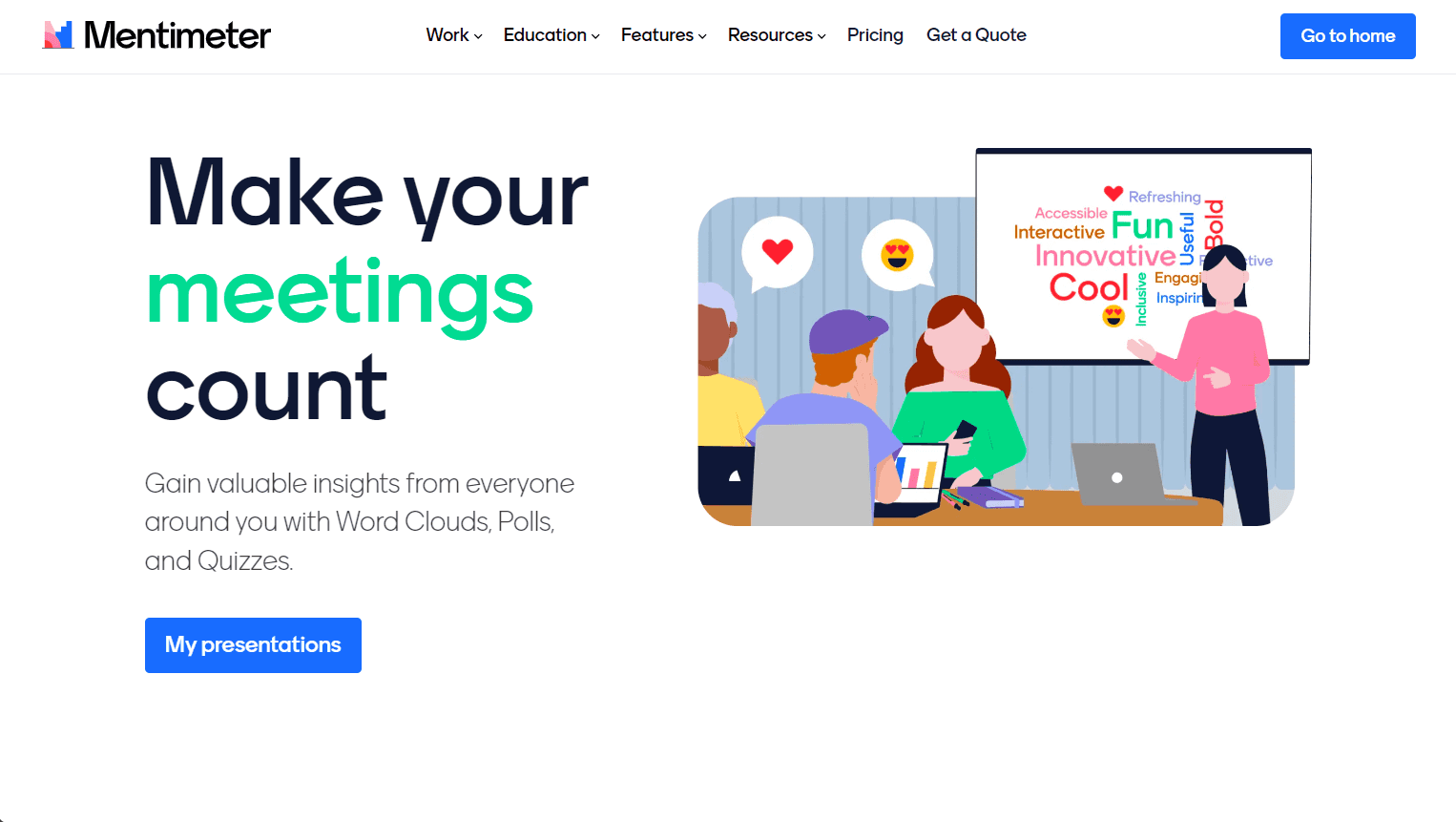
Mentimeter has interactive features, allowing presenters to receive real-time feedback, comments, and questions, or even gauge audience sentiment with emoji reactions. Presenters can also control slides and access notes remotely from desktops and mobile devices. Most of Mentimeter’s question types allow for discussions and gathering audience opinions, but a few support quizzes and competition.
These features make it ideal for corporate trainers, public event speakers, and professionals looking to improve audience engagement in workshops, seminars, and presentations.
What is Wooclap?
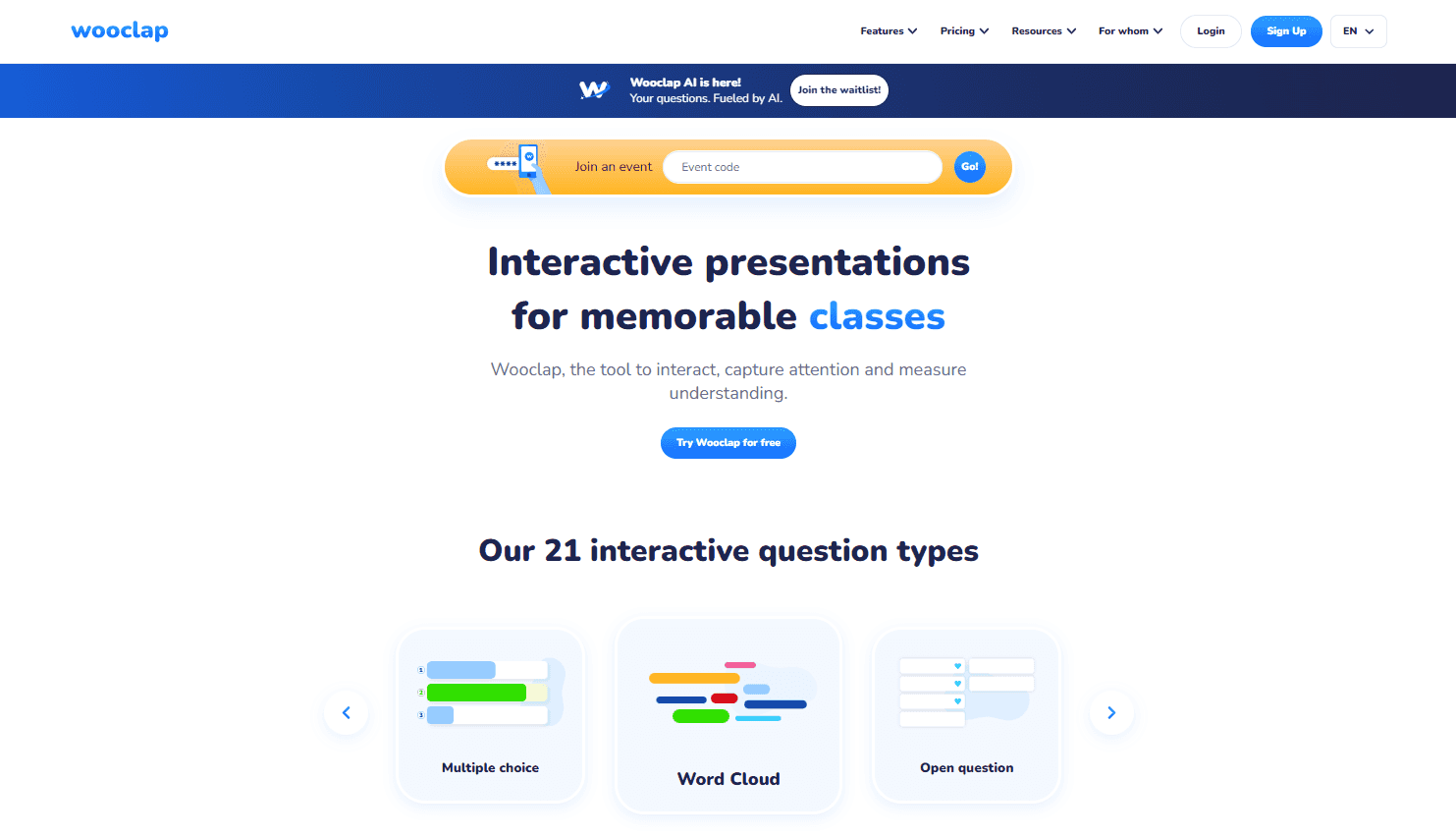
Wooclap shows its roots in neuroscience through tools based on modern learning best practices. Its diverse question types allow teachers to engage students with interactive exercises, encourage their knowledge retention, and gauge where they get confused in real time—thanks to the “ I am confused ” button. After a learning session, teachers get detailed reports on student performance and can send feedback to students. Wooclap also allows integrations with learning management system programs, enabling learning organizations to plug it into their curriculum seamlessly. Whether in-person or distance learning , Wooclap supports you through it all.
Wooclap supports some gamification features that teachers love, but most of its features are made to support higher education and business training where knowledge retention is the priority. Hence, its toolbox is designed for learning and understanding complex topics.
Poll Everywhere vs Mentimeter vs Wooclap: Event Management
| Poll Everywhere | Mentimeter | Wooclap |
| ⭐️⭐️⭐️⭐️ | ⭐️⭐️⭐️⭐️ | ⭐️⭐️⭐️⭐️⭐️ |
Mentimeter and Wooclap allow two-way interactions during live events, while Poll Everywhere settles for dedicated feedback activities.
Mentimeter gives you access to interactive tools for your live events.
Your audience can communicate with you through comments and Q&A sections if you enable them. They can also react to your slides using five emojis: thumbs up, thumbs down, heart, question mark, and a cat. This lets you see how they feel about your content on the go.
There's also a Mentimote feature that works like the Microsoft PowerPoint presenter view. You can use it to control slides and view presenter notes simultaneously. It also works from your phone, so you don't have to use a computer.
Mentimeter's presenter view has two menus at the bottom right and left. The left menu allows you to control the presentation, while the right one shows interaction options.
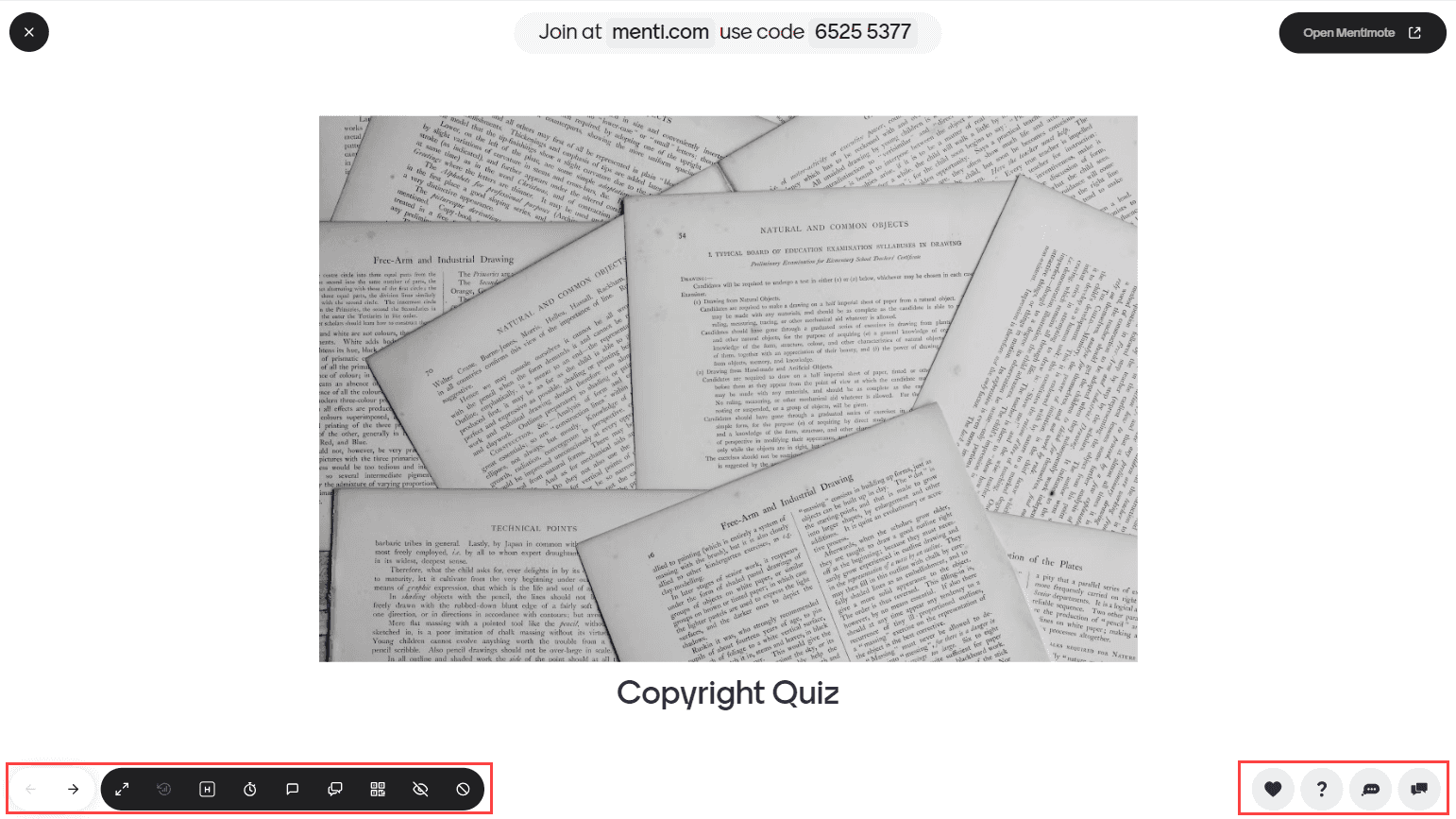
Wooclap 's live event features are robust and suitable for interactive learning.
It features real-time messaging where students can post text and images on the Message wall . This enables them to ask questions, share ideas, and provide feedback without speaking.
They can also like each other's messages, allowing you to see how many need help or support a particular idea.
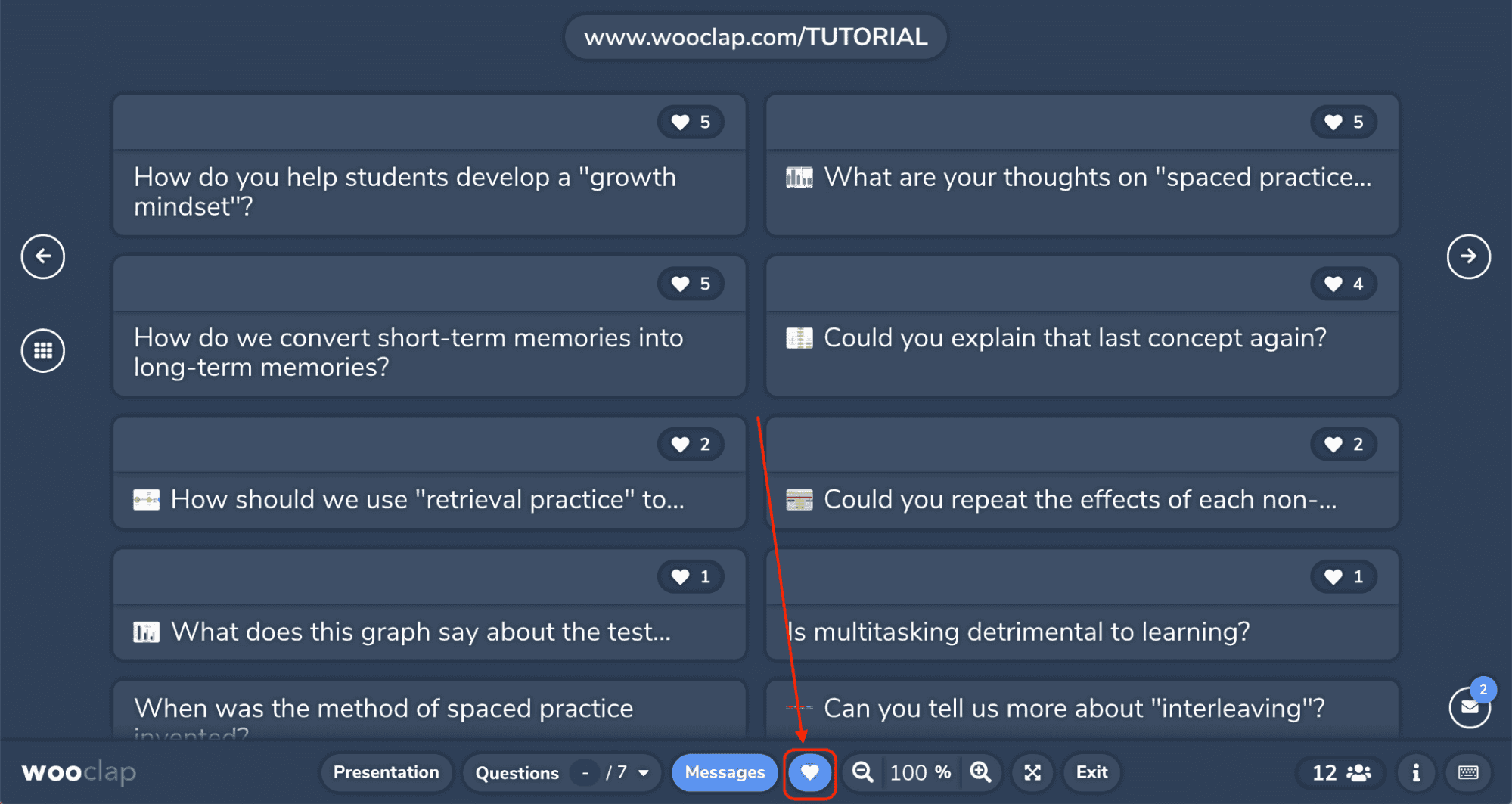
During presentations, you can assign custom labels for student questions to categorize and address them effectively. Additionally, you can design questionnaires for students to complete at their own pace during the event.
Wooclap also offers a unique interaction—the “ I am confused ” button—which allows students to anonymously express difficulties in following your presentation. The number of confused students is displayed in real time at the top of your presenter view and can be reset after issues are resolved.
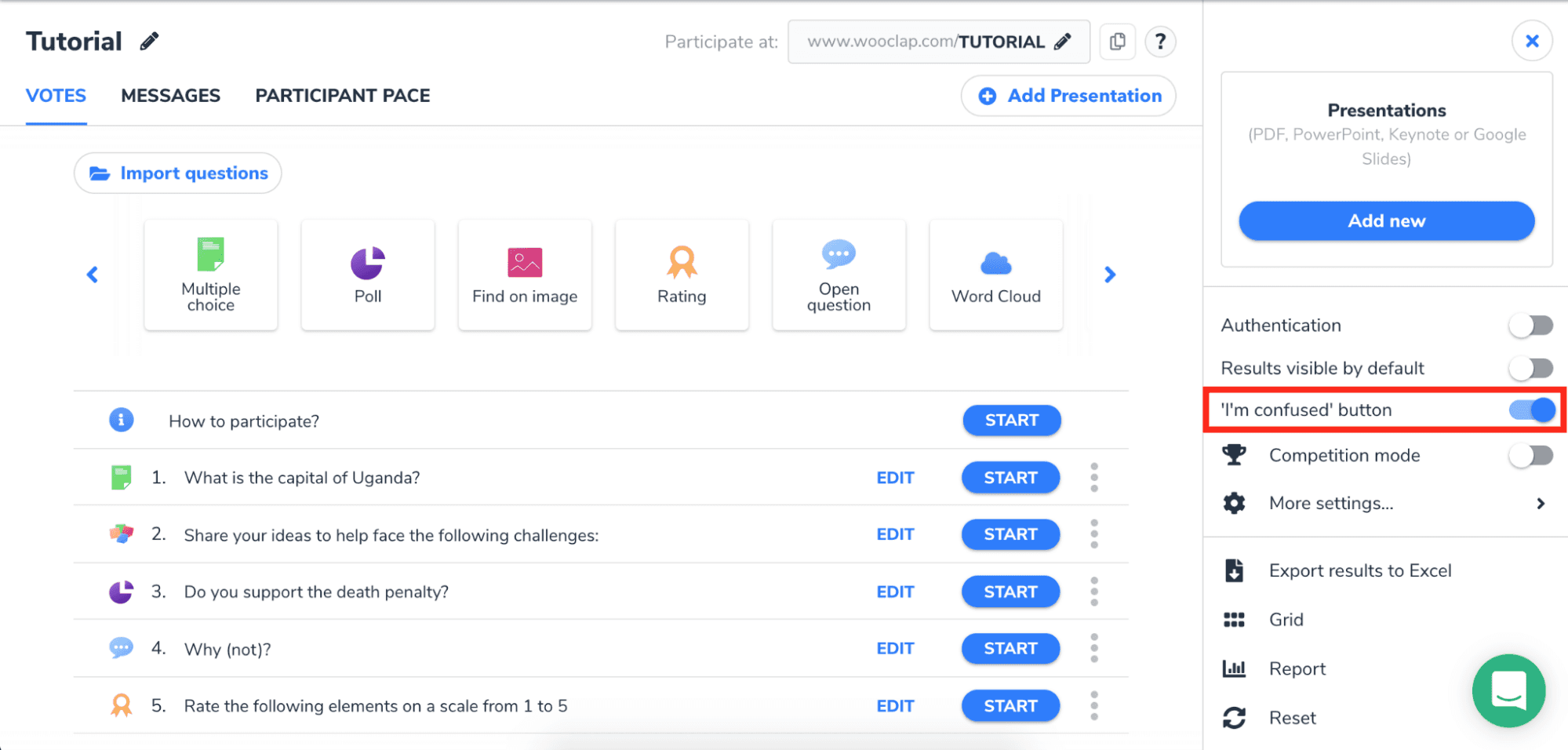
Poll Everywhere ’s approach to live interactions is quite different from Mentimeter and Wooclap.
Rather than incorporate feedback into presentations, you need to create dedicated feedback activities using options like Q&A, Presentation feedback, Short answers, and more. You can pin activities in the background and collect responses, while going forward to other questions.
While students generally can’t leave comments or reactions on the active slide, there’s an option to type custom responses on higher plans.
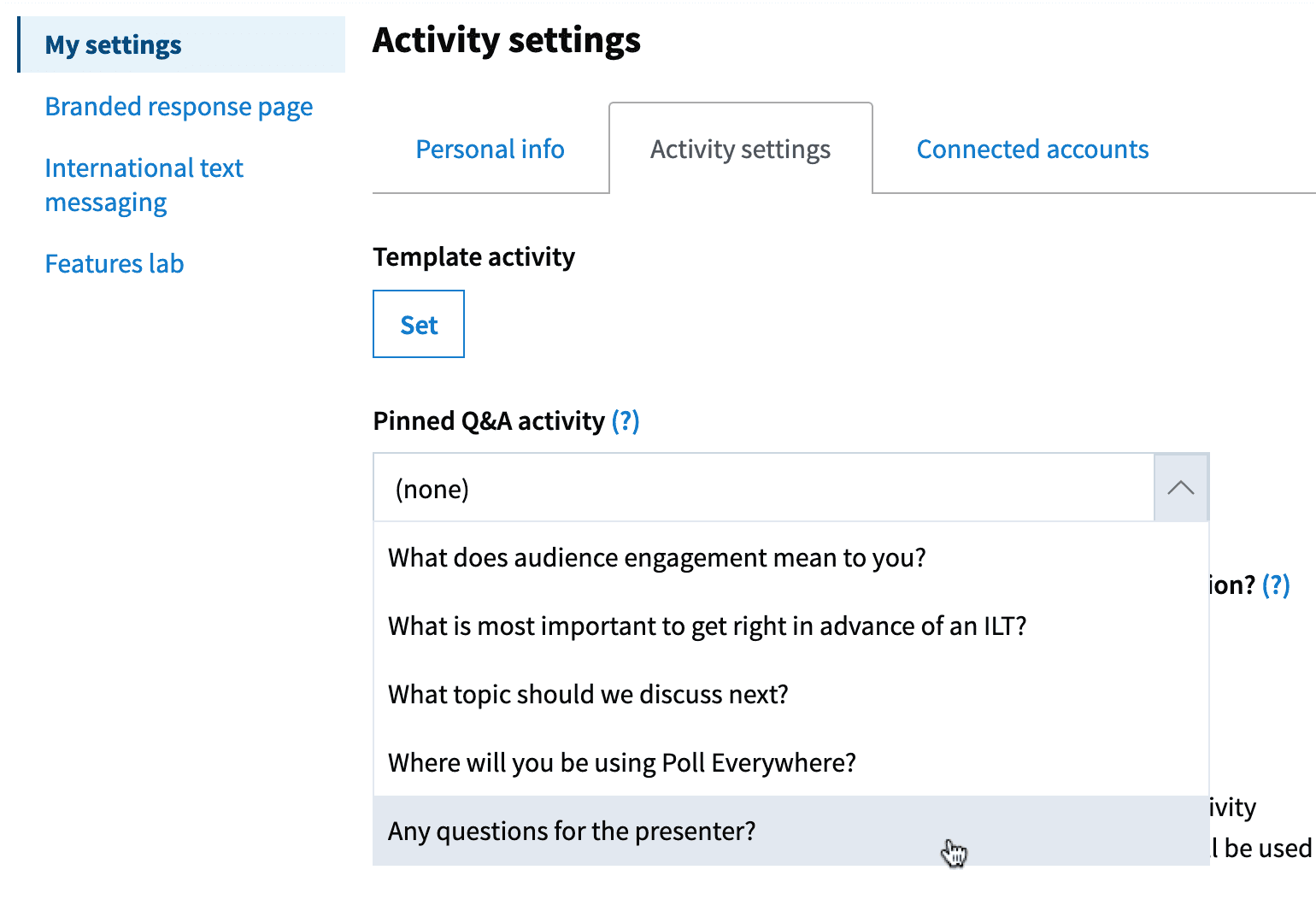
Wooclap's reports focus on performance, Mentimeter's focus on participation rates, and Poll Everywhere emphasizes both.
Mentimeter shows the percentage of participants who answered questions and their raw scores. But it doesn't detail how many got each question right.
The app stores all questions raised during an event and lets you export the data as a PDF. These features emphasize participation, making it more suitable for business settings.
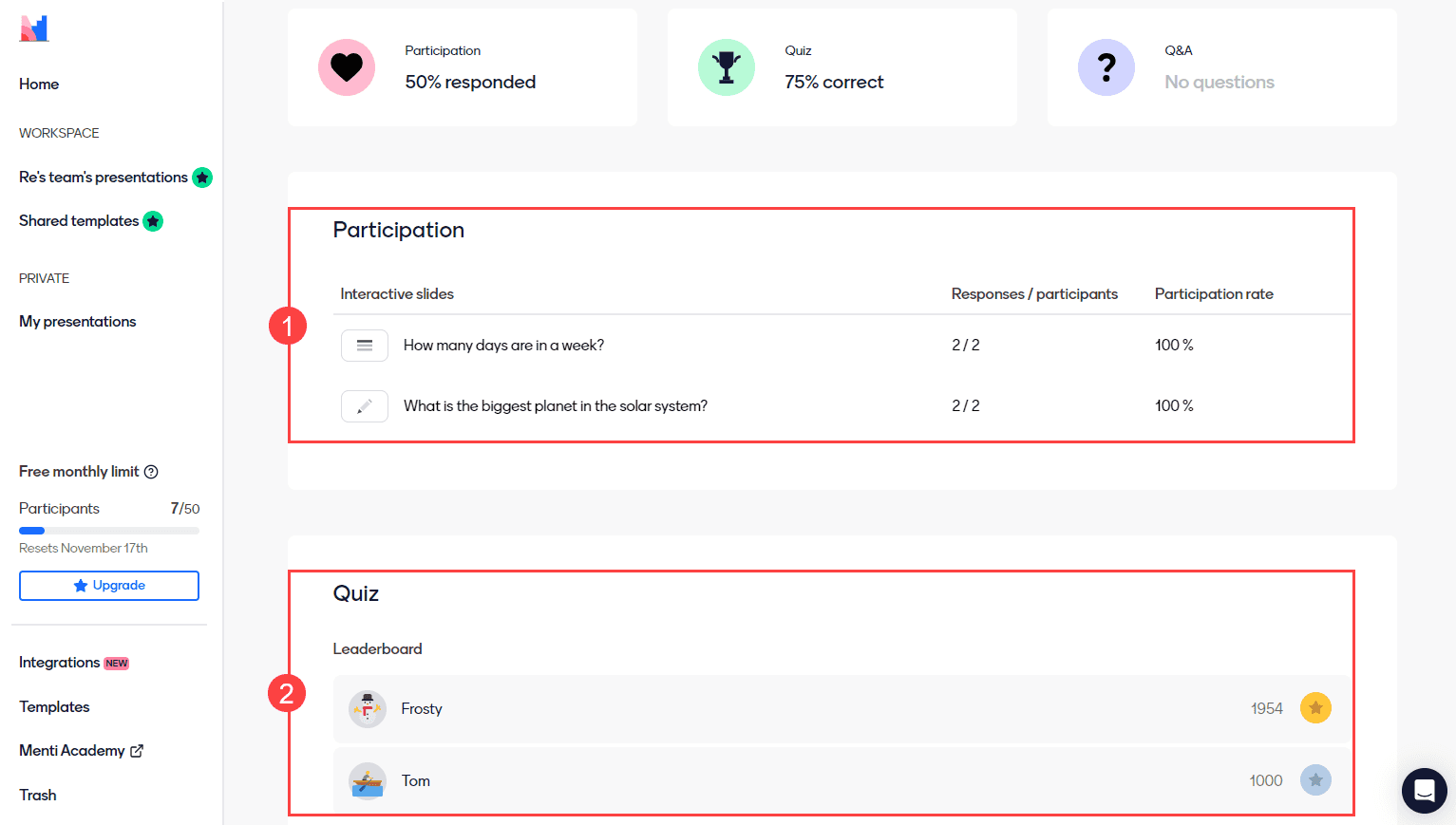
Like Mentimeter, Wooclap 's event report feature has Questions and Participants sections to track your student's understanding of each question.
Setting up an authentication system allows you to send personalized reports to participants with the click of a button, making it perfect for higher education, where students benefit from instant feedback after lectures. You can download the reports in Excel or PDF format.
Wooclap lets you review the entire event, check participants' performance for every question, analyze each participant's overall performance, and display data in a grid view.
With Poll Everywhere, you can generate different reports and export them as spreadsheets or screenshots. The reports include:
- Executive Summary — an overview of the total responses, participants, and engagement for all the activities you choose to include in the report.
- Participant Response History — the total number of responses, how individual participants responded to each activity, the means they used (web link or text), and the date and time of response.
- Audience Response Report — participant responses in sequence; each section is dedicated to a participant, with one line per question.
- Response Pivot Table — a detailed report of each response; can be used to group or compute sums and averages.
- Gradebook Report — a compact table showing a list of participants and how they performed during a quiz or presentation; you can export it directly to your learning management system (LMS) to sync your grade books.
You can customize the Executive summary, Participant response history, and Audience response report to show total responses, engagement, correctness, average responses, and aggregate results.
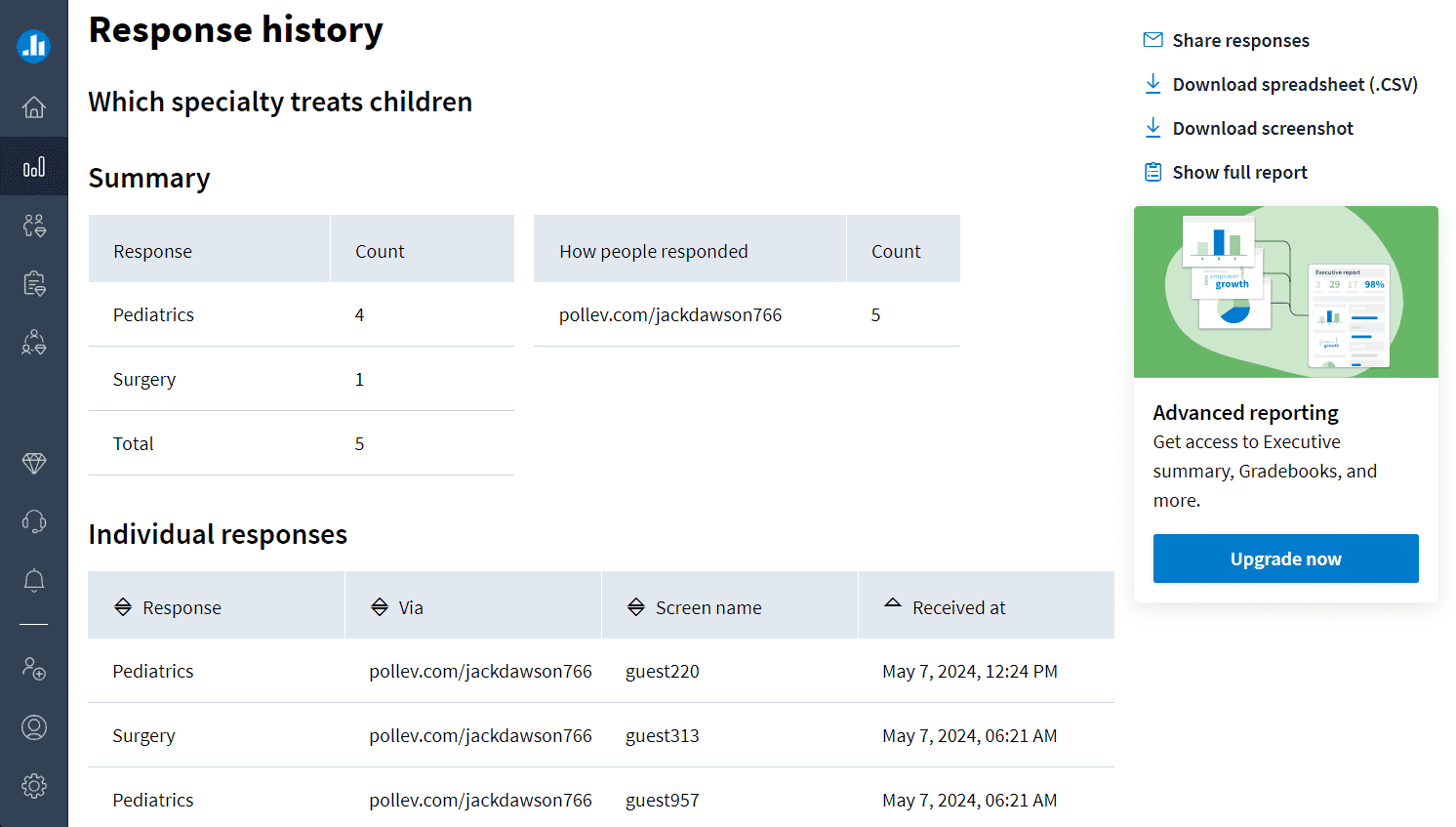
Wooclap has the perfect blend of live event management and performance-gauging tools, making it ideal for teaching, assessing, and grading students. Poll Everywhere ’s fragmentation of interactive features into distinct activities will appeal more to presenters collecting audience feedback. Meanwhile, Mentimeter ’s comments, Q&A sections, and emoji reactions during presentations encourage participation during business meetings.
Poll Everywhere vs Mentimeter vs Wooclap: Question Types
| Poll Everywhere | Mentimeter | Wooclap |
| ⭐️⭐️⭐️⭐️ | ⭐️⭐️⭐️ | ⭐️⭐️⭐️⭐️⭐️ |
Poll Everywhere has 8, Mentimeter has 13, and Wooclap has 21 question types.
Poll Everywhere has eight main question types with additional variations of the primary ones. The primary question types include the usual multiple-choice, open-ended, and word cloud questions, while the sub-types present unique questions like:
- Icebreaker, which you can use to lighten the mood by asking informal questions,
- and Restrospective for asking questions on past activities.
Most question types in Poll Everywhere collect audience responses. If you want your audience to compete, use the Competition question type (more on this below).
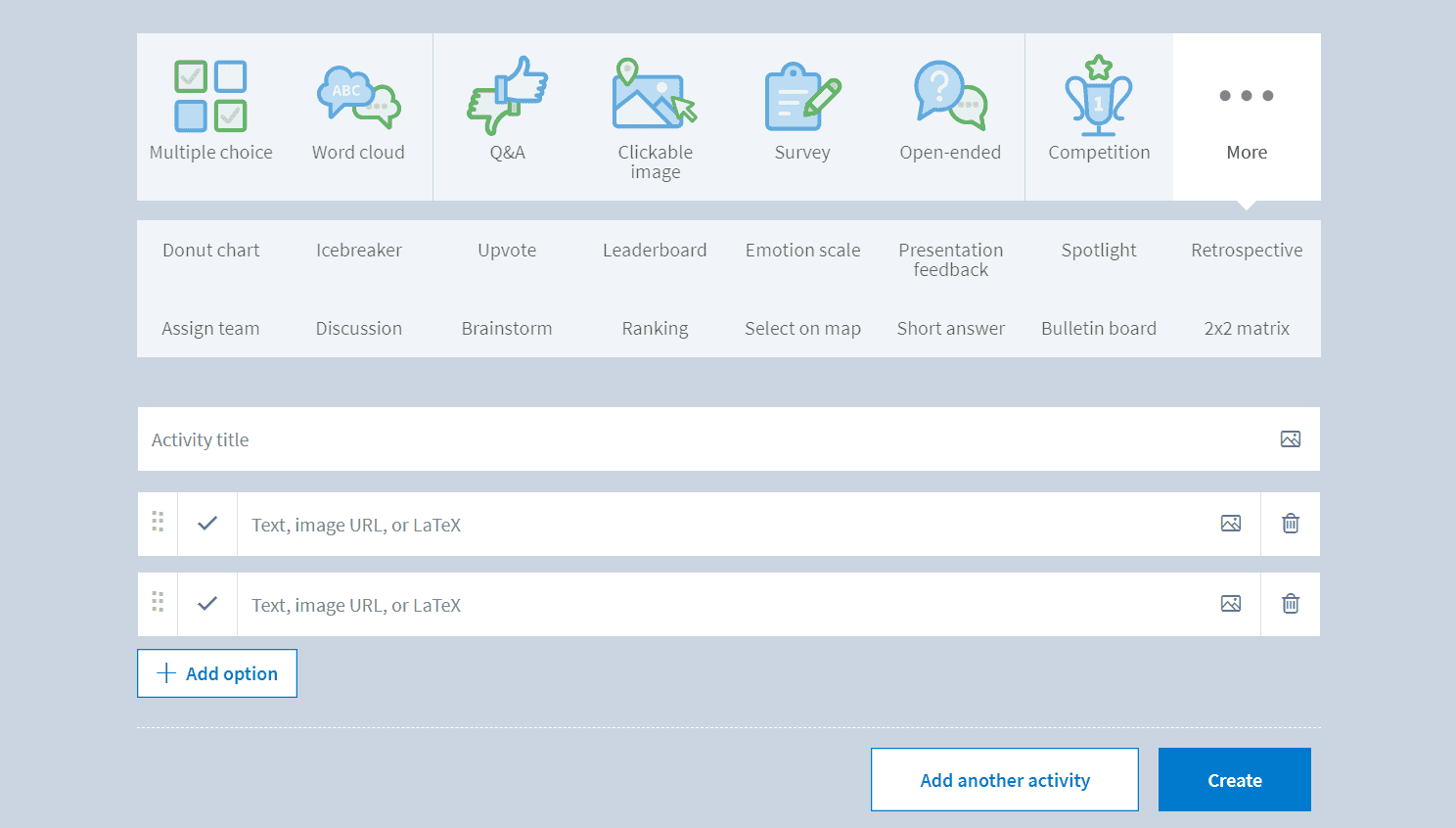
Like Poll Everywhere, Mentimeter 's 13 question types include multiple choice, open-ended, word cloud, Q&A, pin on image, and ranking. But they only gather audience responses.
To make your audience compete and engage with your presentation, you need to use one of the two quiz competitions: ‘select answer’ and ‘type answer’.
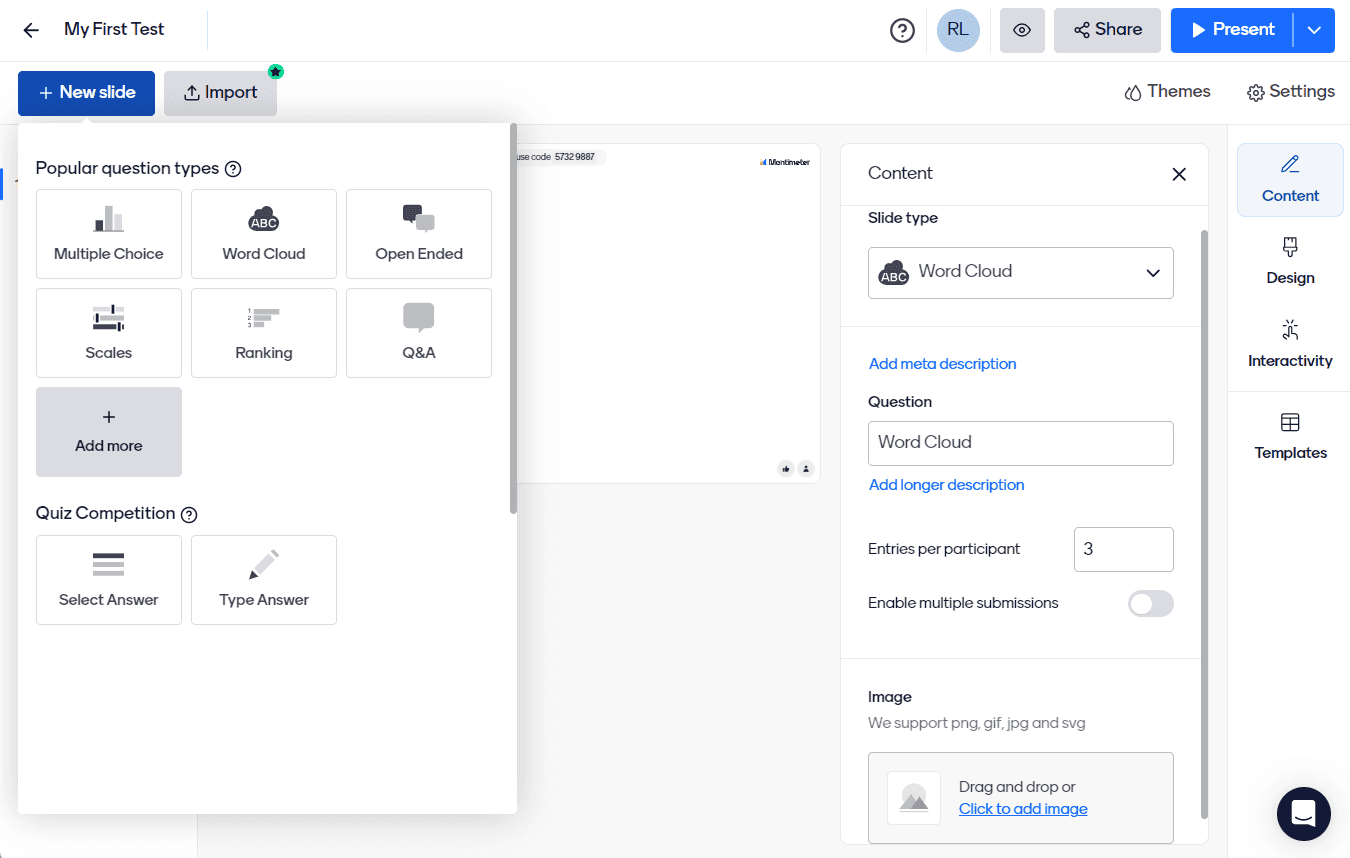
Wooclap has 21 question types for gathering students' feedback and testing their knowledge and understanding.
While some are similar to Mentimeter and Poll Everywhere's key question types, Wooclap offers some unique options. These include:
- ‘Matching’, for students to pair related items;
- ‘Fill in the blanks’ to test students' ability to complete sentences;
- and ‘Label an image’ to test knowledge on diagrams and pictures.
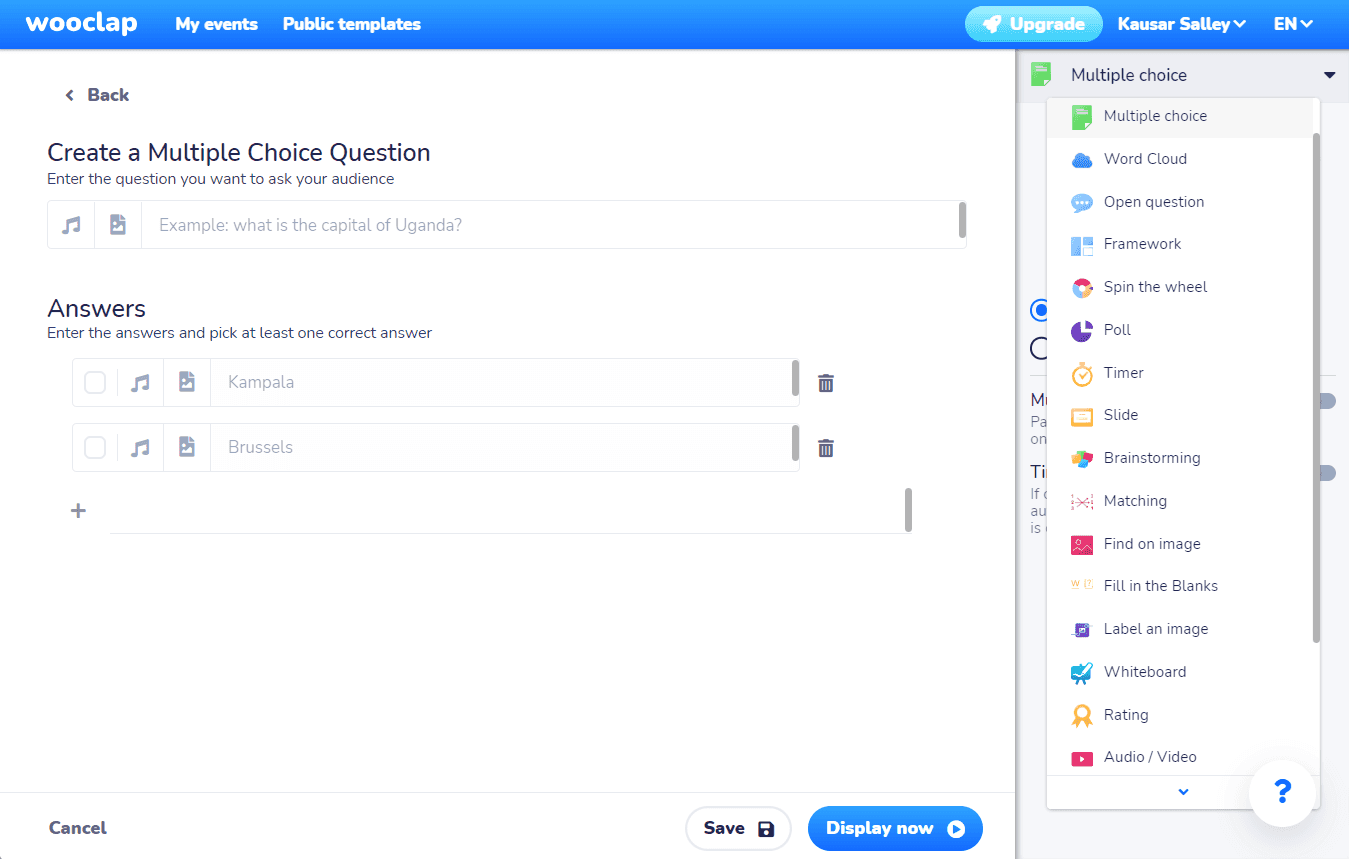
Aside from the diverse types of questions for learning, Wooclap also has question types for brainstorming and workshop settings. The two notable ones are:
- Brainstorming — lets you create interactive boards for users to collaboratively express their ideas and thoughts (shown in the screenshot below).
- Framework — uses predefined categories to make group collaboration better. It guides users' contributions, allowing for a more structured and focused group discussion.
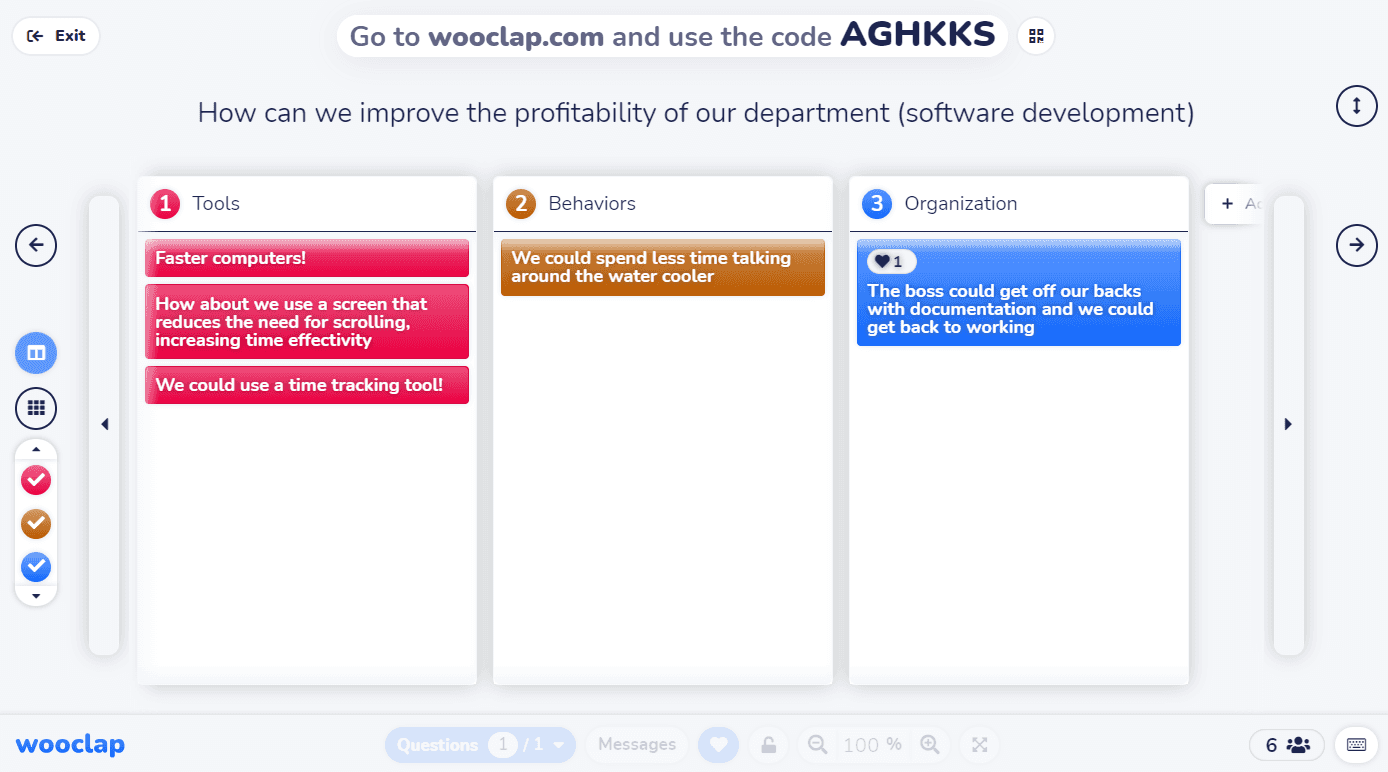
Mentimeter and Poll Everywhere's gamification settings are rigid, while Wooclap's are more flexible.
Mentimeter lets you time each quiz question to make it more fun and challenging.
Unlike Wooclap and Poll Everywhere, which automatically allocate more points to faster participants, Mentimeter lets you turn the feature on or off.
You can also display a leaderboard after every question or only at the end of the quiz to show the visualization of rankings and cumulative points for the top 10 participants.
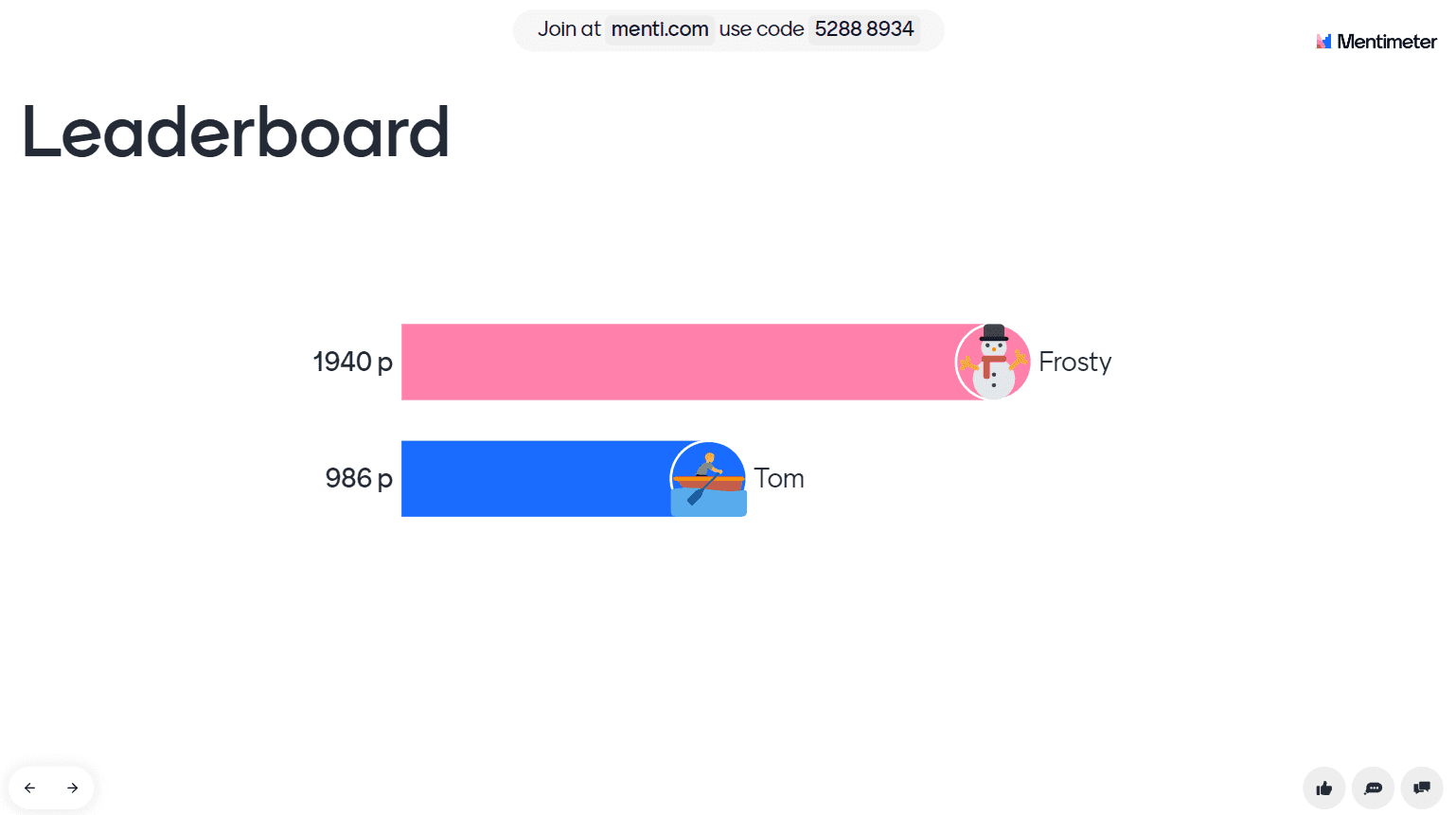
Wooclap 's features are similar to Mentimeter. However, Wooclap has an extra feature to set the same time for all questions, so you don't have to go through the tedious process of setting it up for every question.
Also, Wooclap's competition mode gives you control over when and how to display rankings on leaderboards. For example, you can show the scores of the top 3, 5, 10, or 15 participants on your screen with the toggle of a button. Meanwhile, participants see their rank and score on their screens.

Poll Everywhere 's competition activity has similar features. However, it allows you to set a time limit for the event, after which participants can no longer answer a question.
Unlike Wooclap, there's no special leaderboard customization, but you see the top participants in order of points obtained. Participants can also see their scores and their position on the leaderboard.
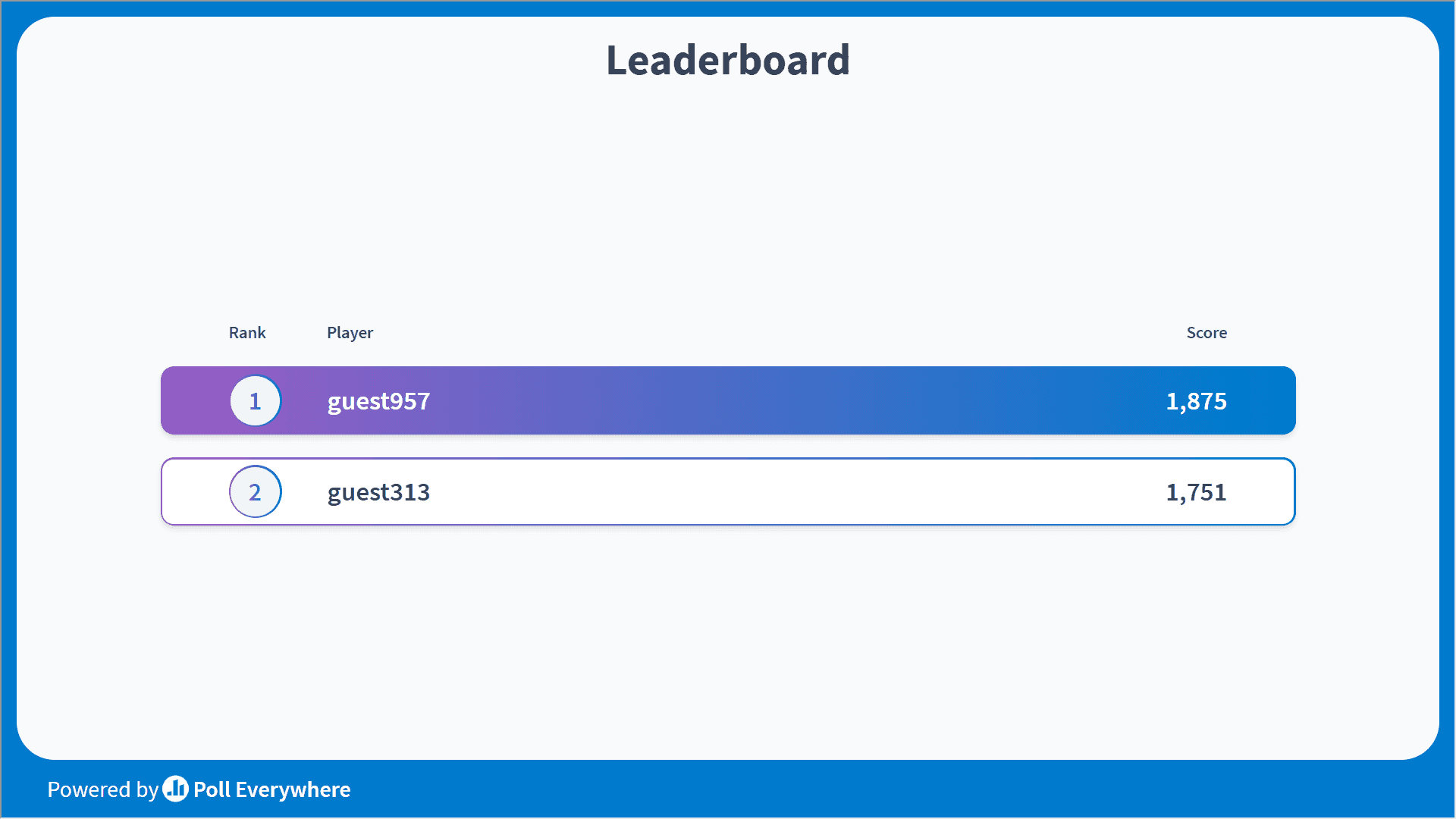
Mentimer's event templates focus on business events, while Wooclap and Poll Everywhere's range from business to education and everything in between.
Mentimeter has 28 templates , mainly designed for business scenarios like team meetings, team building, and training sessions.
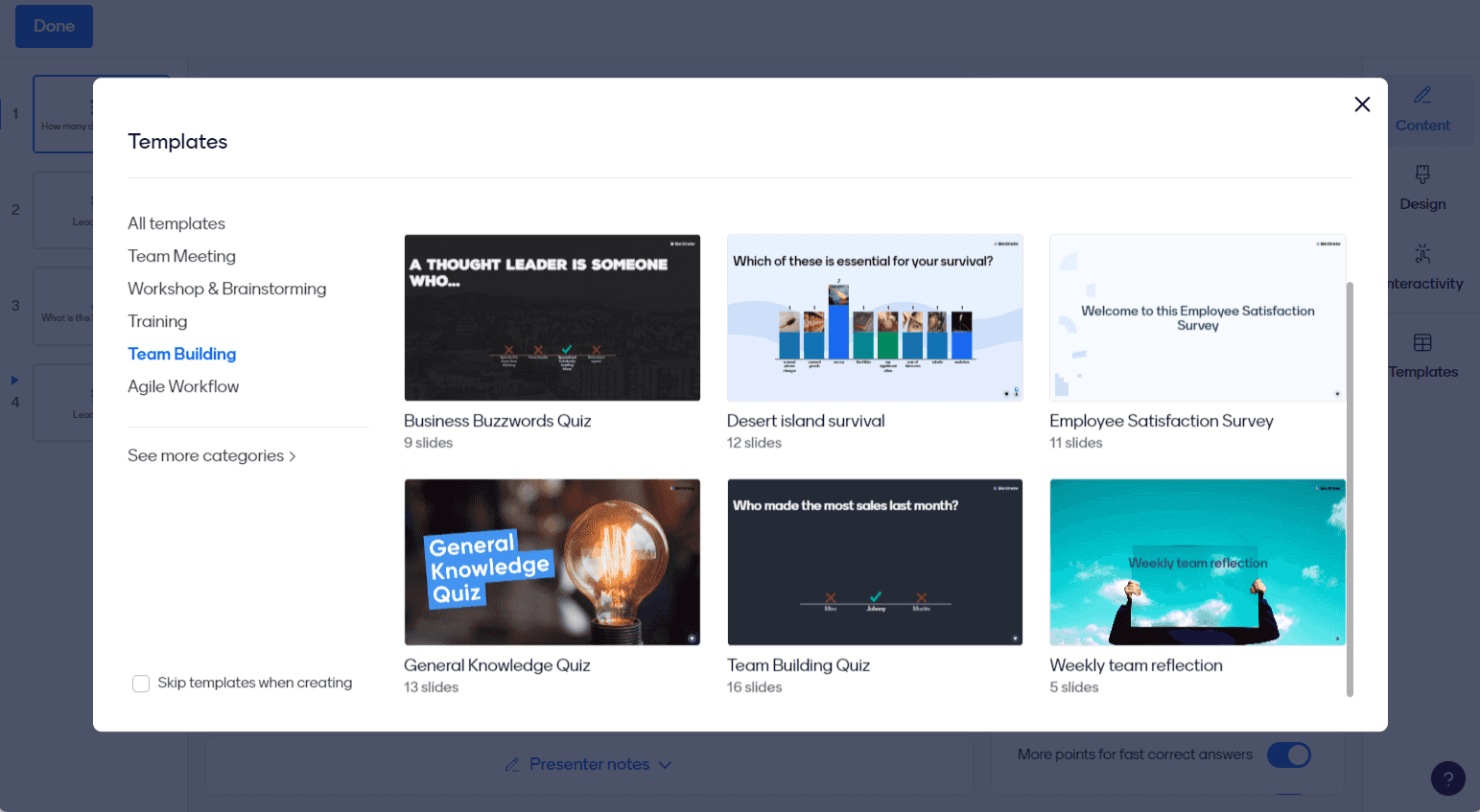
Wooclap 's has over 50 templates in its public event library . They cover multiple areas like education, business & training, co-creation, feedback, knowledge evaluation, and icebreakers.
There's also an Examples gallery if you're looking for ideas to add to an existing event quickly.
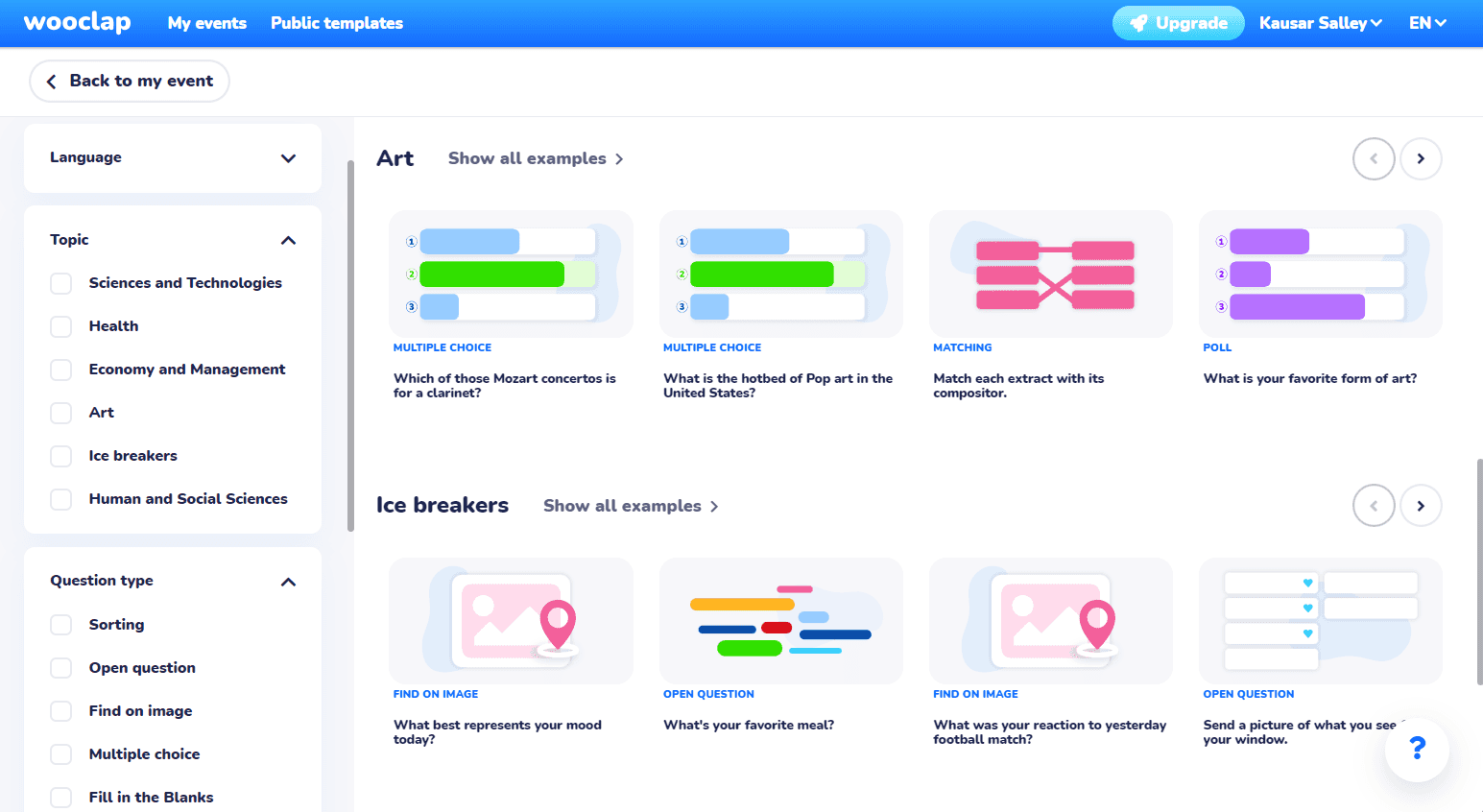
Like Wooclap, Poll Everywhere has over 50 templates for all its question types.
While most are business-focused—think events, interactive meetings, and conferences—they have a few education and medical practice options as well. But we found it inconvenient that you can’t access Poll Everywhere’s templates from the account dashboard. Instead, you have to import them from the template gallery on the company’s website.
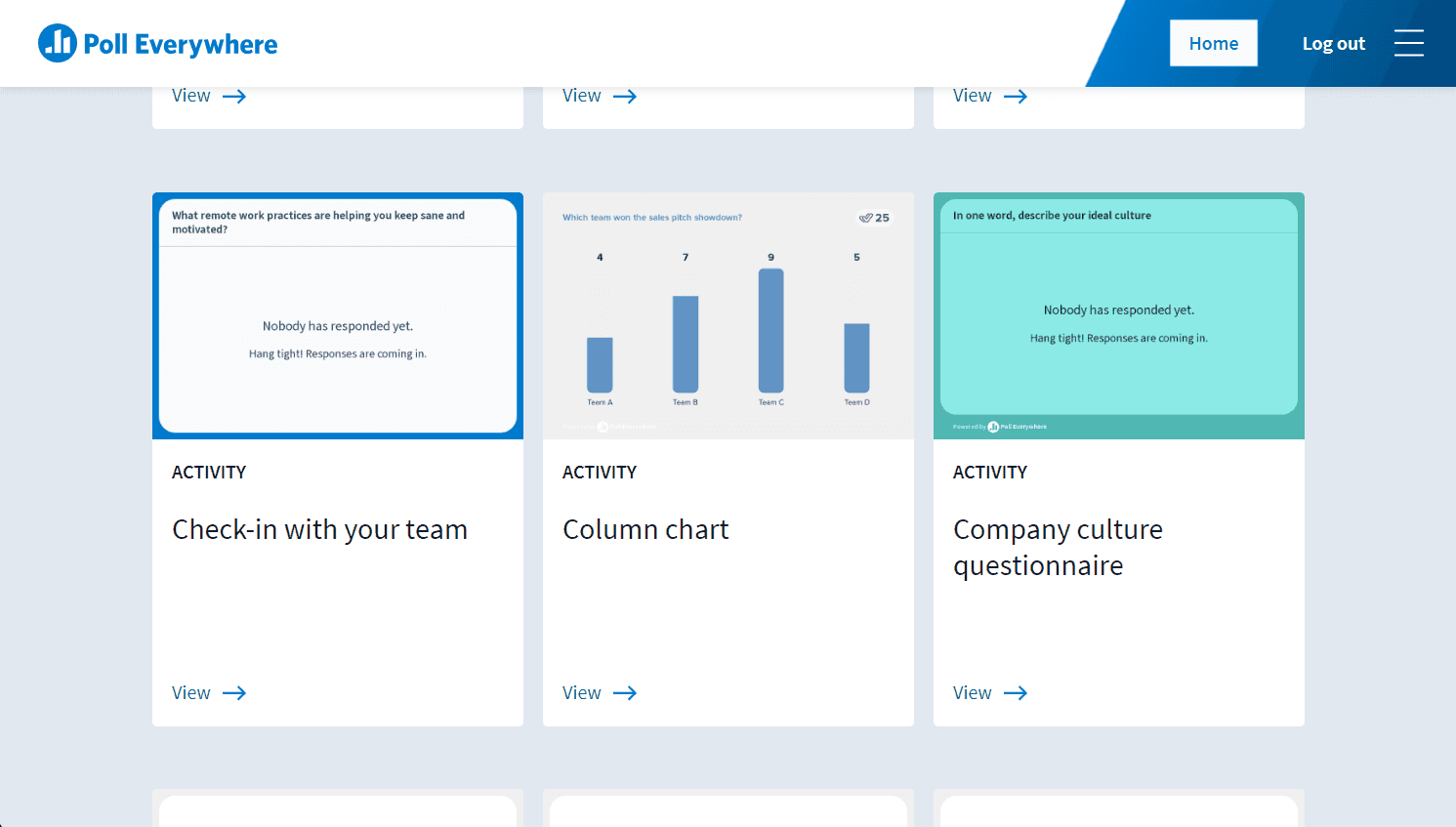
Wooclap's unique and diverse question types, robust and easily accessible templates, and gamified but professional features make it perfect for both higher education and business use cases.
Poll Everywhere vs Mentimeter vs Wooclap: Integrations
Poll everywhere integrates with presentation packages and online meeting apps..
Poll Everywhere integrates with MS PowerPoint, Google Slides, and Apple Keynote to import slides into your presentation. It also supports Microsoft Teams, Slack, Webex, and Zoom for lectures and business meetings.
Poll Everywhere has learning management system (LMS) support, allowing you to connect with other learning platforms that support the LTI standard . You can also respond to activities from your phone or tablet using the Android or iOS app.
Mentimeter integrates with PowerPoint, MS Teams, and Zoom.
Mentimeter has a PowerPoint plug-in for importing slides into the event designer, making it easy to create interactive presentations.
It also integrates with Microsoft Teams, Hopin, and Zoom, which is useful for corporate environments and K-12 education where these apps are commonly used.
Wooclap has the most numerous and diverse integrations.
Wooclap integrates with PowerPoint, Google Slides, 360Learning, Keynote, Genially, Zoom, and Microsoft Teams but doesn't support Hopin yet.
Like Poll Everywhere, Wooclap's strength is its learning management system (LMS) support.
It integrates with Moodle, Blackboard, Canvas, BrightSpace, and other learning platforms that support the LTI standard. This means instructors can incorporate Wooclap's interactive activities into their courses and assess results directly inside the student's grade books.
Wooclap also integrates with eduGAIN, a simple, secure single sign-on service that grants access to thousands of educational services worldwide.
Wooclap has 11 integrations, including presentation and LMS tools, which help instructors during lectures and with other aspects of the modern teaching experience like assessments and grading.
Poll Everywhere vs Mentimeter vs Wooclap: Pricing
Poll everywhere, mentimeter, and wooclap offer free plans..
Poll Everywhere 's free plan allows for unlimited users and lets you create unlimited questions. However, you can only have a maximum audience size of 25 people per activity. There's an option to reset responses, after which another set of 25 participants can partake in the activity.
Mentimeter 's free version has no limits with question types and you can have 50 participants per month.. Participants represent the total number of people who have voted across all your presentations. Once you hit the limit, you can't host any event until the next month.
Wooclap 's free plan unlocks all question types and gives you access to unlimited events. However, it only allows you to add two questions per event.
Where Wooclap shines is its allowance for up to 1,000 participants per event compared to Poll Everywhere's 25 per activity and Mentimeter’s 50 per month. Also, Mentimeter doesn’t let you import slides on the free plan, while the other two do.
Poll Everywhere gives you larger audiences and other features.
Poll Everywhere has three main pricing plans for business & non-profit organizations , higher education institutions , and K-12 institutions .
| Present | Engage | Teams | Enterprise |
| 700 max audience size + Email support | Everything in Present + Extra user + Report creation + Restrict & moderate responses | Everything in Engage + Extra user + Custom branding + Phone support + Custom URL | Everything in Teams + Custom max audience + Success manager + SSO |
| Individual instructor | Student pays | Department-wide | University-wide |
| 700 max audience size + Email support + Report creation | Audience based on class size + Email support + Report creation | 700 max audience size + Phone & email support + Report creation | Department-wide + Custom audience size + Success manager + LMS integration |
👉 Overall , Poll Everywhere’s expensive pricing compared to Mentimeter and Wooclap makes it more suited to very large companies and institutions.
Mentimeter offers unlimited participants across paid plans.
Mentimeter has two pricing models for Individuals or teams and Teachers and students (30% to 40% cheaper).
| Basic | Pro | Enterprise | |
| Unlimited participants + Import slides + Export results to Excel | Everything in Basic + Custom branding + Team collaboration | Everything in Pro + Single Sign-On (SSO) + Success manager | |
👉 Overall , Mentimeter’s plans are cheaper than Poll Everywhere and around the same range as Wooclap, but higher plans don’t unlock as many features as Wooclap.
Wooclap unlocks unlimited questions and offers the best value for money.
Wooclap's pricing structure is similar to Mentimeter, with about the same discounted rates for teachers and students. However, while the number of events is unlimited, Wooclap limits the number of participants to 1,000 on the Basic and Pro plans.
| Basic | Pro | Enterprise | |
| Unlimited questions + Export to Excel and PDF + Participant pace questionnaires | Basic + Custom branding + SMS voting + Team collaboration | Pro + Unlimited participants + LMS integration + SSO + Dedicated support | |
👉 Overall , Wooclap’s pricing structure offers the right balance between cost and features, making it ideal for both small and large institutions.
Poll Everywhere and Wooclap also offer one-time use plans.
Poll Everywhere 's one-time event plan has three levels: Lite , Plus , and Pro .
| Events Lite | Events Plus | Events Pro |
| Unlimited questions + 1000 max audience size + Email support | Everything in Lite + 1000+ max audience size + Phone support + Multiple user profiles | Everything in Plus + 5000+ max audience size + Professional onboarding |
Like Poll Everywhere, Wooclap 's one-time event plans also have three levels. However, they're significantly more affordable.
| Basic | Pro | Premium |
| Unlimited questions + 150 participants + Excel & PDF file export + Email & chat support | Everything in Basic + 250 participants + SMS + Moderator + Collaboration + Custom theme | Everything in Pro + 1000 participants + Single Sign-On (SSO) + LMS support + Phone support |
Wooclap . Like Poll Everywhere, the plans are suitable for teams of all sizes, unlocking key features to support the learning experience. But, it's also more affordable.
Poll Everywhere vs Mentimeter vs Wooclap: Pros & Cons
| Poll Everywhere Pros | Poll Everywhere Cons |
| Unlock all question types on the free plan | Free plan is limited to 25 participants/activity |
| Create up to 23 different activities | No slide reactions or comments |
| Competition mode for active engagement | Few quiz-type questions |
| Create detailed engagement reports | Costly plans |
| Integrate with presentation, meeting, and LMS tools | |
| Mentimeter Pros | Mentimeter Cons |
| Unlocks all question types on the free plan | Free plan is limited to 50 participants/month |
| Set up slide reactions with five emojis | Can’t import slides on free plan |
| View presenter notes with Mentimote | Few templates and native integrations |
| Auto-save questions asked during events | Can’t track detailed performance with reports |
| Add images and GIFs from the native library | |
| Get overall and question-specific participation rates | |
| Wooclap Pros | Wooclap Cons |
| Host up to 1,000 participants on the free plan | Free plan is limited to 2 questions per event |
| Create quizzes with 21 question types | Can’t view presenter notes on mobile device |
| Use competitive mode for active engagement | |
| Categorize messages in the presenter view | |
| Track lessons and activities with a timer | |
| Send performance reports to your audience | |
| Connect with presentation, video conferencing, and LMS tools | |
Final Verdict: Poll Everywhere vs. Mentimeter vs. Wooclap
| Poll Everywhere | Mentimeter | Wooclap |
| Presenters who need a quick and easy platform for creating interactive webinars and gathering feedback. | Professionals who need presentation software to encourage audience participation during business meetings. | Higher education lecturers and professional instructors who want to boost active participation and knowledge retention during teaching sessions. |
Poll Everywhere ’s diverse question types and robust reports are perfect for presenters looking to create interactive webinars on the fly, gather audience responses, and collect feedback. Despite its LMS integration, it falls short for educators and trainers due to the lack of live interactive features, few quiz-type questions, and pricy plans. Mentimeter ’s question types, interactive tools, and participation reports are ideal for professionals aiming to engage audiences, gather feedback, and test basic knowledge. Meanwhile, Wooclap ’s diverse question types, LMS integrations, and detailed reports make it easy for higher education lecturers and professional instructors to create comprehensive assessments while tracking performance across the board.
Use Poll Everywhere if:
- You want to create interactive webinars easily.
- You want to engage audiences and gather feedback during meetings.
- You want to create detailed participation, engagement, and performance reports.
Click here to get started with Poll Everywhere!
Use Mentimeter if:
- You want to improve engagement during business events.
- You want to gather your audience’s thoughts and test basic understanding.
- You’re more focused on gauging and improving participation rather than performance.
Click here to get started with Mentimeter!
Use Wooclap if:
- You’re a lecturer, instructor, or teacher demonstrating complex topics.
- You want the flexibility to engage your audience on complex and diverse concepts during events.
- You want to gain an in-depth insight into your audience’s understanding so you can adapt your teaching methods and provide valuable feedback.
Click here to get started with Wooclap!

The Wooclap team
Make learning awesome & effective

Kahoot vs Slido vs Wooclap: A Definitive Comparison for 2024

Poll Everywhere vs Kahoot vs Wooclap: Which Is Best for Online Learning in 2024?
Poll Everywhere vs Kahoot: Definitive Comparison [July 2024]

What's new at Wooclap [2024]
Discover what's new at Wooclap in 2024
A monthly summary of our product updates and our latest published content, directly in your inbox.
Greening countries, regions and cities
The OECD is working with member and non-member countries to support progress towards environmental and sustainable development objectives at the local, regional and national level. Analysis specific to a country or region facilitates tailored environmental policies and strategies to address their unique challenges and opportunities. Insights and lessons learned also provide best practices for others to draw from.
- Environment at a Glance in the EU Eastern Partnership Countries
- Environment at a Glance in Latin America and the Caribbean

Select a language
Key messages, environmental performance reviews.
The OECD Environmental Performance Reviews provide an independent, evidence-based assessment of countries’ progress towards their environmental objectives. Covering OECD members and selected non-member countries, they document good practices and provide practical recommendations to support countries in their efforts to strengthen policies that contribute to environmental goals and sustainable growth.
The OECD review team analyses the environmental performance of a given country over time. It draws on a broad range of expertise and cross-country economic and environmental data using key analytical questions.
Environmental Performance Reviews of Chile, the Slovak Republic and Egypt were published in 2024. Reviews of Japan and Sweden are planned for release in 2025.
- Greening Eastern Europe and Central Asia
Many countries of the Eastern Europe, Caucasus and Central Asia (EECCA) region have set and updated national targets to guide their transition towards a green economy, including on environmental protection, climate change and natural resource management.
The OECD supports countries of the EECCA region in developing policies that improve environmental quality and social well-being, while creating opportunities for strong economic growth and decent jobs. This work is carried out under the GREEN Action Task Force which is a unique platform of EECCA countries and development co-operation partners to exchange best practice and experience on key environmental and green growth policies, to upgrade these policies and institutional capacities for environmental management and to promote green investment.
Greening Latin America and the Caribbean
The Latin America and Caribbean (LAC) region is home to 40% of the world’s biodiversity and one third of global fresh water sources. Having been struck over the past decades with increasingly extreme weather events, including flooding, hurricanes and prolonged drought, LAC has proven to also be one of the world’s most vulnerable regions to the effects of climate change.
Through its LAC Regional Programme (LACRP), the OECD supports regional efforts in the implementation of environmental sustainability initiatives and the advancement of the 2030 Agenda for Sustainable Development.
Greening Southeast Asia and China
Southeast Asia is one of the most dynamic and diverse regions in the world, with a growing influence on the world economy and an ambitious regional integration roadmap.
The OECD Southeast Asia Regional Programme (SEARP) supports the region in its domestic priorities, policy reforms and regional integration efforts. Its structure is designed to encourage a systematic exchange of experience to develop common solutions to regional and global policy challenges.
Southeast Asian countries participate in the OECD’s work on environment-related issues such as clean energy, biodiversity, climate change, water, waste and marine plastic pollution.
Progress with the deployment of renewable energy is mixed across the EU’s Eastern Partnership countries
While Moldova, Georgia and Armenia approach or surpass the EU average, Azerbaijan and Ukraine lag significantly behind. Though solar and wind are growing in importance in the region, and deployment has neared EU averages in a few countries in the region, hydropower remains the most important source in the renewable electricity mix. This is especially the case in Georgia (up to nearly 80%), in Armenia (over 60%) and Azerbaijan (about 50%). In Moldova and Ukraine, biofuels hold the largest share of renewables in overall energy production, with a significant amount used for heating.
Countries experienced an average increase in surface temperature in the Latin America and Caribbean region
Over the past decades, population exposure to heat stress has increased significantly. In 2019‑21, LAC countries experienced an average increase in surface temperature of around 0.6°C compared to the 1981-2010 average. Temperature increases were higher in Central America (+0.85°C on average) and more modest in the Caribbean (0.5°C). Guatemala and Belize experienced the highest increases of over 1°C.
The number of animal and plant species identified as endangered is increasing in most OECD countries
Pressures on biodiversity are increasing. Many natural ecosystems have been degraded, limiting the services they provide, and many animal and plant species are threatened by habitat alteration or loss, both within and outside protected areas (e.g. on farms and in forests). In most OECD countries, the number of animal and plant species identified as endangered is increasing, particularly in countries with a high population density, and a high level of concentration of human activities.
Related data
Related publications.

Programmes of work
- GREEN Action Task Force Platform to support a transition towards net-zero and green economy in the region of Eastern Europe, the Caucasus and Central Asia (EECCA). Learn more
- Regional and National Policy Dialogues on water The OECD works with selected regions and countries to facilitate the reform of water policies through a series of Regional and National Policy Dialogues. Learn more
- Water-Energy-Land Use Linkages Nexus solutions for a climate resilient Central Asia will promote sustainable development in countries of the region by embedding synergetic, nexus-focused strategic policy and investment planning that enhances economic opportunities while minimising negative environmental and social impacts. Learn more
- Sustainable Infrastructure Programme in Asia The Sustainable Infrastructure Programme in Asia (SIPA) aims to help selected Central and Southeast Asian countries scale up energy, transport and industry infrastructure investments, and shift them towards infrastructure projects consistent with low-emission, resilient development pathways and the Sustainable Development Goals. Learn more
Related policy issues
- Finance and investment for environmental goals
- Cities, climate and development
- Environmental country reviews
- Greening Latin America

News Details
Harley-davidson, inc. to report second quarter results on july 25, 2024.
Webcast Conference Call Scheduled for 8 a.m. CDT
MILWAUKEE , July 3, 2024 /PRNewswire/ -- Harley-Davidson, Inc. (NYSE: HOG) will release its second quarter 2024 financial results before market hours Thursday, July 25, 2024. The public is invited to attend an audio webcast from 8-9 a.m. CDT. Harley-Davidson, Inc. senior management will discuss financial results, developments in the business, and updates to the Company's outlook. A slide presentation supporting the discussion will be available prior to the audio webcast.
Webcast participants should log-on and register at least 10 minutes prior to the start time and can access the slide presentation here: https://investor.harley-davidson.com/events-and-presentations/default.aspx . A replay of the audio webcast will be available approximately two hours after the call concludes.
Company Background Harley-Davidson, Inc. is the parent company of Harley-Davidson Motor Company and Harley-Davidson Financial Services.
### (HOG-Earnings)

SOURCE Harley-Davidson, Inc.
Multimedia Files:

- follow us on facebook
- follow us on twitter
- follow us on linkedin
- follow us on youtube
Harley-Davidson, Inc. Investor Relations
3700 West Juneau Avenue Milwaukee, Wisconsin 53208
contact us by phone, 877-HDSTOCK (437-8625) (toll-free) 414-343-4782 -->
Email Alerts
To opt-in for investor email alerts, please enter your email address and select at least one alert option. After submitting your request, you will receive an activation email to the requested email address. You must click the activation link in order to complete your subscription. You can sign up for additional alert options at any time.
At Harley-Davidson, Inc., we promise to treat your data with respect and will not share your information with any third party. You can unsubscribe to any of the investor alerts you are subscribed to by visiting the ‘unsubscribe’ section. If you experience any issues with this process, please contact us for further assistance.
By providing your email address, you are providing consent to Harley-Davidson, Inc. to send you the requested Investor Email Alert updates.
| * |
| * | ||||||
Email Alert Sign Up Confirmation
 |
IMAGES
VIDEO
COMMENTS
Here are 3 creative ways to summarize your presentations. 1. Use a quiz format to summarize a training presentation: There can be many variations to this. Some presenters choose to show just the title and ask the participants to recollect the content. Some choose to use fill in the blanks format or true/false format to test the memory.
Step 1: Review the Entire Presentation. Start by going through the entire PowerPoint presentation. Reviewing the presentation in its entirety allows you to get a sense of the overall flow and the key themes. Pay attention to the title slides and the concluding slides, as they often contain the main message and summary points.
A presentation summary is an essential part of a talk, providing a brief and clear overview of the main points and key takeaways for the audience. It condenses the speaker's ideas and any critical conclusions or recommendations, so the audience can easily understand and remember the presentation.
5. Include a Compelling Call to Action. A compelling call to action at the end of your presentation summary is crucial in motivating your audience to take the desired next steps. To ensure effectiveness, it's essential to be specific and concrete, leaving no room for ambiguity.
Filed under Business • February 25th, 2024. Business Presentation: The Ultimate Guide to Making Powerful Presentations (+ Examples) A business presentation is a purpose-led summary of key information about your company's plans, products, or practices, designed for either internal or external audiences.
An executive summary slide is a one- or two-page overview of a much longer presentation added to the start of a deck. The goal is to provide a reader with the main messages, so they don't have to read the entire communication. Executive summary slides often retain the horizontal orientation of the rest of the slide deck.
2. Craft An Outline. Just like the presentation, you should create an outline for your summary, too. It will help you align what you seek to present from all the content. Collect your thoughts, take notes, and create a logical sequence that best defines the gist of your business presentation.
When to write a summary. Step 1: Read the text. Step 2: Break the text down into sections. Step 3: Identify the key points in each section. Step 4: Write the summary. Step 5: Check the summary against the article. Other interesting articles. Frequently asked questions about summarizing.
Your executive summary or the presentation is the first thing your viewer would see. Make it worth it by using the tips we mentioned in this article. PowerPoint. Presentation Tips.
Create a Presentation Agenda. To understand what's most important in your presentation, have a presentation agenda ready before starting your summary slide. Then, in your summary slide, ensure that the larger presentation agenda is being conveyed through a reiteration of focal points made throughout the presentation to that effect, communicating your core message to the audience.
7. Give A Summary. Finally, give a summary of the presentation. This will help to reinforce the key points and takeaways and will help to ensure that everyone has a clear understanding of the information. Conclusion. Summarizing a presentation is an important step in ensuring that your audience has a clear understanding of the information you ...
An executive summary is a vital part of any business presentation. In the broader sense, the executive summary is the brief that precedes a more extended report or presentation and outlines the essence of the entire report. In business environments, an executive summary presentation summarizes the intent of the entire business deck in a concise ...
An executive summary PPT slide gives a quick overview of a more extended presentation, usually at the beginning of a slide deck. It summarizes the main points so readers don't have to review the entire presentation. These slides are more text-heavy because they're meant to be read, not presented live. 2.
Related: 12 Strategies for Making Presentations to Executives What to include in an executive summary An executive summary may include a brief review of the document's main topics. This portion of the document is a summary, so this summary can be brief and focus on the key details. The general rule is to keep your summary around two pages or less.
The point of the summary is to remind the audience about the essential core of the presentation. Concentrate on the major ideas and the argument you made that supported the ideas.. Inform the audience about future work that you are interested in pursuing. The subject matter of a presentation usually has room for growth,development or elaboration.
Executive summary slides help the reader "follow along" with your slide deck. There are a few main benefits: Executive summaries provide context to help the reader understand why the topic of the slide deck is important. Executive summaries communicate the high-level argument before the reader gets into the body of the slide deck.
How to summarize a presentation. 1. Identify the main goal. 2. Write the summary. 3. Use visual aids. 4. Include examples and quotations.
Basic summary slide with main points and contact information on it. The key message of the presentation is highlighted on the right hand side. This summary slide is a little more visual, with the key points still mentioned on the slide. This diagram gives the audience a little more context to the information around it.
30 Example Phrases: How to Conclude a Presentation. 1. "In summary, let's revisit the key takeaways from today's presentation.". 2. "Thank you for your attention. Let's move forward together.". 3. "That brings us to the end. I'm open to any questions you may have.".
The reason presentations are used is that they can, paired with images and graphs, effectively utilize the least amount of text. However, even these need to be summarized frequently because the executives do not have a lot of time to go through an entire presentation.In this post, we will check out some ways to summarize presentations.
A good example of a template is a decktopus template. This presentation tool lets you create slides, create a summary for a presentation, and present your information in an organized and professional manner. Using a template will help you to write a summary for a presentation that is more concise, comprehensive, and data-driven than your own ...
5. Use of charts and graphs. A presentation flooded with raw data and nothing eye-catchy will fail miserably to keep the audience engaged. Charts and graphs come to your rescue when your presentation is data intensive. Data, if presented in the raw form, fails to develop and sustain the target audience's interest.
A summary is a brief and concise account of the main points of a larger body of work. It distils complex ideas, narratives, or data into a version that is quicker to read and easier to understand yet still retains the essence of the original content. ... presentations, and research to highlight key points. Summaries aid in comparing multiple ...
For 15-minute presentations. When preparing for a 15-minute presentation, concise and focused content is key. Aim for around 10 to 15 slides to maintain a good pace, which will fit with the 1-2 minute per slide rule. For 30-minute presentations. A longer presentation gives you more room to delve deeper into your topic.
Summary. The much-anticipated first debate of 2024 between President Joe Biden and former President Donald Trump featured a relentless barrage of false and misleading statements from the two ...
presentation to us saying that they have the engineering reports that says the building is . Page 12 of 12. structurally unsound, and they can't rescue it. They claimed to have a study for it in December, and in March OMB is saying, "Oh, we don't have the engineering studies yet." It's clearly a
SUMMARY 1 Contact: Laban Coblentz [email protected] +33 6 14 16 40 85 Summary of Presentation by Pietro Barabaschi, ITER Director-General St. Paul-lez-Durance, France (3 July 2024) - The ITER Organization convened a press conference on 3 July to provide more details of the project baseline proposal submitted to
After a presentation, you can generate detailed participation summaries and reports that emphasize both engagement and performance. On its own, Poll Everywhere isn't meant for hosting events; for that, it has to be integrated with presentation software. However, it is excellent for creating polls, surveys, and open-ended feedback forms.
Many countries of the Eastern Europe, Caucasus and Central Asia (EECCA) region have set and updated national targets to guide their transition towards a green economy, including on environmental protection, climate change and natural resource management.
Webcast Conference Call Scheduled for 8 a.m. CDT Harley-Davidson, Inc. (NYSE: HOG) will release its second quarter 2024 financial results before market hours Thursday, July 25, 2024. The public is invited to attend an audio webcast from 8-9 a.m. CDT. Harley-Davidson, Inc. senior management will discuss financial results, developments in the business, and updates to the Company's outlook.